December 8th, 2015 What’s Up?
I am feeling a bit better each day. I still have a very long to-do list….


Selling Your Used Gear Through BIRDS AS ART
Selling your used (or like-new) photo gear through the BAA Blog or via a BAA Online Bulletin is a great idea. We charge only a 5% commission. One of the more popular used gear for sale sites charges a minimum of 20%. Plus assorted fees! Yikes. The minimum item price here is $500 (or less for a $25 fee). If you are interested please e-mail with the words Items for Sale Info Request cut and pasted into the Subject line :). Stuff that is priced fairly–I offer free pricing advice, usually sells in no time flat. In the past few months, we have sold just about everything in sight. Do know that prices on some items like the EOS-1D Mark IV, the old Canon 500mm, the EOS-7D, and the original 400mm IS DO lens have been dropping steadily. You can see all current listings by clicking here or by clicking on the Used Photo Gear tab on the yellow-orange tab on the right side of the menu bar above.
After somewhat of a lull, things have been heating up on the Used Gear page recently.
- Kenton Rowe sold his Canon 200-400mm f/4L IS lens with Internal 1.4X Extender in early December for $9799.
- Brent Bridges sold his Canon 600 II for the full asking price, $9799,in early December 2015.
- David Bell sold his Canon 400mm f/5.6L lens yesterday for the full asking price, $699, on the day it was listed!
- Alan and Sara Levine sold their old 300 f/2.8L IS lens in early December for $3175.
- Two Canon 500mm f/4L IS lenses (two) were sold by Pat & Stokes Fishburne for $3799 each in late November, 2015.
- A Canon EOS-1D Mark IV Camera Body was sold by Alice Garland for $1350 in mid-November, 2015.
- Mike Ederegger sold his AF-S Nikkor 200-400mm F/4 G ED VR II in excellent condition for $ 5199 right after it was listed.
- Alan and Sara Levine sold their old five, the Canon 500mm f/4 L IS for $4200 in late August, 2015.
New Listings
Canon 500mm f/4L IS II Lens
Good friend and multiple IPT veteran Michael Gotthelf is offering a near-mint Canon 500mm f/4L IS II lens for yet another BAA record-low price: $7799.00. The sale includes a LensCoat, the lens trunk, the leather front hood, the rear lens cap and strap, and insured shipping via either UPS or FED-EX Ground. Your item will not ship until your check clears unless other arrangements are made.
Please contact Mike by e-mail or by phone at 978-407-0679 (eastern time).
I have used various versions of the 500mm f/4 for more than two decades. They are the world’s most popular super-telephoto lenses. I owned the Series II 500 and regret selling it as the 600 II is so much heavier and bulkier…. With good sharpness techniques most folks should be able to learn to make razor sharp images with this lens and the 2X III TC. It is light enough so that many folks can hand hold it easily both for flight and general bird photography. artie
Canon 200-400mm f/4L IS II Zoom Lens with Internal 1.4X Extender
Good friend and IPT veteran George Golumbeski is offering a used Canon 200-400mm f/4L IS zoom lens with Internal 1.4X Extender in excellent plus to near-mint condition with several extras, for $9450.00. The sale includes all of the original items supplied by Canon including the lens trunk, the lens strap, the Canon E-145C Lens Cap (actually a lens hood made of tough synthetic fabric), the rear lens cap, the ET-120 Lens Hood, a 4th Generation Design CRX-5 replacement foot, the the original Canon foot and screws, a LensCoat (in digital camo), a Don Zeck front lens cover, and insured shipping via UPS Ground. Your item will not ship until your check clears unless other arrangements are made.
Please contact George via e-mail or by phone at 1-973 216 3832 (Eastern time zone).
The 200-400 is a killer lens when you are working with tame birds or large mammals; can you say the Galapagos, Africa, South Georgia and the rest of the great Southern Ocean locations, Florida, or La Jolla? I have owned and used this lens since its release. artie
Canon 100–400mm f/4.5–5.6L IS Zoom Lens
Doug Rogers is offering a used Canon 100–400mm f/4.5–5.6L IS zoom lens (the old 1-4) in excellent condition for yet another record-low price: $649. The sale includes the front and rear lens caps and insured shipping via UPS Ground. Your item will not ship until your check clears unless other arrangements are made.
Please contact Doug via e-mail or by phone at 1-434-973-7634 or 1-434-409-8156 (Eastern time zone).
The old 100-400 was and is superb. I made hundreds of sale-able images with mine including the image used on the front cover of Scott Weidensaul’s “Return to Wild America”. Contrary to reports by the internet idiots the lens is–in competent hands–sharp at all focal lengths. It is extremely versatile and would make a great starter lens for those interested in bird, wildlife, and general nature photography. artie
Price Drops!
Canon 400mm f/4 IS DO Lens
Another Lowest-ever BAA Price!
Price Reduced $500 on DEC 7, 2015.
Good friend and multiple IPT veteran Michael Gotthelf is offering a used, super-sharp copy of the Canon 400 mm f/4 IS DO lens in excellent condition (with just a bit of paint wear), now for only $2750.00. The sale includes the lens trunk and key, the leather front lens cover, the rear lens cap and strap, and a RRS lens plate. The sale also includes insured shipping via either UPS or FED-EX Ground. Your item will not ship until your check clears unless other arrangements are made.
Please contact Mike by e-mail or by phone at 978-407-0679 (eastern time).
I used this lens for several years with great success, especially for birds in flight and while working from various type of water craft. In addition, it would make a great prime super-telephoto lens for folks with a 7D II. Gannets in Love was created with the 400 DO. You can see that one and 13 other killer images that I made with my old 400 DO here. The title of that blog post is “The Canon 400mm f/4 IS DO Lens: Fourteen Images that Prove that the Internet Experts are Idiots.” Mike’s lens is priced to sell. artie
Canon EF 70-200 2.8 L IS II USM Lens
Yet Another Lowest-ever BAA Price!
Price Reduced $150 on DEC 7, 2015.
Nigel Boon is offering a used Canon 70-200mm f/2.8 L IS II USM lens in Like-new condition (he has hardly used this lens), now for only $1599.00. The sale includes soft case, lens hood, tripod ring, a Wimberley P-20 plate (a $52 value that is perfect for this lens), the front and rear caps, all original packaging and box, and insured shipping via UPS Ground. Your item will not ship until your check clears or other arrangements are made.
Please contact Nigel by e-mail or by phone at 571 216 7465 (until 11pm EST).
The 70-200mm f/2.8L IS lens is amazingly versatile. I have owned and used one for years and made zillions of great images with it. It works well with both the 1.4X II and the 2X III TCs, even with the 7D II! artie
Canon 85mm f/1.2L II USM Lens
Yet Another Lowest-ever BAA Price!
Price Reduced $140 on DEC 7, 2015.
Nigel Boon is also offering a used Canon 85mm 1.2 L II USM lens in like-new condition, now for only $1459.00. The sale includes the front and rear caps, the lens hood, all original packaging and box, and insured shipping via UPS Ground. Your item will not ship until your check clears or other arrangements are made.
Please contact Nigel by e-mail or by phone at 571 216 7465 (until 11pm EST).
The EF 85mm f/1.2L II USM Lens from Canon is a fast, short-medium telephoto lens that delivers superb optical performance. A maximum aperture of f/1.2 makes it the professional’s choice for shooting without flash in low light conditions. The large aperture also provides fine control over depth of field for compelling portrait photography. A floating optical system and high precision aspherical lens element reduce aberrations and contributes to excellent imaging performance even at the maximum aperture. Super Spectra lens coatings minimize reflections, reducing flare and ghosting. It sells new for $1899. B&H
Featured Item
Canon EOS-1D Mark IV professional digital camera body
Friend and multiple IPT veteran Larry Master is offering a Canon EOS-1D Mark IV professional digital camera body in excellent condition for $1399. The sale includes the original box, the camera manual, the front cap, all cables and CDs, and insured shipping by UPS Ground to US addresses only. Personal checks only; your camera will be shipped only after your check clears.
Interested folks may contact Larry on his cell phone at 518-645-1545 or via e-mail.
Two rugged 1D Mark IVs served as my workhorse professional bodies for several years. artie
|
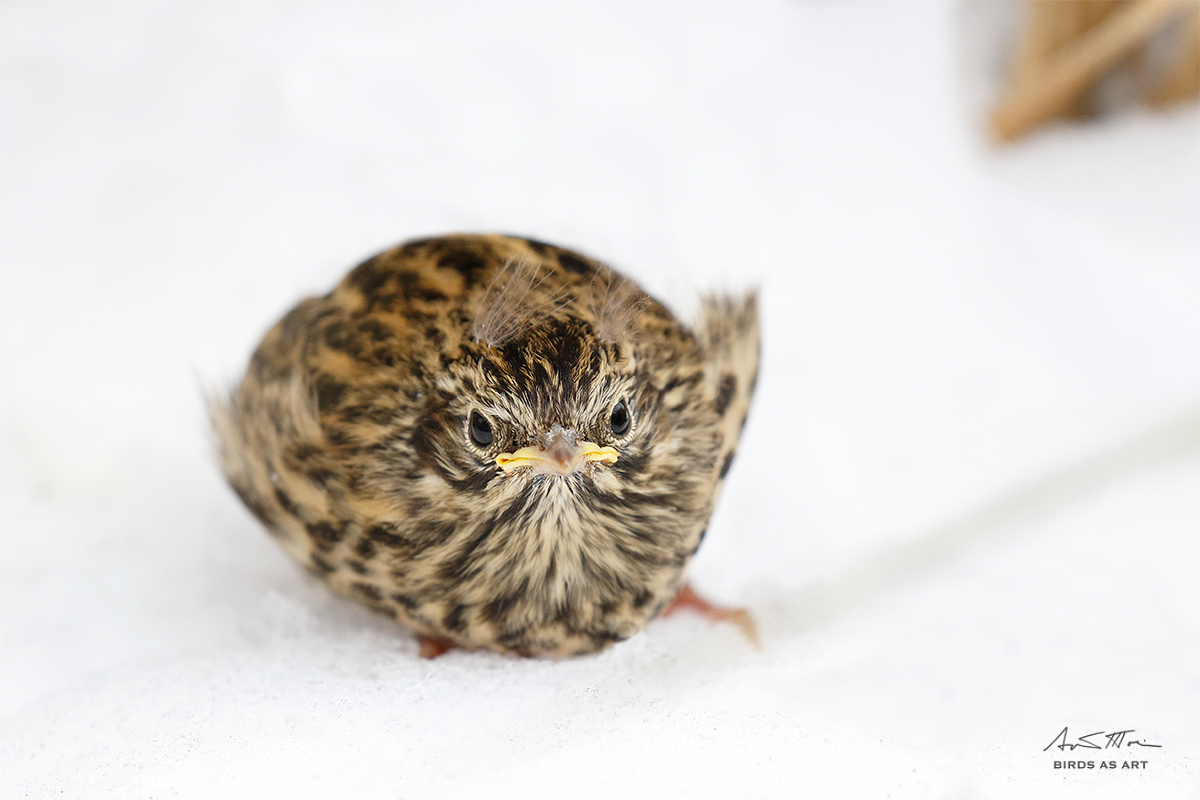
|
|
This image was created on one of my very favorite South Georgia landings, Fortuna Bay, with the hand held Canon EF 100-400mm f/4.5-5.6L IS II USM lens (at 400mm) and the amazing Canon EOS 7D Mark II. ISO 800. Evaluative metering +1 2/3 stops: 1/1000 sec. at f/8 in Manual mode.
Center AF point (Manual selection)/AI Servo/Rear Focus AF as originally framed was active at the moment of exposure (as is always best when hand holding). The selected AF point fall between the right side of the bird’s beak and its right eye. Click here to see the latest version of the Rear Focus Tutorial. Click on the image to see a larger version.
South Georgia Pipit waiting in the snow to be fed
|
Belligerent Little Bugger: Fledgling South Georgia Pipit
The near-threatened South Georgia Pipit is a rare passerine species that nests on South Georgia and small adjacent islands. It is the southernmost breeding songbird in the world. The major threat is the Norway brown rat that eats both its eggs and its chicks. The South Georgia Pipit Heritage Trust recently completed a five-year rat eradication project on South Georgia that was at least five times larger than any other rodent eradication area ever tackled worldwide. Results were quite excellent; the South Georgia government and the Heritage Trust believe that the eradication was 100% successful and will monitor the island for a second year to check for any sign of mice or rats.
If the operation was completely successful, the island could be rodent-free for the first time in more than 200 years. That is good news for the South Georgia Pipits and for other Tussock grass-nesting species such as South Georgia Pintail. The rats do not go after any penguin eggs or young but they are death on all the burrow nesting petrels and they may have had a negative impact on albatross as well. We expect everything from White-chinned Petrels on down to grow substantially in numbers. (Ted Cheeseman/personal comment.)
The Image
Cheesemans’ has a slew of great staff leaders on their Southern Ocean expeditions. I met Joe Kaplan several years ago on a CES voyage and we became fast friends. He is an expert birder, has tremendous enthusiasm for seabirds along with his running mate Dave Shoch, and is a skilled zodiac driver, one of my favorites. Joe found this fledgling pipit, searched me out, brought me to the area, found the bird for me, explained its behavior, and positioned me perfectly to get some good images without disturbing the bird.
How good does it get?
On five previous visits to South Georgia I had never gotten even a single lousy image of this rare species.
Fledgling songbirds often look belligerent because of their gapes which give them a thick-lipped look. No worries, they are shy and timid. Thanks a stack to Joe for his kindnesses over the years.
Why such a high shutter speed? The wind was howling. When I made this image I was just a bit more than a meter from the subject; the close focusing ability of the 100-400 II is simply amazing. I stand by my statement that it would be possible to do a Southern Ocean trip with only the new 1-4 and a 7D II. Along with a 1.4C III TC in your Xtrahand vest pocket….
|
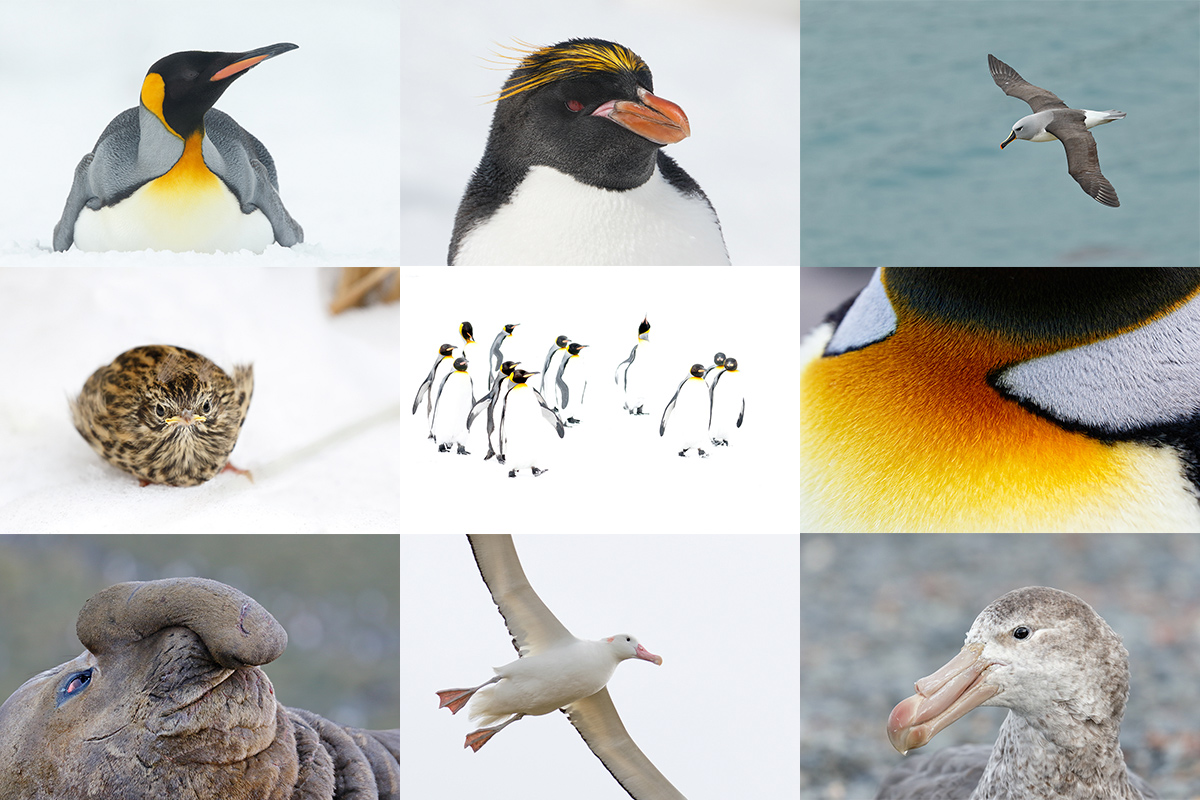
|
|
All images on the card were created on the 2015 Cheesemans’ South Georgia Expedition. From top left clockwise to center: King Penguin resting on Snow, Fortuna Bay; Macaroni Penguin in snow, Cooper Island; Grey-headed Albatross, Elsehul; King Penguin neck abstract, Godthul; Northern Giant Petrel, Undine Harbor; adult Wandering Albatross, Prion Island; Elephant Seal, Undine Harbor; South Georgia Pipit fledgling/thanks Joe Kaplan! Fortuna Bay; high key King Penguins in snow, Fortuna Bay.
Card design and all images copyright 2015: Arthur Morris/BIRDS AS ART
|
The Cheesemans’ 2016 OCT/NOV South Georgia/Falklands Expedition
If reading Saturday’s blog post here put a thought in your mind about joining the BIRDS AS ART group on the Cheesemans’ 2016 OCT/NOV South Georgia/Falklands Expedition, please shoot me an e-mail with the words “Cheesemans’ Last South Georgia Expedition” cut and pasted into the Subject Line with any questions or if you wish to receive additional inspiration. This will surely be my last ship-based trip to the Southern Ocean as well.
|
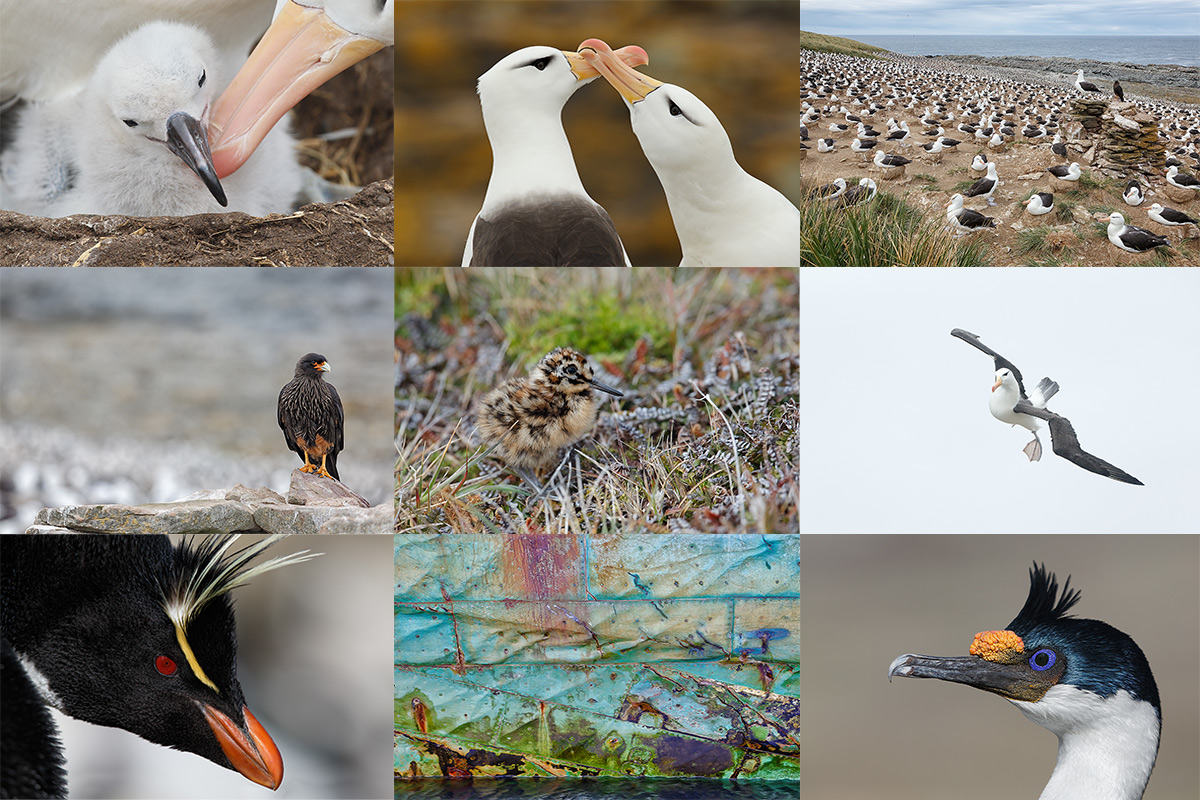
|
|
All of the images on this card were created in the Falklands on the 2014 Cheesemans’ Southern Oceans Expedition. From top left clockwise to center: Black-browed Albatross tending chick, Steeple Jason Island; Black-browed Albatross courting pair, New Island; the Black-browed Albatross colony at Steeple Jason Island; Black-browed Albatross landing, New Island; King Cormorant head portrait, New Island; hull detail/derelict minesweeper, New Island; Rockhopper Penguin head portrait in bright sun, New Island; Striated Caracara, Steeple Jason Island; Magellanic Snipe chick, Sea Lion Island.
|
An Expedition Overview
Experience the vibrant spring of South Georgia, a true Antarctic wildlife paradise. Observe and photograph wildlife behaviors seldom seen beneath the towering, snow blanketed mountains that dominate the island’s landscape. Southern Elephant Seal bulls fight for breeding rights while females nurse young, overlook vast colonies of loafing King Penguins, watch Macaroni Penguins cavort in the snow, photograph handsome Gray-headed Albatrosses in flight or attending to their cliffside nests and awkward Wandering Albatrosses attempting first flight. The itinerary includes six landing days on South Georgia and three landing days in the Falklands to observe too cute Rockhopper Penguins, Magellanic Penguins standing watch at their nesting burrows, and more Black-browed Albatrosses than you could ever imagine. To commemorate Shackleton’s famous self-rescue crossing South Georgia, CES also offers an optional trek retracing his steps. With Cheesemans’ twenty years of experience in the Antarctic region, they commit to an in-depth exploration of one of the densest wildlife spectacles found anywhere in the world, and with only 100 passengers, they routinely give you the opportunity to completely immerse yourself on each landing.
Two of the scheduled Falklands’ landings, New Island and especially Steeple Jason Island, rival the best locations on South Georgia. Those will likely include Salisbury Plain, St. Andrews Bay, Elsehul, Fortuna Bay, and either Cooper Island or Hercules Bay (for Macaroni Penguins).
Why Sign Up Through BIRDS AS ART?
If you have been thinking and dreaming of finally visiting South Georgia, this is the trip for you. There will likely never be another trip like this as the best outfit in the Southern Oceans business will not be returning after 2016…. Quit dreaming and act now. Though I will not be an expedition staff member on this trip, those who have traveled with me know that I cannot help but teach. And I will be doing a introductory photography program for the entire ship on our crossing to South Georgia. All who sign up via BAA will receive a free copy the new Southern Ocean Photography Guide (a $100 value) that I am currently working on. It will include pre-trip gear and clothing recommendations and a ton of info that you will find to be invaluable.
I will hold informal pre-landing briefings aboard ship so that when you land you know exactly what to expect and where to go. I will be available on the ship to review your images, answer your questions, and conduct informal over-the shoulder Photoshop sessions. And best of all, everyone who signs up under the auspices of BAA are invited to tag along with me on the landings where I will be glad to offer invaluable in-the-field advice. And the same goes for the shipboard birds in flight and marine mammal photographic sessions.
Again, if you would like to join me on what will truly be a once in a lifetime opportunity to a wondrous place, please shoot me an e-mail with the words “Cheesemans’ Last South Georgia Expedition” cut and pasted into the Subject Line.
You can learn more about the trip here. If you sign up on your own be sure to mention that you would like to be part of the BAA Group. I’d be glad to answer any and all question via e-mail or by phone at 863-692-0906.
Important Notes
#1: If you fail to e-mail me as noted directly above, and register directly with CES you MUST let them know that you would like to be part of the BIRDS AS ART group.
#2: Joining the BIRDS AS ART group as above will not cost you one penny.
For additional details on the trip and the ship, see Saturday’s blog post here.


Facebook
Be sure to like and follow BAA on Facebook by clicking on the logo link upper right. Tanks a stack!
Typos
In all blog posts and Bulletins, feel free to e-mail or to leave a comment regarding any typos or errors. Just be right 🙂
December 7th, 2015 What’s Up
On Sunday I did more work on the San Diego Exhibit image caption labels and watched a ton of NFL football. By blowing yet another large fourth quarter lead the NY Giants put an end to their season. Bummer.
Stay tuned as tomorrow I will be listing several new Used Photo Gear items and featuring several other items with recently reduced prices.


|
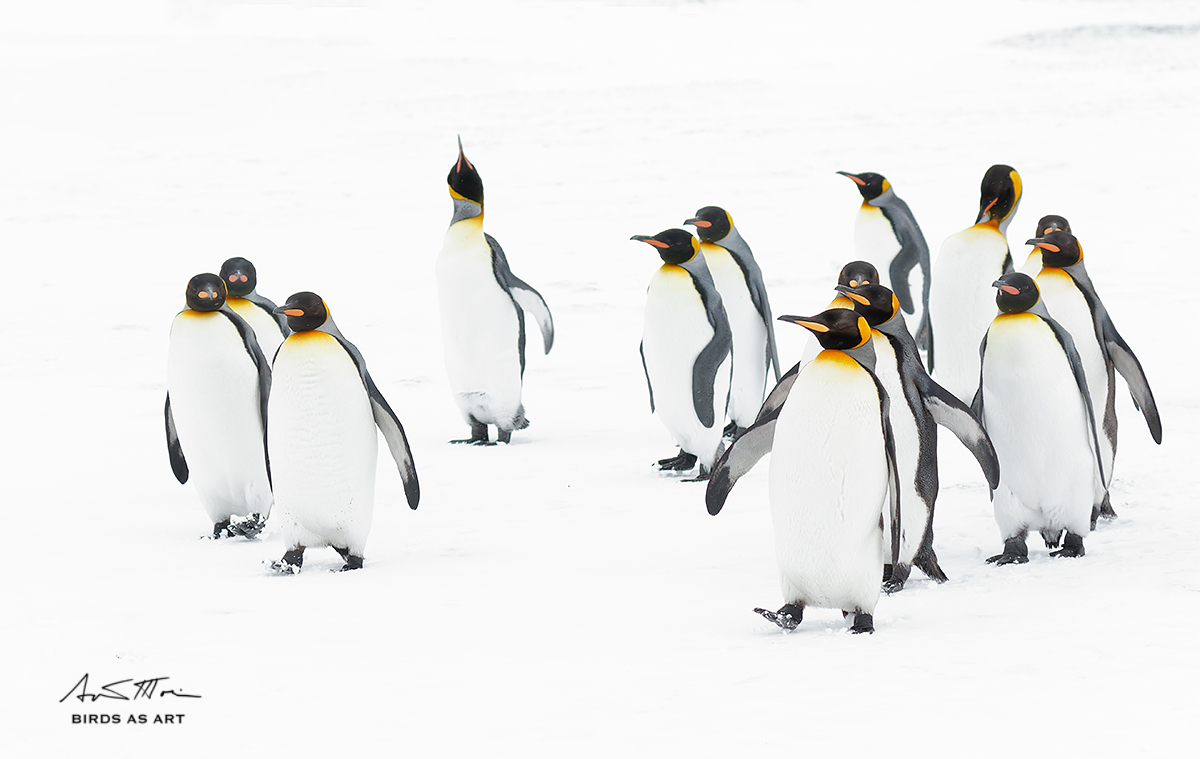
|
|
This image was created on the 2015 Cheesemans’ Southern Ocean Expedition with the hand held Canon EF 100-400mm f/4.5-5.6L IS II USM lens and the amazing Canon EOS 7D Mark II. ISO 400. Evaluative metering +3 stops (was really pushing it…): 1/640 sec. at f/6.3.
The fourth AF point to the right of the center AF point (Manual selection)/AI Servo/Rear Focus AF as originally framed was active at the moment of exposure (as is always best when hand holding). The selected AF point fell on the breast of the closest penguin (on our right). Click here to see the latest version of the Rear Focus Tutorial. Click on the image to see a larger version.
Image #1: 14 King Penguins walking across a snowfield
|
Fortuna Bay
The landing at Fortuna Bay has always been one of my favorites even though the King Penguin colony there does not compare in size or beauty to the colonies at either Salisbury Plain or St. Andrews Bay, the latter hosting more than 300,000 pairs of breeding kings. What’s so good about Fortuna Bay? There is always a large snowfield close to the zodiac landing site.
The First Fortuna Bay Accident…
The text below is adapted from the “Wrecked and Loving It” blog post here. It details the events of my Fortuna Bay landing on the 2012 Cheesemans’ Southern Ocean Expedition.
After an amazing morning of photographing King Penguins in fresh snow I was walking slowly on a clean, flat area of grass just taking in the sights, totally relaxed and not at all in my usual rushed state. My brand new Canon 500mm f/4L IS II and new 1D X were on the tripod that rested on my right shoulder with the lens pointing behind me. My right toe caught on a small rock about the size of my fist. I pitched forward. There was no chance to roll or attempt to protect my gear. I landed gently but the camera hit a half buried rock and was ripped from the lens mount. As I got up and realized that I was OK but that my gear was not. The 1D X was firing continuously though I was not pressing the shutter button. I removed the battery and it quit. I tried without success to mount the camera onto the lens. In short order I realized that both items had seen their last action on the trip.
I remembered that the last thing I had done before leaving for the airport on October 16 was to remove the 70-200 f/2.8 L IS lens from my Think Tank Airport International™ V 2.0 Rolling Camera Bag, place it in one of the large front pockets of my Xtrahand Vest, and put the 300 f/2.8L IS II lens into the rolling bag. Why? “In case anyone wrecks a lens the 300 2.8 II would make a great back-up and provide lots of magnification with the 2X III TC.” I had no idea that that person would be me.
As I walked, still alone, I laughed. I was pretty much uninjured. I joked that I had been hurt worse getting into bed. I knew that the wreck was the very best thing that could have happened. How could I know that? Because it happened. And because I am a lover of what is. (See the work of Byron Katie at www.THEWORK.com.) I did not berate myself. No matter how careful we are accidents can and do happen. Actually, I was able to go lighter for the rest of the expedition and make great images with the 300 II, both TCs, and my back-up 1D Mark IV.
When I got back to the ship and shared my tale most folks commented to the effect that “you must be so upset.” “What a terrible thing to happen at the start of the trip.” I thought to myself, “What a trip that was.” With “trip” as a pun of course. “No,” I said. “It was the best thing that could have happened and lots of good will come of it.” “Happiness is a choice,” I explained while hearing Byron Katie’s voice in the back of my head. “I am in a great place with great people, I have a great back-up rig, and I was not hurt; I am simply choosing happiness. What good would it have done to lament my fate.”
Want more peace in your life? See “Loving What Is; Four Questions That Can Change Your Life” by Byron Katie.
Note: you can see the images I made on that morning by following this link.
|
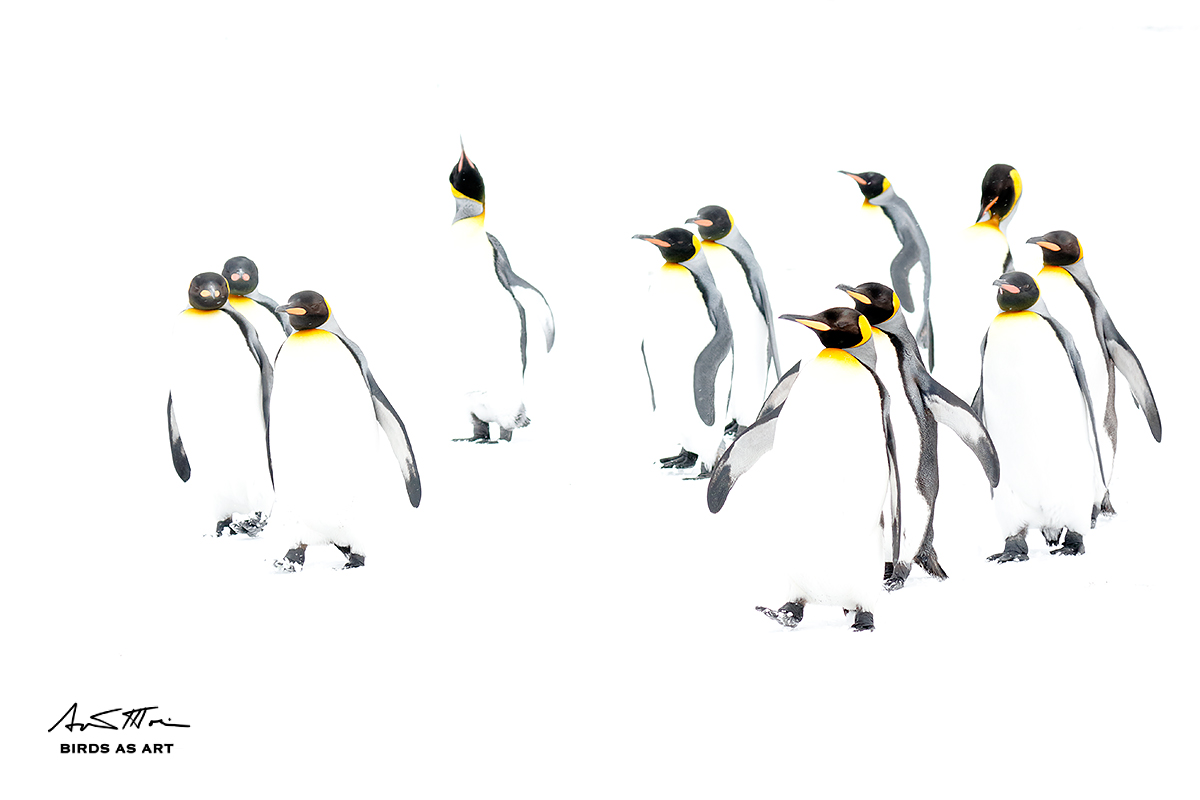
|
|
This image was created on the 2015 Cheesemans’ Southern Ocean Expedition with the hand held Canon EF 100-400mm f/4.5-5.6L IS II USM lens and the amazing Canon EOS 7D Mark II. ISO 400. Evaluative metering +3 stops (was really pushing it…): 1/640 sec. at f/6.3.
The fourth AF point to the right of the center AF point (Manual selection)/AI Servo/Rear Focus AF as originally framed was active at the moment of exposure (as is always best when hand holding). The selected AF point fell on the breast of the closest penguin (on our right). Click here to see the latest version of the Rear Focus Tutorial. Click on the image to see a larger version.
Image #2: only 12 King Penguins walking across a snowfield
|
2015’s Fortuitous Fortuna Bay Accident
On the 2015 Fortuna Bay landing, in my excitement over having yet another chance to photograph King Penguins in the snow, I inadvertently rolled the index finger wheel thus increasing the exposure by about 2/3 stop to the point of blinkies on the birds. After a few frames I checked the histogram, noted my error, and raised the shutter speed to 1/1000 sec.
Once I had the images on the laptop, I realized that my screw-up presented an ideal opportunity to be creative and make a very special mega-high key image, one in which the WHITEs of the penguins breasts would melt into the white snow. While converting to RAW file in DPP 4 I increased the brightness, moved the Highlight slider to the right to make the WHITES whiter, and moved the Shadow slider to the left to -5 to make the BLACKs blacker. Once I brought the TIFF into Photoshop I finished off the look that I wanted with a simple Levels adjustment. I eliminated the two merged penguin heads using the Protective Cloning on a Layer technique taught to me by Denise Ippolito.
I redid the image from scratch on Sunday evening saving the WHITEs during the RAW conversion rather than brightening them as I had done on the first go-round. The result of the re-do is the image that opened today’s blog post.
Your Favorite?
Do let us know which of the two images you prefer, Image #1, the natural look, or Image #2, the mega-high key version made from the same RAW file. And please be sure to let us know why you made your choice.
|

|
|
All images on the card were created on the 2015 Cheesemans’ South Georgia Expedition. From top left clockwise to center: King Penguin resting on Snow, Fortuna Bay; Macaroni Penguin in snow, Cooper Island; Grey-headed Albatross, Elsehul; King Penguin neck abstract, Godthul; Northern Giant Petrel, Undine Harbor; adult Wandering Albatross, Prion Island; Elephant Seal, Undine Harbor; South Georgia Pipit fledgling/thanks Joe Kaplan! Fortuna Bay; high key King Penguins in snow, Fortuna Bay.
Card design and all images copyright 2015: Arthur Morris/BIRDS AS ART
|
The Cheesemans’ 2016 OCT/NOV South Georgia/Falklands Expedition
If reading Saturday’s blog post here put a thought in your mind about joining the BIRDS AS ART group on the Cheesemans’ 2016 OCT/NOV South Georgia/Falklands Expedition, please shoot me an e-mail with the words “Cheesemans’ Last South Georgia Expedition” cut and pasted into the Subject Line with any questions or if you wish to receive additional inspiration. This will surely be my last ship-based trip to the Southern Ocean as well.
|

|
|
All of the images on this card were created in the Falklands on the 2014 Cheesemans’ Southern Oceans Expedition. From top left clockwise to center: Black-browed Albatross tending chick, Steeple Jason Island; Black-browed Albatross courting pair, New Island; the Black-browed Albatross colony at Steeple Jason Island; Black-browed Albatross landing, New Island; King Cormorant head portrait, New Island; hull detail/derelict minesweeper, New Island; Rockhopper Penguin head portrait in bright sun, New Island; Striated Caracara, Steeple Jason Island; Magellanic Snipe chick, Sea Lion Island.
|
An Expedition Overview
Experience the vibrant spring of South Georgia, a true Antarctic wildlife paradise. Observe and photograph wildlife behaviors seldom seen beneath the towering, snow-blanketed mountains that dominate the island’s landscape. Southern Elephant Seal bulls fight for breeding rights while females nurse young, overlook vast colonies of loafing King Penguins, watch Macaroni Penguins cavort in the snow, photograph handsome Gray-headed Albatrosses in flight or attending to their cliffside nests and awkward Wandering Albatrosses attempting first flight. The itinerary includes six landing days on South Georgia and three landing days in the Falklands to observe too cute Rockhopper Penguins, Magellanic Penguins standing watch at their nesting burrows, and more Black-browed Albatrosses than you could ever imagine. To commemorate Shackleton’s famous self-rescue crossing South Georgia, CES also offers an optional trek retracing his steps. With Cheesemans’ twenty years of experience in the Antarctic region, they commit to an in-depth exploration of one of the densest wildlife spectacles found anywhere in the world, and with only 100 passengers, they routinely give you the opportunity to completely immerse yourself on each landing.
Two of the scheduled Falklands’ landings, New Island and especially Steeple Jason Island, rival the best locations on South Georgia. Those will likely include Salisbury Plain, St. Andrews Bay, Elsehul, Fortuna Bay, and either Cooper Island or Hercules Bay (for Macaroni Penguins).
Why Sign Up Through BIRDS AS ART?
If you have been thinking and dreaming of finally visiting South Georgia, this is the trip for you. There will likely never be another trip like this as the best outfit in the Southern Oceans business will not be returning after 2016…. Quit dreaming and act now. Though I will not be an expedition staff member on this trip, those who have traveled with me know that I cannot help but teach. And I will be doing a introductory photography program for the entire ship on our crossing to South Georgia. All who sign up via BAA will receive a free copy the new Southern Ocean Photography Guide (a $100 value) that I am currently working on. It will include pre-trip gear and clothing recommendations and a ton of info that you will find to be invaluable.
I will hold informal pre-landing briefings aboard ship so that when you land you know exactly what to expect and where to go. I will be available on the ship to review your images, answer your questions, and conduct informal over-the shoulder Photoshop sessions. And best of all, everyone who signs up under the auspices of BAA are invited to tag along with me on the landings where I will be glad to offer invaluable in-the-field advice. And the same goes for the shipboard birds in flight and marine mammal photographic sessions.
Again, if you would like to join me on what will truly be a once in a lifetime opportunity to a wondrous place, please shoot me an e-mail with the words “Cheesemans’ Last South Georgia Expedition” cut and pasted into the Subject Line.
You can learn more about the trip here. If you sign up on your own be sure to mention that you would like to be part of the BAA Group. I’d be glad to answer any and all question via e-mail or by phone at 863-692-0906.
Important Notes
#1: If you fail to e-mail me as noted directly above, and register directly with CES you MUST let them know that you would like to be part of the BIRDS AS ART group.
#2: Joining the BIRDS AS ART group as above will not cost you one penny.
For additional details on the trip and the ship, see Saturday’s blog post here.


Please Remember to use our Affiliate Links 🙂
To show your appreciation for my continuing efforts here, we ask, as always, that you use our the B&H and Amazon affiliate links on the right side of the blog for all of your purchases. B&H is recommended for you major photography gear purchases, Amazon for your household, entertainment, and general purpose stuff. Please check the availability of all photographic accessories in the BIRDS AS ART Online Store, especially the Mongoose M3.6 tripod heads, Gitzo tripods, Wimberley heads and plates, LensCoats and accessories, and the like. We sell only what I have used, have tested, and can depend on. We will not sell you junk. We know what you need to make creating great images easy and fun. And we are always glad to answer your gear questions via e-mail. I just learned that my account was suspended during my absence; it should be up and running by Monday at the latest.
I would of course appreciate your using our B&H affiliate links for all of your major gear, video, and electronic purchases. For the photographic stuff mentioned in the paragraph above we, meaning BAA, would of course greatly appreciate your business. Here is a huge thank you to the many who have been using our links on a regular basis and visiting the BAA Online store as well.
Facebook
Be sure to like and follow BAA on Facebook by clicking on the logo link upper right. Tanks a stack!
Typos
In all blog posts and Bulletins, feel free to e-mail or to leave a comment regarding any typos or errors. Just be right 🙂
December 6th, 2015 What’s Up?
I did lots of work on the San Diego exhibit labels and answered lots of e-mails on the Cheeseman’s 2016 South Georgia/Falklands Expedition; we have already signed up three or four folks for the BIRDS AS ART group. Do consider joining us for the trip of a lifetime, my last ship-based trip to the Southern Ocean. If you are interested, see yesterday’s blog post here or shoot me an e-mail with the words “Cheesemans’ Last South Georgia Expedition” cut and pasted into the Subject Line.


Selling Your Used Gear Through BIRDS AS ART
Selling your used (or like-new) photo gear through the BAA Blog or via a BAA Online Bulletin is a great idea. We charge only a 5% commission. One of the more popular used gear for sale sites charges a minimum of 20%. Plus assorted fees! Yikes. The minimum item price here is $500 (or less for a $25 fee). If you are interested please e-mail with the words Items for Sale Info Request cut and pasted into the Subject line :). Stuff that is priced fairly–I offer free pricing advice, usually sells in no time flat. In the past few months, we have sold just about everything in sight. Do know that prices on some items like the EOS-1D Mark IV, the old Canon 500mm, the EOS-7D, and the original 400mm IS DO lens have been dropping steadily. You can see all current listings by clicking here or by clicking on the Used Photo Gear tab on the yellow-orange tab on the right side of the menu bar above.
After a month long lull, there have been more than a few sales over the past few weeks.
- David Bell sold his Canon 400mm f/5.6L lens yesterday for the full asking price, $699, on the day it was listed!
- Alan and Sara Levine sold several of the many items they listed and the sale of their old 300 f/2.8 is pending.
- Two Canon 500mm f/4L IS lenses (two) were sold by Pat & Stokes Fishburne for $3799 each in late November, 2015.
- A Canon EOS-1D Mark IV Camera Body was sold by Alice Garland for $1350 in mid-November, 2015.
- The sale of Brent Bridges’s 600 II is pending.
New Listings
Nikon AF-S NIKKOR 600mm f/4G ED VR Lens
IPT veteran and super-nice guy Bruce Gauger is offering a brand new in the box Nikon AF-S NIKKOR 600mm f/4G ED VR lens (USA),in the factory-sealed box for $7,999. Bruce had a mountain biking accident right after he purchased the lens about 5 years ago….
The sale includes all of the original accessories and paperwork in the unopened box including the USA warranty cards, the front lens lens cover, the LF-4 rear lens cap, the HK-35 lens hood, the CT-607 trunk (hard carrying case), the LN-1 lens Strap, and insured shipping via UPS Ground to continental US addresses only. Your item will not ship until your check clears unless other arrangements are made.
Please contact Bruce by e-mail or by phone at 1-949-892-8590 (Pacific time).
The 600 f/4 lenses are ideal for those who do birds and wildlife. This older version of the Nikon 600 weighs 11.16 lbs. It is still in production and sells new at B&H for $9,394.00. The newer lighter version, the Nikon AF-S NIKKOR 600mm f/4E FL ED VR lens (designated by “E” rather than “G” after the f/4) weighs 8.4 pounds but costs $12,296.95. Thus, Bruce’s lens is a great buy for someone young and relatively strong who would like to save either $1,395.00 or $4297.95, depending on how you look at it. artie
Canon 100-400mm L IS Zoom Lens
Stephen Zarate is offering a used Canon 100-400mm L IS Zoom lens (the old 100-400) in excellent condition (the lens hood shows minor signs of wear) for the BAA record-low price of $650. The sale includes the front and rear lens caps, the tough fabric case, the tripod collar, the original box, and insured ground shipping via UPS ground. Your item will not ship until your check clears unless other arrangements are made.
Please contact Stephen by e-mail or by phone at 949-697-8194 (Pacific time).
The old 100-400 was and is superb. I made hundreds of sale-able images with mine including the front cover of Scott Weidensaul’s Return to Wild America. Contrary to reports by the internet idiots the lens is–in competent hands–sharp at all focal lengths. It is extremely versatile and would make a great starter lens for those interested in bird, wildlife, and general nature photography. artie
Canon 400mm f/4 IS DO Lens
Stephen Zarate is also offering a used Canon 400mm f/4 IS DO lens (the old 400 do) in very good plus condition the record-low BAA price of $2899.00. The lens is covered by a well-worn “digital camo” LensCoat and the tripod ring shows minor signs of wear.
The sale includes the lens trunk, the front and rear lens caps, the leather front lens cover, the aforementioned LensCoat, and insured ground shipping via UPS ground. Your item will not ship until your check clears unless other arrangements are made.
Please contact Stephen by e-mail or by phone at 949-697-8194 (Pacific time).
I used this lens for several years with great success, especially for birds in flight and while working from various type of water craft. In addition, it would make a great prime super-telephoto lens for folks with a 7D II. Gannets in Love was created with the 400 DO. You can see that one and 13 other killer images that I made with my old 400 DO here. The title of that blog post is “The Canon 400mm f/4 IS DO Lens: Fourteen Images that Prove that the Internet Experts are Idiots.” Tom’s lens is priced to sell. artie
|
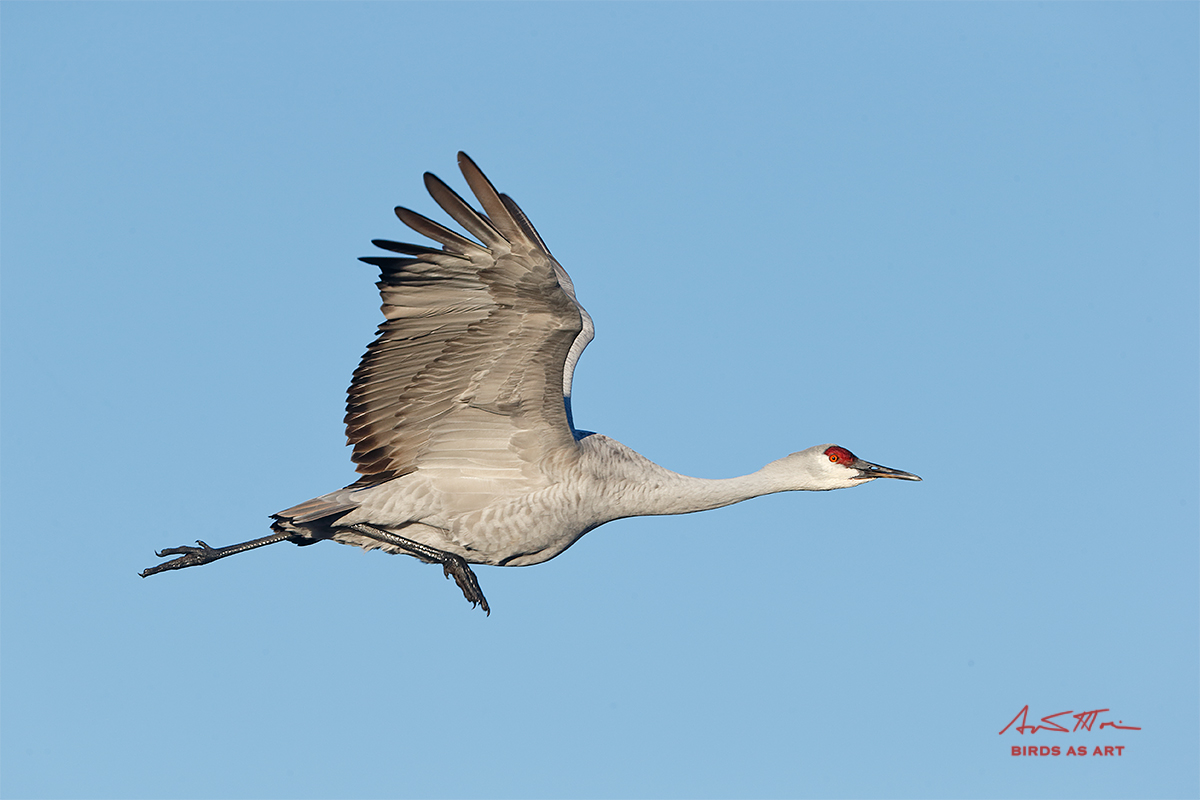
|
|
This image was created on the last morning of the second Bosque IPT with the hand held Canon EF 400mm f/4 DO IS II USM lens, the Canon Extender EF 2X III, and the rugged Canon EOS-1D X. ISO 800. Evaluative metering +2/3 stop off the light blue sky: 1/1000 sec. at f/8 in Manual mode.
Center AF point (by necessity) Expand/AI Servo shutter button AF was active at the moment of exposure as is always best when hand holding. The active AF point fell on the bird’s upper back just where it meets the raised wings, nicely on the same plane as the eye. Click on the image to enjoy a larger version.
|
Going Light for Flight with the 400 DO II, the 2X III TC, and the EOS-1D X
I had packed my 600 II to be shipped back to ILE that night before so I grabbed the 400 DO II, the 2X III TC, and the 1D X. 800mm is a great focal length for the cranes taking off to the north at the standard location. And I actually find hand holding the 400 DO II for flight easier than working with the 600 II off my Induro GIT 304L tripod topped by the Mongoose M3.6. I made lots of sharp images on that last morning.
Do notice the slight look-back-at-me head angle and the fact that I was working almost perfectly on sun-angle….
Running in Place in Flight
I actually saw the bird “running in place” and made two images as I called it out to the group. One had the pancake wing position that I do not like at all but I love the one above with the wings raised a bit. I believe that the bird had both legs tucked into it belly feathers for warmth and decided to let its far leg trail in the normal position, thus the appearance of running in place.
The Bosque Site Guide
If you can’t make or afford a Bosque IPT, or if the holidays preclude your joining one, be sure to get yourself a copy of my Bosque Site Guide. All BAA Site Guides are designed so that with a bit of study you can show up at a great place and know exactly where to be at what time on what wind and in what lighting conditions. And on what wind. With a Site Guide on your laptop you will feel like a 22-year veteran on your first visit. Site Guides are the next best thing to being on an IPT. If you plan on visiting Bosque it would be foolish to make the trip without having this guide in hand. Why spend money on gear and travel and then spend days stumbling around in the wrong spot? If you have visited previously, and are still unsure of where you should be at this time of day with that wind, this guide will prove invaluable to you as well. Even folks visiting Bosque for the tenth time will learn a ton as I share my secrets and hold nothing back….
In the next week or so, I will be working on a 2015 Bosque Current Conditions Guide; it will be send for free to all who have previously purchased the Bosque Site Guide and will also be available as a separate, stand-alone purchase.
Bosque Site Guide Kudos
By e-mail from Paul Shilling
After planning my first trip to Bosque earlier this year, I bought your excellent Bosque site guide. Read through it a couple of times. It is well worth the $50. It helped me get a good feel for the refuge before arriving. Many thanks. I was there last week for a morning and an afternoon. After disappointingly finding almost no birds before and just after sunrise at your suggested location, I enjoyed the cranes flying out at the spot you mention in the guide. Then I went straight to the farm fields in the north loop; they did not disappoint. Your guide led me to each of these spots. Without your guide would have had to guess at my next move. Best, Paul


Please Remember to use our Affiliate Links 🙂
To show your appreciation for my continuing efforts here, we ask, as always, that you use our the B&H and Amazon affiliate links on the right side of the blog for all of your purchases. B&H is recommended for you major photography gear purchases, Amazon for your household, entertainment, and general purpose stuff. Please check the availability of all photographic accessories in the BIRDS AS ART Online Store, especially the Mongoose M3.6 tripod heads, Gitzo tripods, Wimberley heads and plates, LensCoats and accessories, and the like. We sell only what I have used, have tested, and can depend on. We will not sell you junk. We know what you need to make creating great images easy and fun. And we are always glad to answer your gear questions via e-mail. I just learned that my account was suspended during my absence; it should be up and running by Monday at the latest.
I would of course appreciate your using our B&H affiliate links for all of your major gear, video, and electronic purchases. For the photographic stuff mentioned in the paragraph above we, meaning BAA, would of course greatly appreciate your business. Here is a huge thank you to the many who have been using our links on a regular basis and visiting the BAA Online store as well.
Facebook
Be sure to like and follow BAA on Facebook by clicking on the logo link upper right. Tanks a stack!
Typos
In all blog posts and Bulletins, feel free to e-mail or to leave a comment regarding any typos or errors. Just be right 🙂
December 5th, 2015 What’s Up?
I enjoyed a long day of hard work and enjoyed sleeping in my own bed. I still have my cold. Yesterday I did something that I should have done weeks ago: on the advice of Dr. Cliff Oliver I purchased a steam inhaler and inhalant pads (at CVS) and enjoyed three 15 minutes sessions of breathing steam. I am feeling much better already.
Today I am working on image labels for the San Diego exhibit at the Natural History Museum.
|

|
|
All images on the card were created on the 2015 Cheesemans’ South Georgia Expedition. From top left clockwise to center: King Penguin resting on Snow, Fortuna Bay; Macaroni Penguin in snow, Cooper Island; Grey-headed Albatross, Elsehul; King Penguin neck abstract, Godthul; Northern Giant Petrel, Undine Harbor; adult Wandering Albatross, Prion Island; Elephant Seal, Undine Harbor; South Georgia Pipit fledgling/thanks Joe Kaplan! Fortuna Bay; high key King Penguins in snow, Fortuna Bay.
Card design and all images copyright 2015: Arthur Morris/BIRDS AS ART
|
Hard to Believe: An End to the Best…
I have been to the Southern Ocean five times, the last four with Cheesemans’ Ecology Safaris (CES). It is common knowledge that they offer the finest ship-based photographic expeditions to South Georgia and the Falklands. Nobody else is close. They will make landings in tough conditions. Always. Their experienced staff and crew of zodiac drivers will get you on and off safely. You will enjoy so much time on a given landing that you will often want to head back to the ship early! Sorry, not me (though I did go back to the ship an hour early on our 2015 St. Andrews Bay landing. I quit after only 12 1/2 hours to go back to the ship on the 5pm zodiac when I could have stayed till 6pm…. My excuse? I could not raise my lens anymore.)
I learned recently that their October 22-November 6 (on the Sea Spirit) will be their last trip down to wildlife heaven on earth. Here is what Ted Cheeseman had to say:
The 2016 October/November expedition will be our last to South Georgia. Market changes, regulation changes, and as big of a part of our lives as it has been, we realize this next will indeed be the last.
When I asked him if he was sure that the 2016 trip would be the last, he replied:
To be honest, we have been known to go back on our statement of ‘last trip ever’. But for South Georgia, I don’t see how we could do it in the future. We want to continue but the costs are skyrocketing, regulation is threatening in a way that I think after 2016 may very well make it impossible to have free roaming folks ashore, i.e. possibly guided groups only – no thank you. So though I am loathe to say it, the Oct/Nov 2016 trip will be our last. If we do another before the end of 2018, I’ll see to it that you get free passage aboard. How’s that for a commitment?
BIRDS AS ART and the 2016 Cheesemans’ South Georgia/Falklands Expedition
When I got off the Ortelius at Stanley and told Ted that the just concluded voyage would be my last to the Southern Ocean, I meant it. But once I heard that the 2016 trip would be their last, I realized that I had to make the trip. As soon as I sign up a single participant for the expedition’s BAA group, I will be sending my deposit check.
If you would like to join me on what will be an amazing trip to a wondrous place, please shoot me an e-mail with the words “Cheesemans’ Last South Georgia Expedition” cut and pasted into the Subject Line.
|

|
|
All of the images on this card were created in the Falklands on the 2014 Cheesemans’ Southern Oceans Expedition. From top left clockwise to center: Black-browed Albatross tending chick, Steeple Jason Island; Black-browed Albatross courting pair, New Island; the Black-browed Albatross colony at Steeple Jason Island; Black-browed Albatross landing, New Island; King Cormorant head portrait, New Island; hull detail/derelict minesweeper, New Island; Rockhopper Penguin head portrait in bright sun, New Island; Striated Caracara, Steeple Jason Island; Magellanic Snipe chick, Sea Lion Island.
|
An Expedition Overview
Experience the vibrant spring of South Georgia, a true Antarctic wildlife paradise. Observe and photograph wildlife behaviors seldom seen beneath the towering, snow blanketed mountains (see image below) that dominate the island’s landscape. Southern Elephant Seal bulls fight for breeding rights while females nurse young, overlook vast colonies of loafing King Penguins, watch Macaroni Penguins cavort in the snow, photograph handsome Gray-headed Albatrosses in flight or attending to their cliffside nests and awkward Wandering Albatrosses attempting first flight. The itinerary includes six landing days on South Georgia and three landing days in the Falklands to observe too cute Rockhopper Penguins, Magellanic Penguins standing watch at their nesting burrows, and more Black-browed Albatrosses than you could ever imagine. To commemorate Shackleton’s famous self-rescue crossing South Georgia, CES also offers an optional trek retracing his steps. With Cheesemans’ twenty years of experience in the Antarctic region, they commit to an in-depth exploration of one of the densest wildlife spectacles found anywhere in the world, and with only 100 passengers, they routinely give you the opportunity to completely immerse yourself on each landing.
Two of the scheduled Falklands landings, New Island and especially Steeple Jason Island, rival the best locations on South Georgia. Those will likely include Salisbury Plain, St. Andrews Bay, Elsehul, Fortuna Bay, and either Cooper Island or Hercules Bay (for Macaroni Penguins).
Why Sign Up Through BIRDS AS ART?
If you have been thinking and dreaming of finally visiting South Georgia, this is the trip for you. There will likely never be another trip like this as the best outfit in the Southern Oceans business will not be returning after 2016…. Quit dreaming and act now. Though I will not be an expedition staff member on this trip, those who have traveled with me know that I cannot help but teach. And I will be doing a introductory photography program for the entire ship on our crossing to South Georgia. All who sign up via BAA will receive a free copy the new Southern Ocean Photography Guide (a $100 value) that I am currently working on. It will include pre-trip gear and clothing recommendations and a ton of info that you will find to be invaluable.
I will hold informal pre-landing briefings aboard ship so that when you land you know exactly what to expect and where to go. I will be available on the ship to review your images, answer your questions, and conduct informal over-the shoulder Photoshop sessions. And best of all, everyone who signs up under the auspices of BAA are invited to tag along with me on the landings where I will be glad to offer invaluable in-the-field advice. And the same goes for the shipboard birds in flight and marine mammal photographic sessions.
Again, if you would like to join me on what will truly be a once in a lifetime opportunity to a wondrous place, please shoot me an e-mail with the words “Cheesemans’ Last South Georgia Expedition,” cut and pasted into the Subject Line.
You can learn more about the trip here. If you sign up on your own be sure to mention that you would like to be part of the BAA Group. I’d be glad to answer any and all question via e-mail or by phone at 863-692-0906.
Important Notes
#1: If you fail to e-mail me as noted directly above, and register directly with CES you MUST let them know that you would like to be part of the BIRDS AS ART group.
#2: Joining the BIRDS AS ART group as above will not cost you one penny.
The Sea Spirit
The Sea Spirit is an “all suite” luxury vessel built for sailing in ice with an ice-strengthened hull and retractable fin stabilizers, the latter deliver smooth sailing to make your polar expedition enjoyable and safe. All cabins have a private, en-suite bathroom, a lounge area, and ample storage. The cabins have unobstructed exterior views via portholes, picture windows, or a private balcony. The ship is outfitted with a presentation room for on-board lectures as well as a gym, library, game room, lounge, bar with bartender, and dining lounge with chef-prepared meals. The Sea Spirit provides warm and comfortable accommodation for 100 passengers, the expedition staff, and the ship’s crew. The Sea Spirit carries a fleet of ten Zodiacs. The Zodiac loading area, located at the rear of the ship, provides a safe and relatively sheltered place from which to embark on our adventures.
Best of all, the Sea Spirit does 14 knots, a huge step above the other ships that I have been on; each crawled along at 11 knots…
Going Light
On recent trips I found myself going with shorter lenses and lighter gear than on my previous Southern Ocean Expedition. It is completely conceivable that you could do the entire trip with either the new Canon EF 100-400mm L IS II lens or a Canon EF 70-200mm f/2.8L IS II USM lens with both teleconverters. Nikon folks could go with the Nikon AF-S NIKKOR 80-400mm G ED VR lens or the Nikon AF-S NIKKOR 70-200mm f/2.8G ED VR II lens and the Nikon TC-14E II 1.4x Teleconverter for D-AF-S & AF-I lenses ONLY. We do not recommend the Nikon 2X TCE.
A good crop factor camera body like the Canon EOS-7D Mark II makes makes life (and landings!) much easier.
Cheesemans’ Well Deserved Kudos
I know from personal experience that if you are a photographer who is going to invest in Southern Ocean voyage, you will want to put your money on Cheesemans’. No other tour company goes as far out of their way to ensure making every possible safe landing. And no other tour company will have you spending more time on land. Michael Viljeon from South Africa was aboard the Ortelius on a Southern Oceans voyage that preceded the Cheesemans’ trip that we were both on. As we headed back to Ushuaia, he said, “The folks that ran that first trip were pathetic. Too rough. No landing today. Surf too high today. No landing. Wind wrong direction. No landing. Cheesemans’ routinely and safely gets folks on land in conditions where the leaders of other tour companies do not even bother getting out of their bunks.”
Here, from the” Way to Go CES! (Cheeseman’s Ecology Safaris)” blog post here, is one of my favorite Cheesemans’ stories:
The landing at Bailey Head, Antarctica, was especially rewarding to me as I had been sitting in a zodiac 100 yards off shore on my 2007 trip when the zodiac in front of mine swamped and the captain of the ship called off the landing…. Early that day it looked as if my weather Karma might not be working. Ted’s “Good morning shipmates” was followed by the news that we would not be able to land at Bailey Head that morning as the swell was too big. The beach there is sloped tremendously and the sea strives to pull the zodiacs back into the ocean before folks have gotten off with their gear. Tom Murphy had said to me several days before, “We will get you on the beach at Bailey Head.” Ted concluded his morning greetings by saying, “We are sending out a scout team to see if landing is possible.”
After breakfast I was thrilled to hear Ted’s voice again on the PA, “We will be landing at 8am.” Afterwards folks noted that it was the calmest landing ever at this amazingly beautiful spot. My good weather Karma (courtesy of late-wife Elaine) had come through one last time. Along with St. Andrews Bay, it was one of my two favorite super-great once-in-a-lifetime days of the trip. And we even got to enjoy three additional hours at Hannah Point, Antarctica before calling it a wrap and heading for the feared Drake Passage. All thanks to Cheesemans’ Ecology Safaris.
|
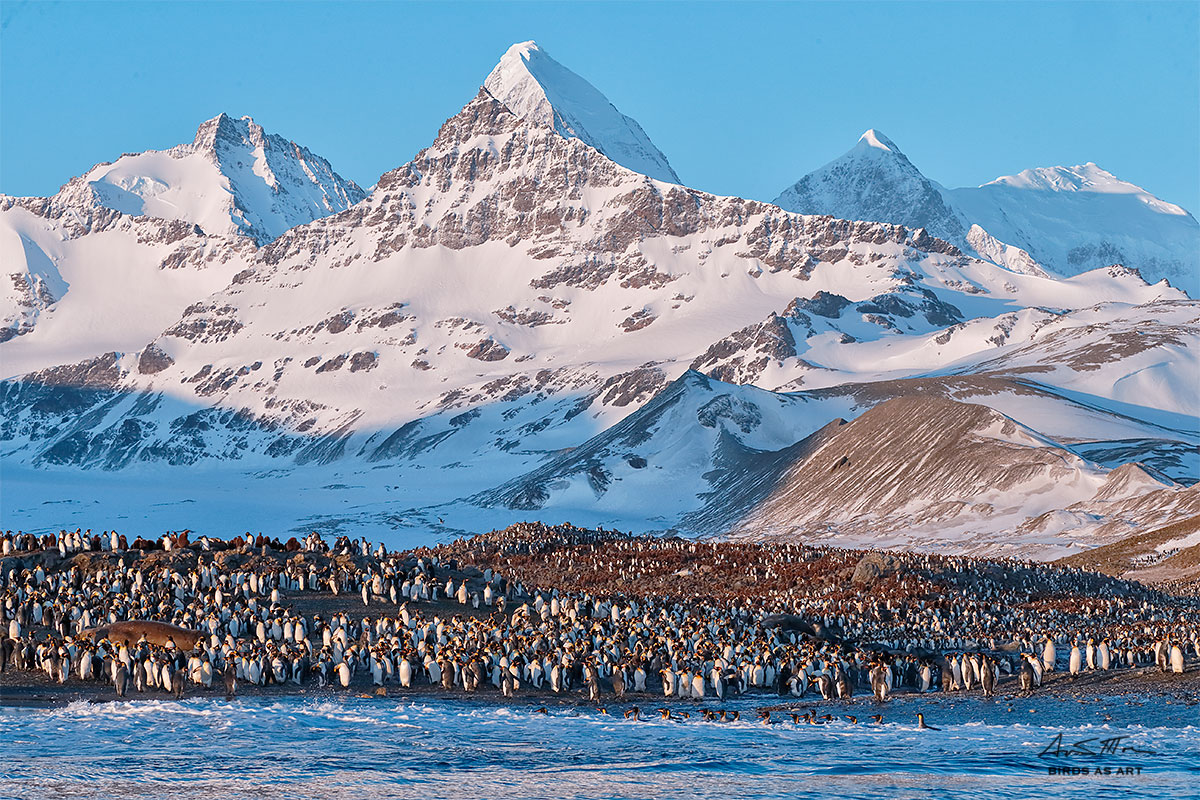
|
|
This image was created at St. Andrews Bay, South Georgia, with the hand held Canon EF 100-400mm f/4.5-5.6L IS II USM lens (at 100mm) and the rugged Canon EOS-1D X. ISO 800. Evaluative metering +1/3 stop: 1/800 sec. at f/10 in Manual mode. AWB.
Center AF point/AI Servo Expand/Rear Focus AF on the front row of penguins and re-compose. Click here to see the latest version of the Rear Focus Tutorial. Click on the image to see a larger version.
King Penguin colony in early morning light
|
Hard to Believe Beauty…
When we landed at St. Andrews Bay just after 4am on November 9, 2015 the skies were clear and blue. I quickly realized that with the sun offshore it would be difficult to impossible to photograph the King Penguin colony while on shore. I found Ted and asked him if it would be possible to do a zodiac cruise in front of the colony so that we could get on sun angle. He said that there was a good chance that he could make that happen. I rounded up all the BAA group folks that I could and advised them on what to bring. Five minutes later six of us climbed back into a zodiac and enjoyed the time of our lives. Assistant expedition leader Hugh Rose did an excellent job at the helm.
Photographing the colony in early morning light from a zodiac was a huge challenge in part because of the extreme contrast and in part because a zodiac is always rocking gently even in calm water. After an hour we were sated and returned to shore just as it began to cloud up; I pray for clouds both in the Southern Ocean and on my Galapagos trips. Thanks to my idea dozens of other guests got to do zodiac cruising in front of the vast assemblage of King Penguins throughout the long day. But only the BAA group got to enjoy the incredible early morning light. Thanks to Ted Cheeseman for being open to my suggestion and for making it happen.
If you would like to join us on the OCT/NOV 2016 expedition to South Georgia and the Falklands, please shoot me an e-mail with the words “Cheesemans’ Last South Georgia Expedition” cut and pasted into the Subject Line. But much better to call CES directly as I will be offline until April 28 or 29th.
Please Remember to use our Affiliate Links 🙂
To show your appreciation for my continuing efforts here, we ask, as always, that you get in the habit of using my B&H affiliate links on the right side of the blog for all of your photo and electronics purchases. Please check the availability of all photographic accessories in the BIRDS AS ART Online Store, especially the Mongoose M3.6 tripod heads, Gitzo tripods, Wimberley heads and plates, LensCoats and accessories, and the like. We sell only what I have used, have tested, and can depend on. We will not sell you junk. We know what you need to make creating great images easy and fun. And we are always glad to answer your gear questions via e-mail. I just learned that my account was suspended during my absence; it should be up and running by Monday at the latest.
I would of course appreciate your using our B&H affiliate links for all of your major gear, video, and electronic purchases. For the photographic stuff mentioned in the paragraph above we, meaning BAA, would of course greatly appreciate your business. Here is a huge thank you to the many who have been using our links on a regular basis and visiting the BAA Online store as well.
Facebook
Be sure to like and follow BAA on Facebook by clicking on the logo link upper right. Tanks a stack!
Typos
In all blog posts and Bulletins, feel free to e-mail or to leave a comment regarding any typos or errors. Just be right 🙂
December 4th, 2015 What’s Up?
Actually me, at 3am on Thursday. My 6:05am flight to Houston was a piece of cake. My flight to Orlando was delayed for an hour (maintenance) and then for another hour when Southwest realized that our new aircraft had too much fuel loaded. I was on the ground at MCO at about 3:30 and was met by my right hand man, Jim Litzenburg. With lots of rain, traffic, and shopping stops on the way home we did not make it to ILE until nearly 7pm.


The Bosque Site Guide
If you can’t make or afford a Bosque IPT, or if the holidays preclude your joining one, be sure to get yourself a copy of my Bosque Site Guide. All BAA Site Guides are designed so that with a bit of study you can show up at a great place and know exactly where to be at what time on what wind and in what lighting conditions. And on what wind. With a Site Guide on your laptop you will feel like a 22-year veteran on your first visit. Site Guides are the next best thing to being on an IPT. If you plan on visiting Bosque it would be foolish to make the trip without having this guide in hand. Why spend money on gear and travel and then spend days stumbling around in the wrong spot? If you have visited previously, and are still unsure of where you should be at this time of day with that wind, this guide will prove invaluable to you as well. Even folks visiting Bosque for the tenth time will learn a ton as I share my secrets and hold nothing back….
In the next week or so, I will be working on a 2015 Bosque Current Conditions Guide; it will be send for free to all who have previously purchased the Bosque Site Guide and will also be available as a separate, stand-alone purchase.
Bosque Site Guide Kudos
By e-mail from Paul Shilling
After planning my first trip to Bosque earlier this year, I bought your excellent Bosque site guide. Read through it a couple of times. It is well worth the $50. It helped me get a good feel for the refuge before arriving. Many thanks. I was there last week for a morning and an afternoon. After disappointingly finding almost no birds before and just after sunrise at your suggested location, I enjoyed the cranes flying out at the spot you mention in the guide. Then I went straight to the farm fields in the north loop; they did not disappoint. Your guide led me to each of these spots. Without your guide would have had to guess at my next move. Best, Paul
Selling Your Used Gear Through BIRDS AS ART
Selling your used (or like-new) photo gear through the BAA Blog or via a BAA Online Bulletin is a great idea. We charge only a 5% commission. One of the more popular used gear for sale sites charges a minimum of 20%. Plus assorted fees! Yikes. The minimum item price here is $500 (or less for a $25 fee). If you are interested please e-mail with the words Items for Sale Info Request cut and pasted into the Subject line :). Stuff that is priced fairly–I offer free pricing advice, usually sells in no time flat. In the past few months, we have sold just about everything in sight. Do know that prices on some items like the EOS-1D Mark IV, the old Canon 500mm, the EOS-7D, and the original 400mm IS DO lens have been dropping steadily.
After a month long lull, there have been more than a few sales while I was at Bosque:
Alan and Sara Levine sold several items.
Two Canon 500mm f/4L IS lenses (two) were sold by Pat & Stokes Fishburne for $3799 each in late November, 2015.
A Canon EOS-1D Mark IV Camera Body was sold by Alice Garland for $1350 in mid-November, 2015.
And the sale of Brent Bridges’s 600 II is pending.
New Listing
Canon 400mm f/5.6L Lens
David Bell is offering a used Canon 400mm f/5.6L lens in excellent condition for only $699, another lowest-ever BAA price. The sale includes both caps, the tough fabric case, the tripod collar, the original box, and insured ground shipping via UPS ground. Payment by money order, or by Paypal plus 3% = $719.97. Please contact David by e-mail or by phone at 416 671 8106. (Eastern time zone.)
I put my then beloved “toy lens” on the map more than 20 years ago by pioneering its use for photographing birds in flight. Wow, did I love that lens along with the Canon A2 camera body and Fuji Velvia pushed one stop to ISO 100! Though I sold mine a few years back it is still a great lens for flight for those who do not depend on IS and it makes a great starter lens as well. Put it on a tripod with the 1.4X III TC, a 7D II, and the Mongoose M3.6 and you will enjoy 896mm of effective reach. This lens is priced to sell quickly. artie
|
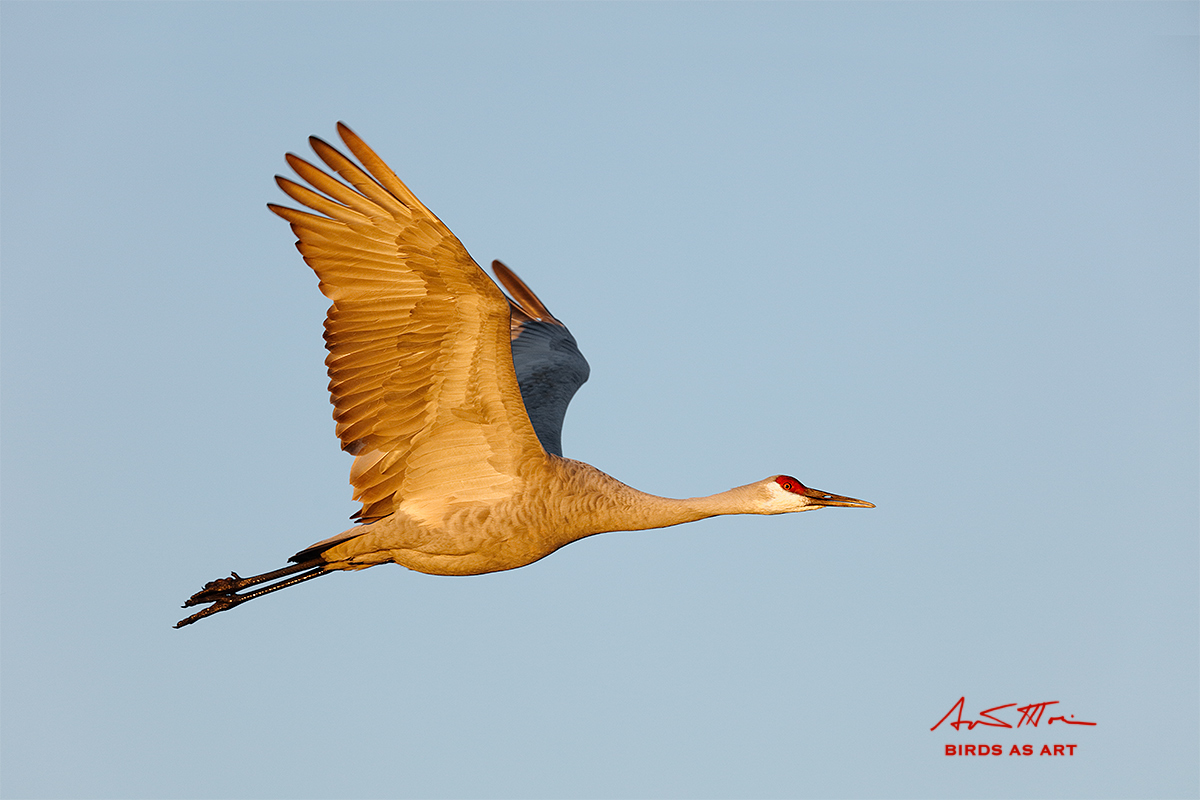
|
|
This image was created on the morning of Day 3 of the second 2015 Bosque IPT with the Induro tripod/Mongoose M3.6-mounted Canon EF 600mm f/4L IS II USM lens, the Canon Extender EF 1.4X III, and the Canon EOS 5DS R. ISO 500. Evaluative metering +1 stop: 1/800 sec. at f/5.6 in Tv mode. Color temperature: AWB.
Center AF point//AI Servo Surround (should have been Expand…)/Shutter Button AF was active at the moment of exposure; the active AF point was on the crane’s back just in front of the rear wing, on the same plane as the bird’s face. This optimized image is a very small crop: 135.8 mbs out of the original 144mb size of the converted TIF file. Click on the image to see a larger version.
Sandhill Crane in flight/wings up
|
The EOS 5DS R is no good for photographing birds in flight! Or is it?
I have seen more than a few items from the internet experts stating that the EOS 5DS R is not a good choice for photographing birds because of its relatively slow frame rate of 5 frames per second and because of its allegedly inferior frame rate. As you might expect, I beg to differ. In fact, the slower frame rate–and I know that this might seem strange to many folks–actually allows me to more easily keep a flying subject framed properly than when working with the 1D X and its blazing 12 frames per second. Just so you know: whatever the frame rate getting a perfect wings up (as here) or wings down pose is somewhat a matter of luck. Of course, the more sharp frames that you make when the bird is “in the zone,” the greater your chances of coming up with a pleasing flight pose.
What is “in the zone” for flight photography? In the zone means that the bird is flying towards you and towards the light and fills more than half the frame. When the bird’s tail or feet are the closest thing to you quit pushing the shutter button; you are not impressing anyone 🙂
Is every flight image sharp on the eye? Of course not. My percentage of very sharp on the eye images is pretty much the same as with the 1D X or the 7D II. When an image is not sharp I do not look at my gear, I look in the mirror….
|
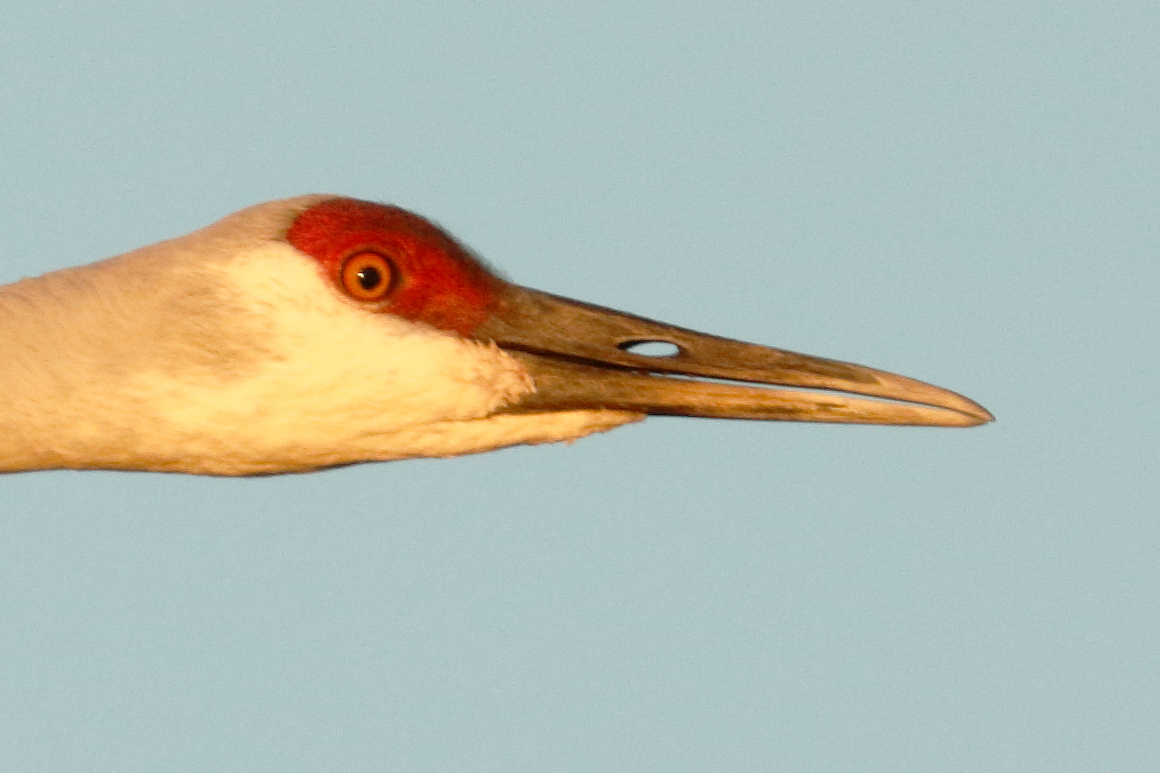
|
|
This is an unsharpened 100% crop of the cranes’s head.
|
A 100% Crop
Again I am quite impressed by a 5DS R 100% crop. On the second Bosque IPT, Nikon shooter Warren Hatch was amazed by the feather detail about the face as compared to a similar image made with his 600mm lens. I am not sure what the grey fuzz on the forehead is but I cloned it out in the optimized image file. Any clues? Note that 1/800 sec. is a bit less then ideal for flight photography; many folks recommend at least 1/1600 sec.
|
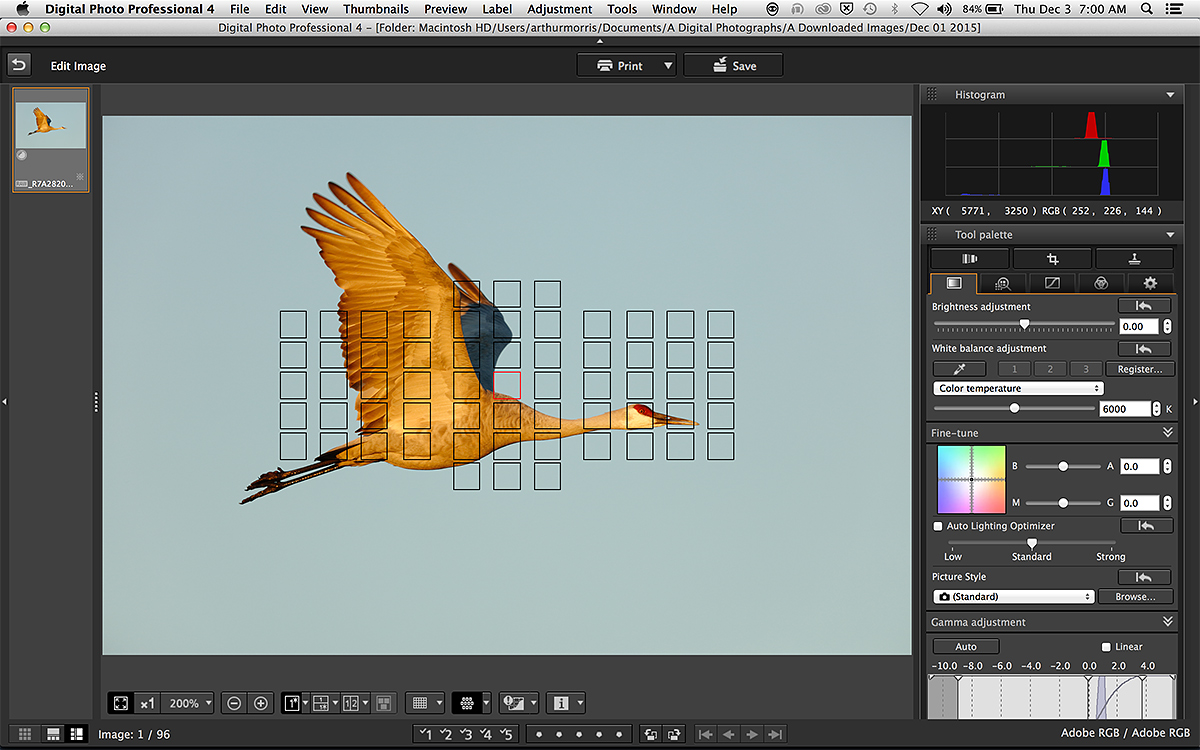
|
|
This is a DPP 4 screen capture for today’s featured image.
|
The DPP 4 Screen Capture
One of the nice things about DPP 4 is that the current version supports 5DS R RAW files. Note the placement of the selected AF point that is illuminated in red. Note that I set the color temperature slider to K6000.
If you have any idea why the RGB numbers for the WHITEs on the neck show as R=252, G=226, B=144 please leave a comment.
The Image Optimization
After converting this image in DPP I brought it into Photoshop and did lots. First I applied a layer of NIK Color EFEX Pro White Neutralizer to the whole image; this turned the sickly cyan-blue sky to a perfect light blue. Then I applied a layer of my NIK 50/50 Detail Extractor/Tonal Contrast recipe to the bird only (after making the selection with the Quick Selection Tool) and reduced the opacity of the layer to 33%. Next I worked on the whites of the neck after selecting those in the same manner. I used Selective Color to take some BLACK out of the WHITEs and then reduced the RED saturation considerably. That left me with much cleaner looking WHITEs. Then I reduced the RED saturation for the whole image.
To eliminate the BLUE cast to the shadowed area of the far wing I selected that and then reduced the saturation of both the BLUEs and the CYANS.
Next came some Eye Doctor work. I painted a Quick Mask of the pupil and darkened it by pulling the curve down (Control M). Next I selected the whole face, bill, and neck with the Quick Selection Tool and applied a Contrast Mask (Unsharp Mask at 15/65/0). This sharpened up the face a bit and rendered the white neck a bit brighter.
Volia. Even outstanding RAW files can be improved in Photoshop.
Digital Basics
Are you tired of making your images look worse in Photoshop? Everything that I did to optimize today’s image and tons more is covered in detail in my Digital Basics File, an instructional PDF that is sent via e-mail. It includes my complete digital workflow, setting up BreezeBrowser and Downloader Pro, dozens of great Photoshop tips, the use of Contrast Masks, several different ways of expanding canvas, all of my time-saving Keyboard Shortcuts, the basics of Quick Masking, Layer Masking, and NIK Color Efex Pro, my killer image clean-up techniques, Digital Eye Doctor, creating time-saving actions, and lots more.
APTATS I & II
Learn the details of advanced Quick Masking techniques in APTATS I. Learn Advanced Layer Masking Techniques in APTATS I. Mention this blog post and apply a $5 discount to either with phone orders only. Buy both APTATS I and APTATS II and we will be glad to apply at $15 discount with phone orders only. Please call Jim or Jennifer weekdays at 863-221-2372 to take advantage of this offer. I am pretty sure that we have extended that offer to the BAA Online Store as well… No time to check right now. 🙂
|
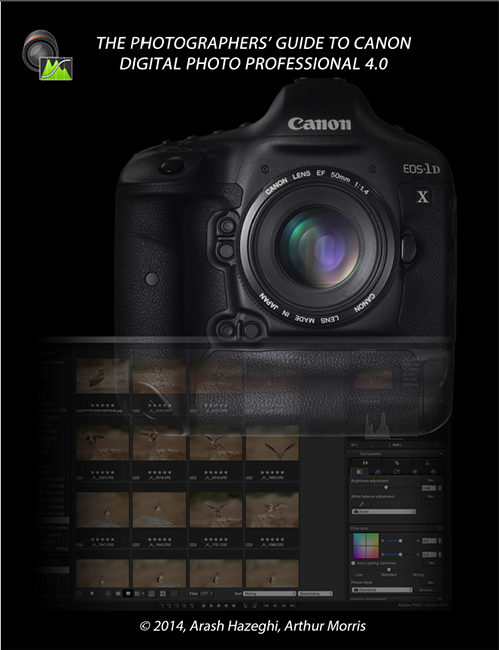
|
|
You can order your copy of “The Photographers’ Guide to Canon Digital Photo Professional 4.0” (aka the DPP 4 Raw Conversion eGuide) by Arash Hazeghi and Arthur Morris by clicking here.
|
The DPP 4 eGuide (PDF)
Learn how and why I and many other discerning photographers choose and use only DPP 4 to convert their Canon RAW files in the DPP 4 RAW Conversion Guide by Arash Hazeghi and yours truly. The latest version supports all of the newer Canon camera bodies and several older models as well including the EOS-7D and the EOS-1D Mark IV. DPP is fast and produces extremely accurate colors.


Please Remember to use our Affiliate Links 🙂
To show your appreciation for my continuing efforts here, we ask, as always, that you use our the B&H and Amazon affiliate links on the right side of the blog for all of your purchases. B&H is recommended for you major photography gear purchases, Amazon for your household, entertainment, and general purpose stuff. Please check the availability of all photographic accessories in the BIRDS AS ART Online Store, especially the Mongoose M3.6 tripod heads, Gitzo tripods, Wimberley heads and plates, LensCoats and accessories, and the like. We sell only what I have used, have tested, and can depend on. We will not sell you junk. We know what you need to make creating great images easy and fun. And we are always glad to answer your gear questions via e-mail. I just learned that my account was suspended during my absence; it should be up and running by Monday at the latest.
I would of course appreciate your using our B&H affiliate links for all of your major gear, video, and electronic purchases. For the photographic stuff mentioned in the paragraph above we, meaning BAA, would of course greatly appreciate your business. Here is a huge thank you to the many who have been using our links on a regular basis and visiting the BAA Online store as well.
Facebook
Be sure to like and follow BAA on Facebook by clicking on the logo link upper right. Tanks a stack!
Support the BAA Blog. Support the BAA Bulletins: Shop B&H here!
We want and need to keep providing you with the latest free information, photography and Photoshop lessons, and all manner of related information. Show your appreciation by making your purchases immediately after clicking on any of our B&H or Amazon Affiliate links in this blog post. Remember, B&H ain’t just photography!
…..
Amazon.com
Those who prefer to support BAA by shopping with Amazon may use this link:
Amazon Canada
Many kind folks from north of the border, eh, have e-mailed stating that they would love to help us out by using one of our affiliate links but that living in Canada and doing so presents numerous problems. Now, they can help us out by using our Amazon Canada affiliate link by starting their searches by clicking here. Many thanks to those who have written.
Typos
In all blog posts and Bulletins, feel free to e-mail or to leave a comment regarding any typos or errors. Just be right :).
December 3rd, 2015 What’s Up?
When we first approached our chosen morning spot we were dismayed to see dozens of other cars and lots of photographers where there had been nobody but us for three straight mornings. Other tour leaders and small photo groups often follow me around or see us when they are scouting. As we got closer though I was thrilled to see that though they were close to where we had been they actually had their group (or groups–there were about 30 photographers in all) in the wrong spot. They had trees and bushes cluttering the ridge line and half of the folks had a large, and I mean very large tree, between them and the color atop the ridge. Man, you gotta love it.
Yes, BIRDS AS ART IPTs are expensive. You do, however, get what you pay for. We enjoyed our best morning blast-off of our two-week stay. I will share an image made on our last morning with you here soon.
Thanks a stack to blog subscriber and multiple IPT veteran David Policansky and wife Sheila who treated Denise Ippolito and me to an amazingly wonderful dinner at Scalo Northern Italian Grill on Central Avenue in SE Albuquerque. Right now I gotta hit the sack as I have a 3am wake up call for my 6:05am flight.


|
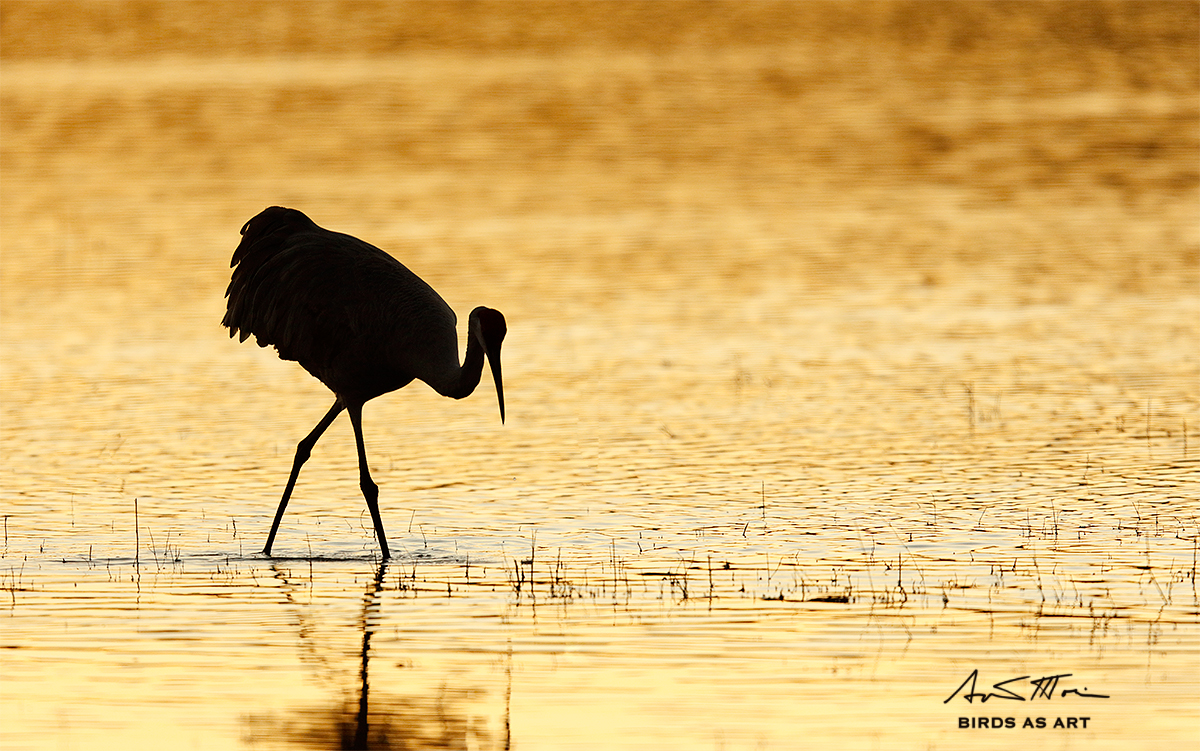
|
|
This image was created on the afternoon of Day 3 of the second 2015 Bosque IPT with the Induro tripod/Mongoose M3.6-mounted Canon EF 600mm f/4L IS II USM lens, the Canon Extender EF 1.4X III, and the Canon EOS 5DS R. ISO 800. Evaluative metering +2/3 stop: 1/500 sec. at f/5.6 in Av mode. Color temperature: 8000K.
Center AF point (Manual selection)/AI Servo/Shutter Button AF and re-compose. This optimized image is a relatively small crop: 108.2 mbs out of the original 144mb size of the converted TIF file. Click on the image to see a larger version.
Sandhill Crane sunset silhouette
|
Elegance Defined…
So much of photography is bring ready for the moment, the magic, the just right pose. I was standing next to Warren (not Wayne!) Hatch who set the record for most-years-between-IPTs with his attendance on Bosque #2. His first IPT had been Cape May in the spring of 1994 just after Elaine’s death. When I saw the bird strike this elegant pose I said to him, “That’s it!” And showed him the image on the rear LCD. What makes images like this special? Hard to define but you know them when you see them.
Please Remember to use our Affiliate Links 🙂
To show your appreciation for my continuing efforts here, we ask, as always, that you use our the B&H and Amazon affiliate links on the right side of the blog for all of your purchases. B&H is recommended for you major photography gear purchases, Amazon for your household, entertainment, and general purpose stuff. Please check the availability of all photographic accessories in the BIRDS AS ART Online Store, especially the Mongoose M3.6 tripod heads, Gitzo tripods, Wimberley heads and plates, LensCoats and accessories, and the like. We sell only what I have used, have tested, and can depend on. We will not sell you junk. We know what you need to make creating great images easy and fun. And we are always glad to answer your gear questions via e-mail. I just learned that my account was suspended during my absence; it should be up and running by Monday at the latest.
I would of course appreciate your using our B&H affiliate links for all of your major gear, video, and electronic purchases. For the photographic stuff mentioned in the paragraph above we, meaning BAA, would of course greatly appreciate your business. Here is a huge thank you to the many who have been using our links on a regular basis and visiting the BAA Online store as well.
Facebook
Be sure to like and follow BAA on Facebook by clicking on the logo link upper right. Tanks a stack!
Support the BAA Blog. Support the BAA Bulletins: Shop B&H here!
We want and need to keep providing you with the latest free information, photography and Photoshop lessons, and all manner of related information. Show your appreciation by making your purchases immediately after clicking on any of our B&H or Amazon Affiliate links in this blog post. Remember, B&H ain’t just photography!
…..
Amazon.com
Those who prefer to support BAA by shopping with Amazon may use this link:
Amazon Canada
Many kind folks from north of the border, eh, have e-mailed stating that they would love to help us out by using one of our affiliate links but that living in Canada and doing so presents numerous problems. Now, they can help us out by using our Amazon Canada affiliate link by starting their searches by clicking here. Many thanks to those who have written.
Typos
In all blog posts and Bulletins, feel free to e-mail or to leave a comment regarding any typos or errors. Just be right :).
December 2nd, 2015 What’s Up?
Again co-leader Denise Ippolito and I had our group positioned perfectly for sunrise, and again, the birds put on a great show. There was another photo group two hundred yards to our right but our chances were far better than theirs for a hundred reasons. Everyone else was completely in the wrong place. After the blast-off/flyout (still no fly-ins) we moved quickly to our next location and did very well with the cranes. There are several other photography groups at the refuge right now and I love the approach of the other leaders; I call it the tripods-in-cement approach. They put the group in one spot and an hour later nobody has moved their tripod once. The BAA/A Creative Adventure group on the other hand has moved more than half a dozen times, each with a purpose that is explained to the group; nearly all of our moves paid off handsomely.
We did our critiquing session at lunch and most everyone had some great images to share. We are headed back for our Tuesday afternoon session as I type. Our final morning session with the group is on Tuesday. We check out and drive to Albuquerque that afternoon and fly back east early on Thursday morning.


|
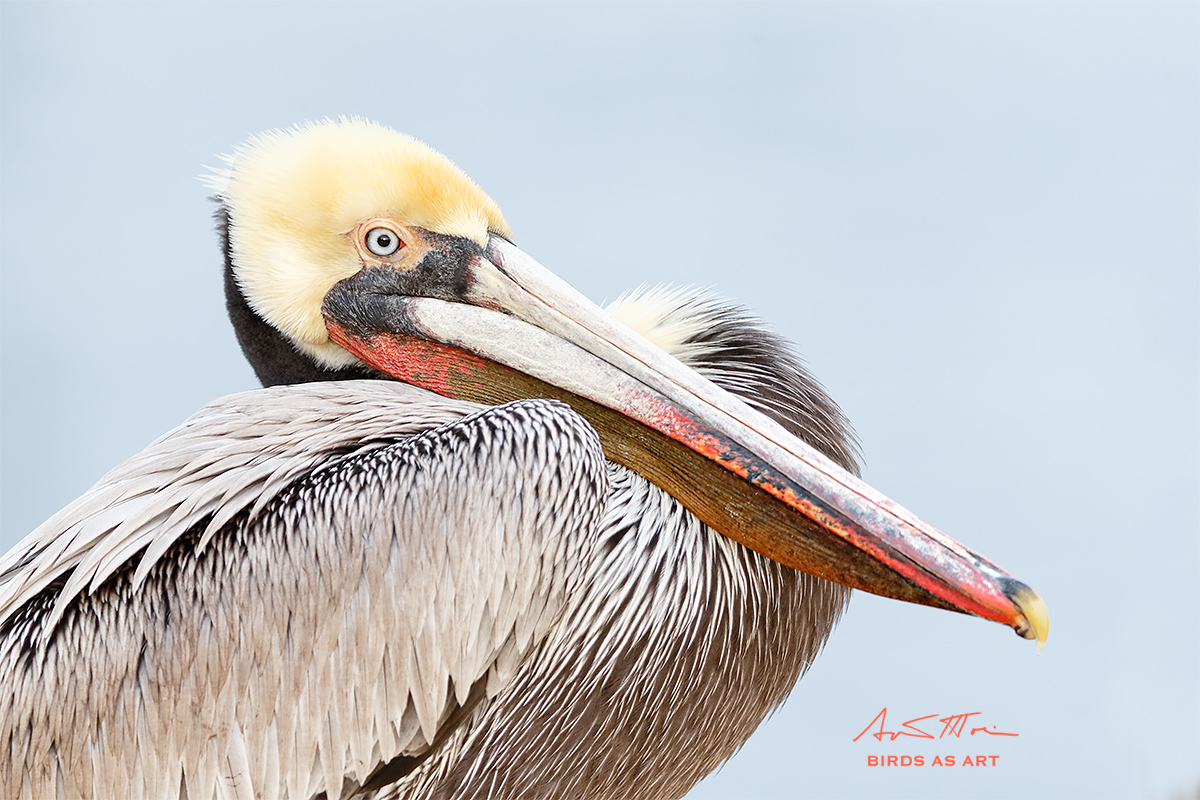
|
|
This image was created on the 2015 San Diego IPT with the Induro tripod/Mongoose M3.6-mounted Canon EF 200-400mm f/4L IS USM Lens with Internal 1.4x Extender (with the internal extender engaged at 490mm) and the rugged Canon EOS-1D X. ISO 1600. Evaluative metering +1 stop: 1/100 sec. at f/5.6. Color temperature: K7500.
Center AF point/AI Servo Surround/Rear Focus AF on the bird’s eye and re-compose. Click here to see the latest version of the Rear Focus Tutorial. Click on the image to see a larger version.
Stately Brown Pelican
|
Strange EXIF…
When I looked at this image I would never have thought ISO 1600 as the image is bright and clean and the colors so rich… And the shutter speed of 1/100 sec. was a bit puzzling as well. In any case, everything worked beautifully.
The Image Optimization
After converting this image in DPP I brought it into Photoshop and applied a 50% layer of my NIK Color Efex Pro 50-50 recipe to the entire bill and the head. This enriched the colors and detail and toned down the light grey on the bill. Then I again used the Quick Selection Tool, this time to select the distal end of the bill. Then I applied a Contrast Mask to that layer as I was a bit short of depth-of-field.
Digital Basics
Are you tired of making your images look worse in Photoshop? Everything that I did to optimize today’s image and tons more is covered in detail in my Digital Basics File, an instructional PDF that is sent via e-mail. It includes my complete digital workflow, setting up BreezeBrowser and Downloader Pro, dozens of great Photoshop tips, the use of Contrast Masks, several different ways of expanding canvas, all of my time-saving Keyboard Shortcuts, the basics of Quick Masking, Layer Masking, and NIK Color Efex Pro, my killer image clean-up techniques, Digital Eye Doctor, creating time-saving actions, and lots more.
APTATS I & II
Learn the details of advanced Quick Masking techniques in APTATS I. Learn Advanced Layer Masking Techniques in APTATS I. Mention this blog post and apply a $5 discount to either with phone orders only. Buy both APTATS I and APTATS II and we will be glad to apply at $15 discount with phone orders only. Please call Jim or Jennifer weekdays at 863-221-2372 to take advantage of this offer. I am pretty sure that we have extended that offer to the BAA Online Store as well… No time to check right now. 🙂
|

|
|
You can order your copy of “The Photographers’ Guide to Canon Digital Photo Professional 4.0” (aka the DPP 4 Raw Conversion eGuide) by Arash Hazeghi and Arthur Morris by clicking here.
|
The DPP 4 eGuide (PDF)
Learn how and why I and many other discerning photographers choose and use only DPP 4 to convert their Canon RAW files in the DPP 4 RAW Conversion Guide by Arash Hazeghi and yours truly. The latest version supports all of the newer Canon camera bodies and several older models including the EOS-7D and the EOS-1D Mark IV. A free update that will cover most of the newly added cameras will be sent as soon as I get it from Arash.
|
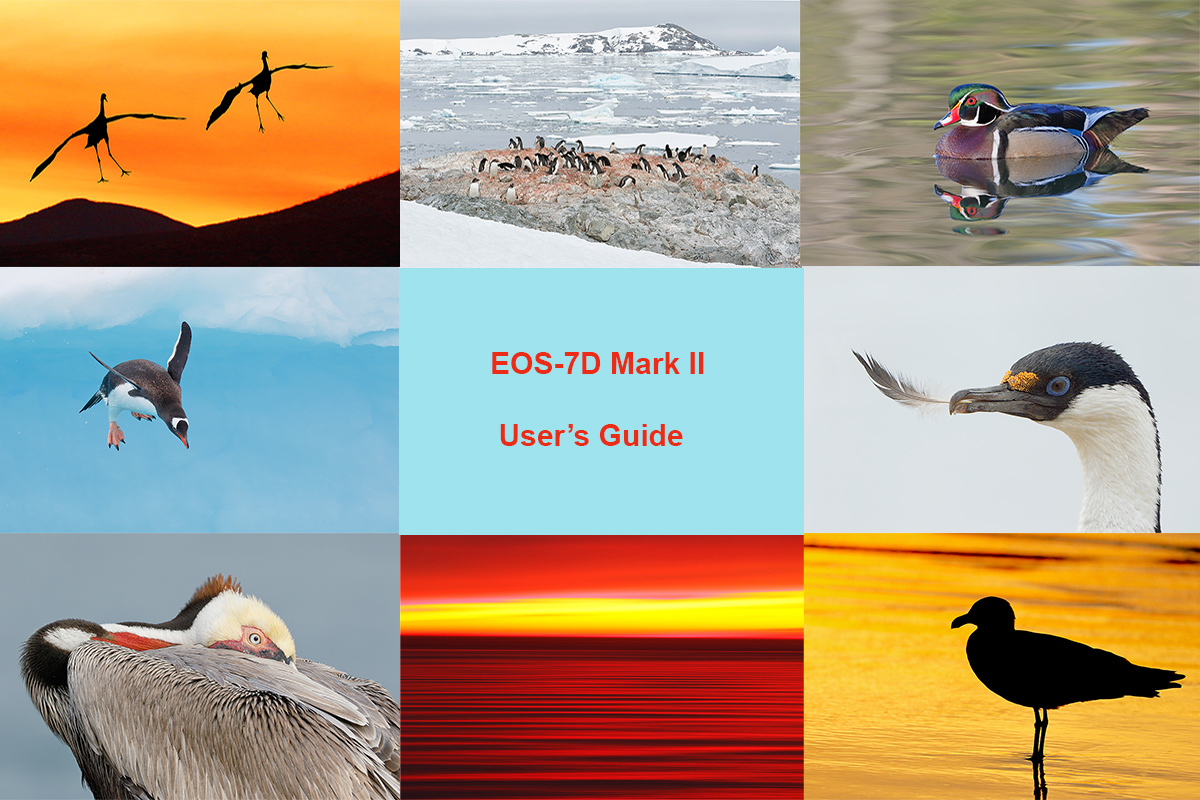
|
|
You can purchase your copy of the The 7D Mark II User’s Guide in the BAA Online Store here for $59.
|
7D Mark II User’s Guide
You can purchase your copy right now in the BAA Online Store here for $59. Or call Jim or Jennifer at 863-692-0906 and place a phone order. This is the highest priced user’s guide ever, surpassing the 5D II User’s Guide that is priced at $50. Why? I did twice as much work preparing the 7D II Guide. It required many days of writing, many dozens of hours of study and research, not to mention hundreds of hours in the field trying to figure out the best 7D II setting while doing what I love to do best, photographing birds and nature. The camera is quite complex. Many thanks to both Rudy Winston and Chuck Westfall of Canon USA for their help in getting me through the stickiest parts.
The guide contains 23,196 words in 516 paragraphs. There are 24 photos and screen captures interspersed in the main body of the text and a gallery of 23 additional 7D II images that show what the camera is capable of with a variety of lens and lens/TC combinations. We would love your feedback.
The Great Strength of the 7D Mark II User’s Guide
The very great strength of the 7D Mark II User’s Guide is the coverage of the autofocus system. I review in detail all of the items on the five pink AF Menus. Most important of these is the Custom Case setting (at AF 1) that I have developed over time and currently use for all of my bird photography. On the recently concluded Hooptie Deux Spoonbills and more IPT John Johnson of Naples, FL mentioned that he was having trouble producing sharp flight images. I set up my Custom Case on his camera, and within minutes he was amazed at the sharp results that he was getting…. While skill, strength, fine motor control, and superior hand eye coordination are all factors that will influence your success as a flight photographer, you can have all of the preceding in spades but if your camera is not set up properly much of your effort will be in vain….
What Else is in the Guide?
In the 7D Mark II User’s Guide you will learn everything that I know about the important topics listed below, and better yet, I explain the options for each along with my reasons for choosing a specific setting in a specific situation.
Handling the WHITEs
The top LCD and all camera control buttons
7D Mark II drive modes
How to manually select an AF sensor
Choosing an AF Area Selection Mode; how and why (includes extensive detail)
Moving the AF point or Zone
The creation of in-camera Multiple Exposures and in-camera HDR images (includes extensive detail)
Live View Shooting and AF choices (all new in the 7D II)
Menu Item Access
Coverage of almost all Menu Items and Custom Functions including the following: Image Quality, Auto Lighting Optimizer, Lens aberration corrections settings, Highlight Tone Priority, AF Configuration Tool (as above, this includes details on the custom setting that I use), Acceleration/deceleration tracking, Tracking sensitivity, Lens drive when AF impossible, Orientation linked AF point (I love this feature), Highlight alert, Histogram display–do you know how to access both histograms at once?, Auto rotate, Image Jump, LCD Brightness, Info button display options, Custom Shooting Modes set-up, ISO Safety shift, using the Q button, setting up rear focus, and setting up your My Menu feature (among others).
The guide is–of course–written in my informal, easy-to-follow style.
Please note: Some Menu items are not covered in this guide for one of several reasons:
They deal only with the creation of movies (not covered)
They are irrelevant to nature photography.
After spending hours studying the 7D II Instruction Manual and consulting others I have no clue as to the purpose or the reason for the existence of a given feature.
Though I recommend that the irrelevant and confusing items be left at the default settings, I do, in most cases, I refer you to the relevant page in the 7D II Instruction Manual. If you follow up, it just might turn out that you are a lot smarter than me. In those cases I would love to hear from you via e-mail. So far none of the above have prevented me from creating many spectacular images with my 7D II.
Please note that this guide does not contain a table of contents or an index. To search the document for a given topic simply hit Control F to search. When the Find box pops up, simply type the term that you are looking for into the field and hit Next. This will allow you to find what you are looking for quickly and efficiently.
If you purchase the 7D II UG and it helps you to create better images, please feel free to send no more than two 1200 pixel wide or 900 pixel tall sharpened JPEGs to me via e-mail along with your comments. I will be glad to do a short critique if so requested.
Otherwise, feedback via e-mail or blog comment is always appreciated.
Click here and scroll down for a free 7D Mark II User’s Guide AF Point Auto Switching Excerpt.
See the “Many Many Lessons including: why I chose the 300 II/1D X in low light conditions, the 7D II viewfinder level, a short 7D II User’s Guide Viewfinder Display excerpt, adding green (marsh grass) to your images, and why to love hazy sun” blog post here and scroll down for a short excerpt on the 7D II Viewfinder Display.
|

|
|
San Diego offers a wealth of very attractive natural history subjects. With annual visits spanning more than three decades I have lot of experience there….
|
2016 San Diego 4 1/2-DAY BIRDS AS ART Instructional Photo-Tour (IPT) JAN 8 thru the morning of JAN 12, 2016: $1899 (Limit: 10/Openings; 2)
Meet and Greet at 7:00pm on the day before the IPT begins
Two great leaders: Arthur Morris and Denise Ippolito
Join us in San Diego to photograph the spectacular breeding plumage Brown Pelicans with their fire-engine red and olive green bill pouches; Brandt’s and Double-crested Cormorants in breeding plumage with their amazing crests; breeding plumage Wood and Ring-necked Duck; other species possible including Lesser Scaup, Redhead, and Surf Scoter; a variety of gulls including Western, California, and the gorgeous Heerman’s, all in full breeding plumage; shorebirds including Marbled Godwit, Willet, Sanderling and Black-bellied Plover; many others possible including Least, Western, and Spotted Sandpiper, Whimbrel, Black and Ruddy Turnstone, Semipalmated Plover, and Surfbird; Harbor Seals (depending on the current regulations) and California Sea Lions likely; and Bird of Paradise flowers. And as you can see by studying the two IPT cards there are some nice landscape opportunities as well.
Did I mention that there are wealth of great birds and natural history subjects in San Diego in winter?
|

|
|
Though the pelicans will be the stars of the show on this IPT there will be many other handsome and captivating subjects in wonderful settings.
|
The San Diego Details
This IPT will include five 3 1/2 hour morning photo sessions, four 2 1/2 hour afternoon photo sessions, five lunches, after-lunch image review and Photoshop sessions, and a thank you dinner. To ensure early starts, breakfasts will be your responsibility.
A $499 non-refundable deposit is required to hold your slot for this IPT. You can send a check (made out to “Arthur Morris) to us at BIRDS AS ART, PO Box 7245, Indian Lake Estates, FL, 33855. Or call Jim or Jennifer at the office with a credit card at 863-692-0906. Your balance, payable only by check, will be due on 11/1//2015. If we do not receive your check for the balance on or before the due date we will try to fill your spot from the waiting list. Please print, complete, and sign the form that is linked to here and shoot it to us along with your deposit check. If you register by phone, please print, complete and sign the form as noted above and either mail it to us or e-mail the scan. If you have any questions, please feel free to contact me via e-mail.
Please Remember to use our Affiliate Links 🙂
To show your appreciation for my continuing efforts here, we ask, as always, that you use our the B&H and Amazon affiliate links on the right side of the blog for all of your purchases. B&H is recommended for you major photography gear purchases, Amazon for your household, entertainment, and general purpose stuff. Please check the availability of all photographic accessories in the BIRDS AS ART Online Store, especially the Mongoose M3.6 tripod heads, Gitzo tripods, Wimberley heads and plates, LensCoats and accessories, and the like. We sell only what I have used, have tested, and can depend on. We will not sell you junk. We know what you need to make creating great images easy and fun. And we are always glad to answer your gear questions via e-mail. I just learned that my account was suspended during my absence; it should be up and running by Monday at the latest.
I would of course appreciate your using our B&H affiliate links for all of your major gear, video, and electronic purchases. For the photographic stuff mentioned in the paragraph above we, meaning BAA, would of course greatly appreciate your business. Here is a huge thank you to the many who have been using our links on a regular basis and visiting the BAA Online store as well.
Facebook
Be sure to like and follow BAA on Facebook by clicking on the logo link upper right. Tanks a stack!
Support the BAA Blog. Support the BAA Bulletins: Shop B&H here!
We want and need to keep providing you with the latest free information, photography and Photoshop lessons, and all manner of related information. Show your appreciation by making your purchases immediately after clicking on any of our B&H or Amazon Affiliate links in this blog post. Remember, B&H ain’t just photography!
…..
Amazon.com
Those who prefer to support BAA by shopping with Amazon may use this link:
Amazon Canada
Many kind folks from north of the border, eh, have e-mailed stating that they would love to help us out by using one of our affiliate links but that living in Canada and doing so presents numerous problems. Now, they can help us out by using our Amazon Canada affiliate link by starting their searches by clicking here. Many thanks to those who have written.
Typos
In all blog posts and Bulletins, feel free to e-mail or to leave a comment regarding any typos or errors. Just be right :).
December 1st, 2015 What’s Up?
Photographic opportunities continue to improve each day at Bosque del Apache NWR. Monday was amazing as we enjoyed several mega-blast-offs. After a nice sunrise with a fly out blast-off we did well at the crane pools and then headed to the farm fields. The birds were in all over a huge field and eventually concentrated into a single large group in the back-right of the field (well off sun angle). Because of the blend blur effect that comes with really slow shutter speeds, working well off light angle is not a problem. We were waiting and waiting for the big blast off and finally decided to head up to town for lunch not a minute after 10:15am. There were two half-assed half-blasts that resulted only in disappointment.
I tried every trick in the book but the 20,000 birds just sat there making a ton of noise. In desperation I decided to try to send them some energy. At 10:13am a group of 5,000 unseen geese blasted off and joined the huge group. Within a minute the entire group blasted off leaving everyone gasping and thanking me for having the group in the right spot. After lunch Denise Ippolito shared some of her Photoshop magic with the group. The afternoon photo session began with more blast-off magic (times three!) only we did not have to wait as long for the monster blasts. We finished the day off with some nice crane silhouettes. Everyone was thrilled.
I continue to feel a bit better each day.


|
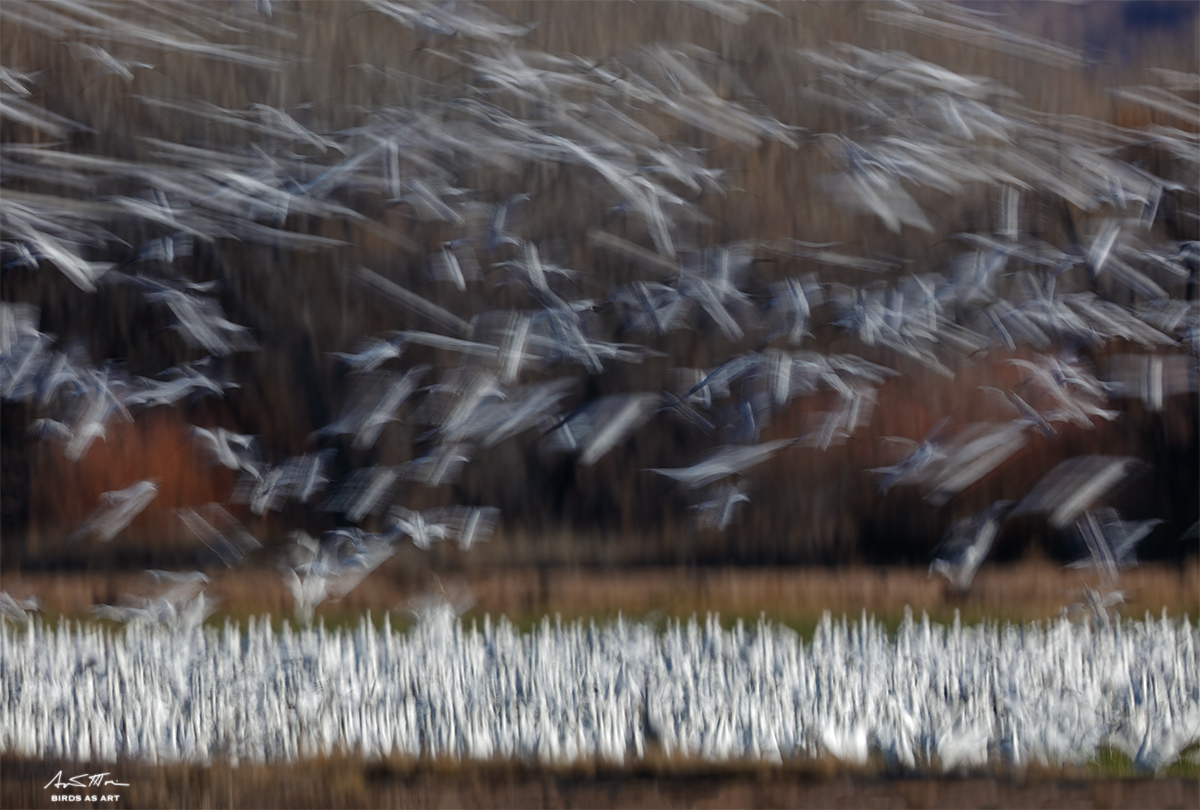
|
|
This image was created at Bosque del Apache NWR with the Induro tripod/Mongoose M3.6-mounted Canon EF 600mm f/4L IS II USM lens, the Canon Extender EF 2X III, and the Canon EOS 5DS R DSLR. ISO 50; 1/4 sec. at f/8 in Manual mode. AWB.
Center AF point (by necessity)/AI Servo Expand/Rear Focus AF and release. Click here to see the latest version of the Rear Focus Tutorial. Click on the image to see a larger version.
Snow Geese psychedelic blur
|
Messing Around: 600/2X III TC/EOS-5DS R…
I think that I was panning up a bit as some birds took off to the right while others took off to the left…
Your Thoughts?
Like it? Hate it? Either way, be sure to let us know why.
|
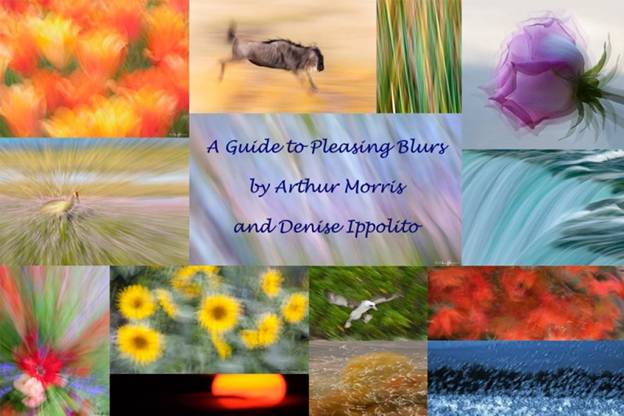
|
|
Learn the secrets of creating contest-winning images in our “A Guide to Pleasing Blurs.”
|
A Guide to Pleasing Blurs
In our A Guide to Pleasing Blurs by Denise Ippolito and yours truly, we discuss just about every technique ever used to create pleasingly blurred image. Ninety-nine point nine percent of pleasing blurs are not happy accidents. You can learn pretty much everything that there is to know about creating them in this instructive, well written, easy to follow guide.
|
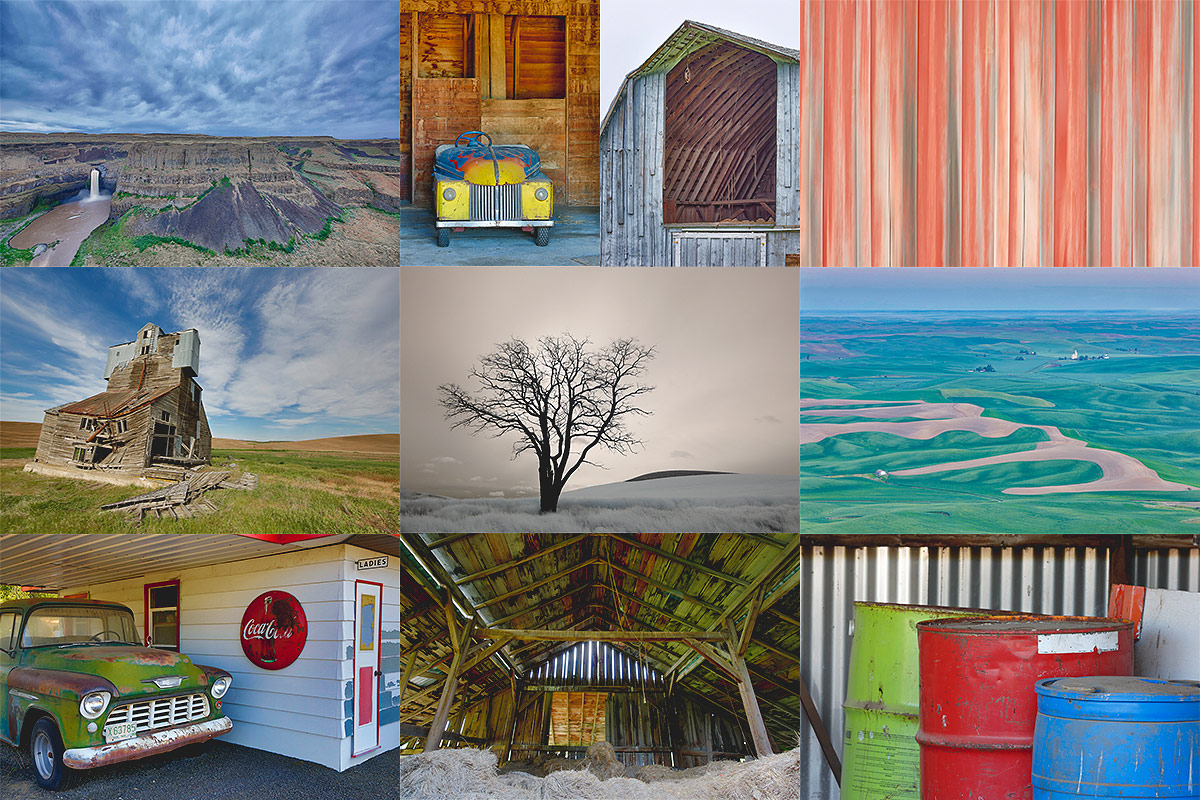
|
|
Subject and focal lengths from upper left to right and then around to center.
Palouse Falls: 11mm; homemade kiddie race car: 105mm; barn siding pan blur: 798mm; Rolling fields diorama: 110mm; Crayola drums: 343 mm; Hay barn interior: 19mm; vintage gas station: 40mm; Dilapidated farm building: 13mm; Denise’s tree Infrared: 20mm.
Images and card design by Arthur Morris/BIRDS AS ART.
|
The Palouse ~ A Creative Adventure/BIRDS AS ART Instructional Photo-Tour (IPT)/Eastern Washington State. June 3-7, 2016/5 Full Days: $1699/Limit 12
The Palouse ~ A Creative Adventure/BIRDS AS ART Instructional Photo-Tour (IPT)/Eastern Washington State. June 10-14, 2016/5 Full Days: $1699/Limit 12
Double Header!
Maximize both your travel dollars and your learning experience by signing up for both IPTs.
|
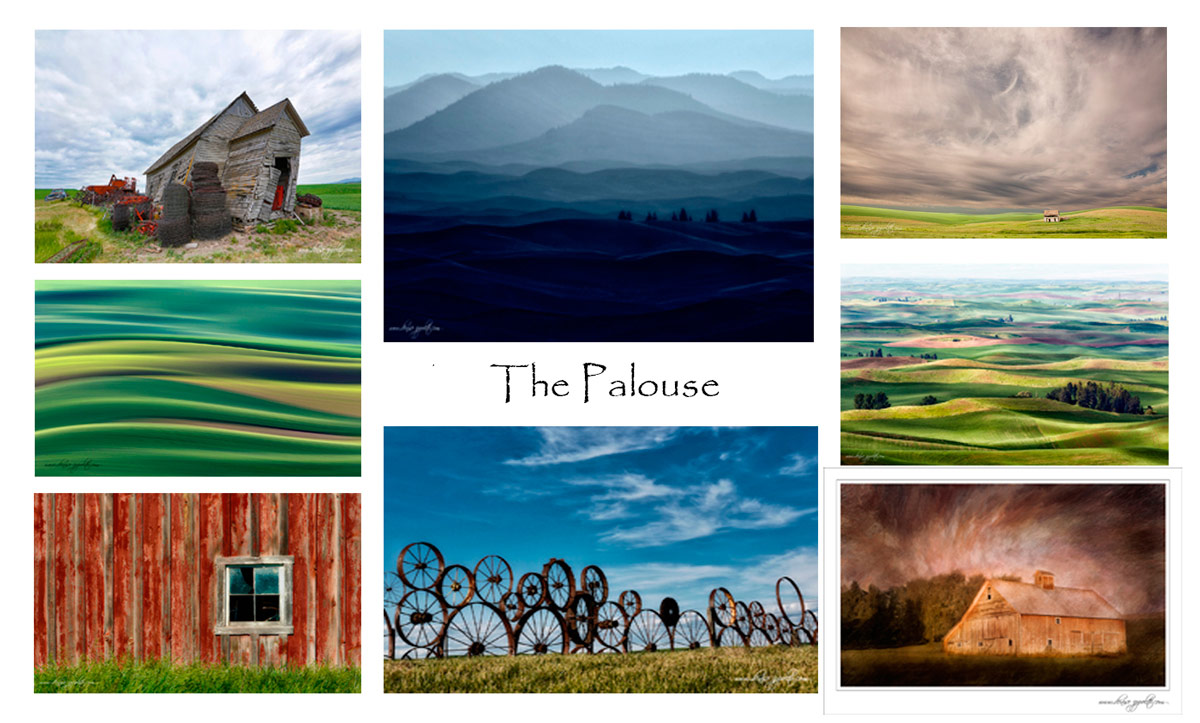
|
|
Images and card design by Denise Ippolito/A Creative Adventure.
|
The Palouse IPTs
Rolling farmlands provide a magical patchwork of textures and colors, especially when viewed from the top of Steptoe Butte where we will likely enjoy spectacular sunrises and possibly a nice sunset. We will photograph grand landscapes and mini-scenics of the rolling hills and farm fields. We will take you to some really neat old abandoned barns and farmhouses in idyllic settings. There is no better way to improve your compositional and image design skills and to develop your creativity than to join us for this trip. Two great leaders: Denise Ippolito and Arthur Morris. Photoshop and image sharing sessions when we have the time and energy…. We get up early and stay out late and the days are long.
After 6 days of back-breaking scouting work in early June 2014 we found all of the iconic locations and, in addition, lots of spectacular new old barns and breath-taking landforms and views. On three additional scouting days in 2015 we discovered several more truly amazing locations. We will teach you what makes one situation prime and another seemingly similar one a waste of your time.
What’s included: In-the-field instruction, guidance, lessons, and inspiration, our newfound but very extensive knowledge of the area, all lunches, motel lobby grab and go breakfasts, and Photoshop and image sharing sessions when possible. There will be a meet and greet at 7:30pm on the evening before each workshop begins.
You will learn and hone both basic and advanced compositional and image design skills. You will learn to get the right exposure every time. You will learn to develop your creative eye. You will learn the basics of HDR (high dynamic range) photography. You will learn a variety of in-camera creative techniques. Most importantly you will learn to see the situation and to create a variety of top-notch images. Do see both of our blogs for lots more on that in the coming weeks. You will learn how the quality and direction of light combine to determine the success of your images. And–please don’t gasp–we will be working quite a bit with sidelight when creating landscapes. Lastly, we will be doing some infrared photography.
To Sign Up
A non-refundable $699 deposit is due now. The balance will be due on February 15, 2016. If we do not receive your check for the balance on or before the due date we will try to fill your spot from the waiting list. Whether or not your spot is filled, you will lose your deposit. If not, you can secure your spot by paying your balance.
With the spectacular success that we enjoyed in 2015 it seems quite likely that this one will fill up very quickly. Please let me know via e-mail that you will be joining us. Then you can either call Jim or Jennifer at 863-692-0906 during business hours or send us a check to leave a deposit; the latter is preferred. If by check, please make out to “Arthur Morris” and mail it to: Arthur Morris/BIRDS AS ART, PO Box 7245, Indian Lake Estates, FL, 33855. If you have any questions, please feel free to contact us via e-mail: artie or denise.
Travel Insurance Services offers a variety of plans and options. Included with the Elite Option or available as an upgrade to the Basic & Plus Options. You can also purchase Cancel for Any Reason Coverage that expands the list of reasons for your canceling to include things such as sudden work or family obligation and even a simple change of mind. You can learn more here: Travel Insurance Services. Do note that many plans require that you purchase your travel insurance within 14 days of our cashing your deposit check. Whenever purchasing travel insurance be sure to read the fine print carefully even when dealing with reputable firms like TSI.
Facebook
Be sure to like and follow BAA on Facebook by clicking on the logo link upper right. Tanks a stack!
Support the BAA Blog. Support the BAA Bulletins: Shop B&H here!
We want and need to keep providing you with the latest free information, photography and Photoshop lessons, and all manner of related information. Show your appreciation by making your purchases immediately after clicking on any of our B&H or Amazon Affiliate links in this blog post. Remember, B&H ain’t just photography!
…..
Amazon.com
Those who prefer to support BAA by shopping with Amazon may use this link:
Amazon Canada
Many kind folks from north of the border, eh, have e-mailed stating that they would love to help us out by using one of our affiliate links but that living in Canada and doing so presents numerous problems. Now, they can help us out by using our Amazon Canada affiliate link by starting their searches by clicking here. Many thanks to those who have written.
Typos
In all blog posts and Bulletins, feel free to e-mail or to leave a comment regarding any typos or errors. Just be right :).
November 30th, 2015 What’s Up
Co-leader Denise Ippolito and I had the group in perfect position for a big white geese fly-in the extremely overcast conditions. After that there was tons of great teaching and not a lot of great photography except for a huge group of blackbirds that entertained us for 15 minutes. When I went back to the car to grab my 100-400II I missed the mother of all blackbird blast-offs; I had my back to the situation and thought that a truck had crashed or that a plane had landed on the tour loop road. Just another case of you snooze, you lose 🙂
Bosque Current Conditions Update
I hope to have a short Bosque Current Conditions Update finished by next weekend. It will be sent free to all who have previously purchased the Bosque Site Guide and will also be available as a separate purchase.
|
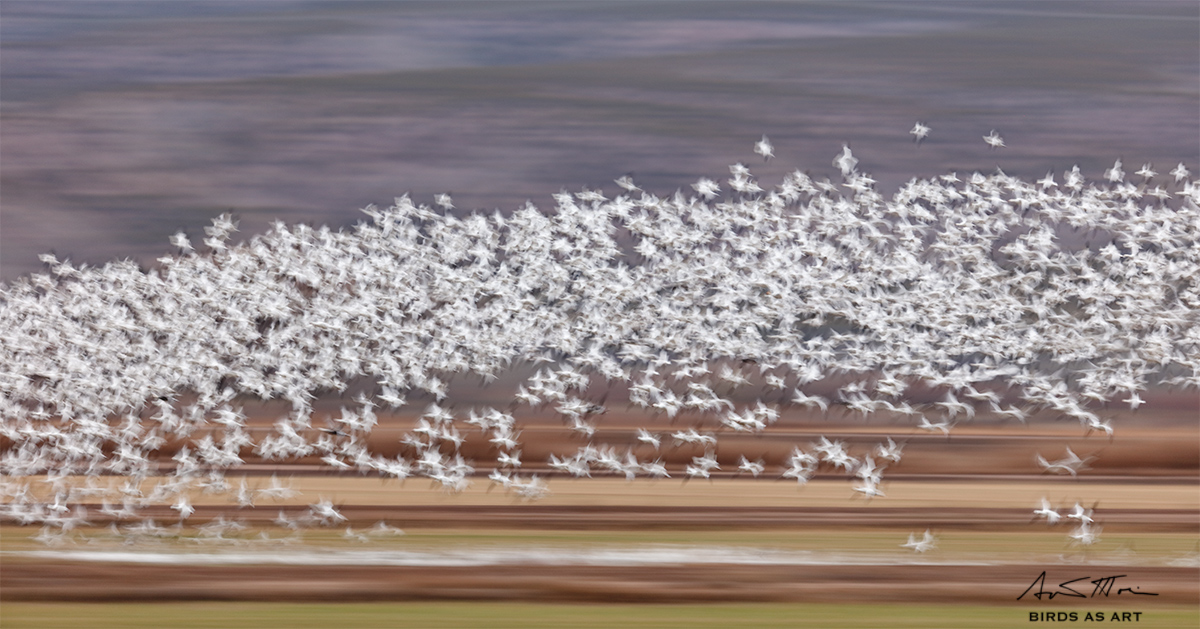
|
|
This image was created on Day 1 of the second 2015 Bosque IPT with the Induro tripod/Mongoose M3.6-mounted Canon EF 600mm f/4L IS II USM lens and the Canon EOS 5DS R. ISO 100. Evaluative metering -1/3 stop: 1/4 sec. at f/4 in Tv mode. AWB.
Center AF point (manual selection)/AI Servo/Rear Focus AF on the goose’s eye and re-compose. Click here to see the latest version of the Rear Focus Tutorial. Click on the image to see a larger version.
Snow Goose late blast-off
|
Geese along the tour loop road…
Late on Saturday afternoon the second IPT group was thrilled to see large numbers of geese blasting off at the north end of the tour loop road. We taught folks to work in Tv mode with Auto ISO (or ISO Safety Shift) as detailed in our various camera User’s Guides and to set the exposure compensation so that they wound up with properly exposed pleasing blurs. Most folks did great even though for many it was their first attempt.. On Sunday morning, there were some large groups of geese far back in the first field after the left turn. Time will tell as far as Sunday afternoon goes….
|

|
|
Learn the secrets of creating contest winning images in our “A Guide to Pleasing Blurs.”
|
A Guide to Pleasing Blurs
In our A Guide to Pleasing Blurs by Denise Ippolito and yours truly, we discuss just about every technique ever used mankind to create pleasingly blurred image. Ninety-nine point nine percent of pleasing blurs are not happy accidents. You can learn pretty much everything that there is to know about creating them in this instructive, well written, easy to follow guide.
|

|
|
Subject and focal lengths from upper left to right and then around to center.
Palouse Falls: 11mm; homemade kiddie race car: 105mm; barn siding pan blur: 798mm; Rolling fields diorama: 110mm; Crayola drums: 343 mm; Hay barn interior: 19mm; vintage gas station: 40mm; Dilapidated farm building: 13mm; Denise’s tree Infrared: 20mm.
Images and card design by Arthur Morris/BIRDS AS ART.
|
The Palouse ~ A Creative Adventure/BIRDS AS ART Instructional Photo-Tour (IPT)/Eastern Washington State. June 3-7, 2016/5 Full Days: $1699/Limit 12
The Palouse ~ A Creative Adventure/BIRDS AS ART Instructional Photo-Tour (IPT)/Eastern Washington State. June 10-14, 2016/5 Full Days: $1699/Limit 12
Double Header!
Maximize both your travel dollars and your learning experience by signing up for both IPTs.
|

|
|
Images and card design by Denise Ippolito/A Creative Adventure.
|
The Palouse IPTs
Rolling farmlands provide a magical patchwork of textures and colors, especially when viewed from the top of Steptoe Butte where we will likely enjoy spectacular sunrises and possibly a nice sunset. We will photograph grand landscapes and mini-scenics of the rolling hills and farm fields. We will take you to some really neat old abandoned barns and farmhouses in idyllic settings. There is no better way to improve your compositional and image design skills and to develop your creativity than to join us for this trip. Two great leaders: Denise Ippolito and Arthur Morris. Photoshop and image sharing sessions when we have the time and energy…. We get up early and stay out late and the days are long.
After 6 days of back-breaking scouting work in early June 2014 we found all of the iconic locations and, in addition, lots of spectacular new old barns and breath-taking landforms and views. On three additional scouting days in 2015 we discovered several more truly amazing locations. We will teach you what makes one situation prime and another seemingly similar one a waste of your time.
What’s included: In-the-field instruction, guidance, lessons, and inspiration, our newfound but very extensive knowledge of the area, all lunches, motel lobby grab and go breakfasts, and Photoshop and image sharing sessions when possible. There will be a meet and greet at 7:30pm on the evening before each workshop begins.
You will learn and hone both basic and advanced compositional and image design skills. You will learn to get the right exposure every time. You will learn to develop your creative eye. You will learn the basics of HDR (high dynamic range) photography. You will learn a variety of in-camera creative techniques. Most importantly you will learn to see the situation and to create a variety of top-notch images. Do see both of our blogs for lots more on that in the coming weeks. You will learn how the quality and direction of light combine to determine the success of your images. And–please don’t gasp–we will be working quite a bit with sidelight when creating landscapes. Lastly, we will be doing some infrared photography.
To Sign Up
A non-refundable $699 deposit is due now. The balance will be due on February 15, 2016. If we do not receive your check for the balance on or before the due date we will try to fill your spot from the waiting list. Whether or not your spot is filled, you will lose your deposit. If not, you can secure your spot by paying your balance.
With the spectacular success that we enjoyed in 2015 it seems quite likely that this one will fill up very quickly. Please let me know via e-mail that you will be joining us. Then you can either call Jim or Jennifer at 863-692-0906 during business hours or send us a check to leave a deposit; the latter is preferred. If by check, please make out to “Arthur Morris” and mail it to: Arthur Morris/BIRDS AS ART, PO Box 7245, Indian Lake Estates, FL, 33855. If you have any questions, please feel free to contact us via e-mail: artie or denise.
Travel Insurance Services offers a variety of plans and options. Included with the Elite Option or available as an upgrade to the Basic & Plus Options. You can also purchase Cancel for Any Reason Coverage that expands the list of reasons for your canceling to include things such as sudden work or family obligation and even a simple change of mind. You can learn more here: Travel Insurance Services. Do note that many plans require that you purchase your travel insurance within 14 days of our cashing your deposit check. Whenever purchasing travel insurance be sure to read the fine print carefully even when dealing with reputable firms like TSI.
Facebook
Be sure to like and follow BAA on Facebook by clicking on the logo link upper right. Tanks a stack!
Support the BAA Blog. Support the BAA Bulletins: Shop B&H here!
We want and need to keep providing you with the latest free information, photography and Photoshop lessons, and all manner of related information. Show your appreciation by making your purchases immediately after clicking on any of our B&H or Amazon Affiliate links in this blog post. Remember, B&H ain’t just photography!
…..
Amazon.com
Those who prefer to support BAA by shopping with Amazon may use this link:
Amazon Canada
Many kind folks from north of the border, eh, have e-mailed stating that they would love to help us out by using one of our affiliate links but that living in Canada and doing so presents numerous problems. Now, they can help us out by using our Amazon Canada affiliate link by starting their searches by clicking here. Many thanks to those who have written.
Typos
In all blog posts and Bulletins, feel free to e-mail or to leave a comment regarding any typos or errors. Just be right :).
November 29th, 2015 What’s Up?
I began wrapping this one up at 6:33pm on Saturday November 28, 2015. Denise Ippolito and I met our second IPT group and cancelled the meet and greet so that we could head right down to the refuge as things looked promising. We were rewarded with farm field blast off after farm field blast off. Finally. How sweet.
We have our introductory slide program at 7pm tonight so I need to get packing. I will finish this post either tonight or early tomorrow. BTW, I am feeling better each day (though still congested).
|
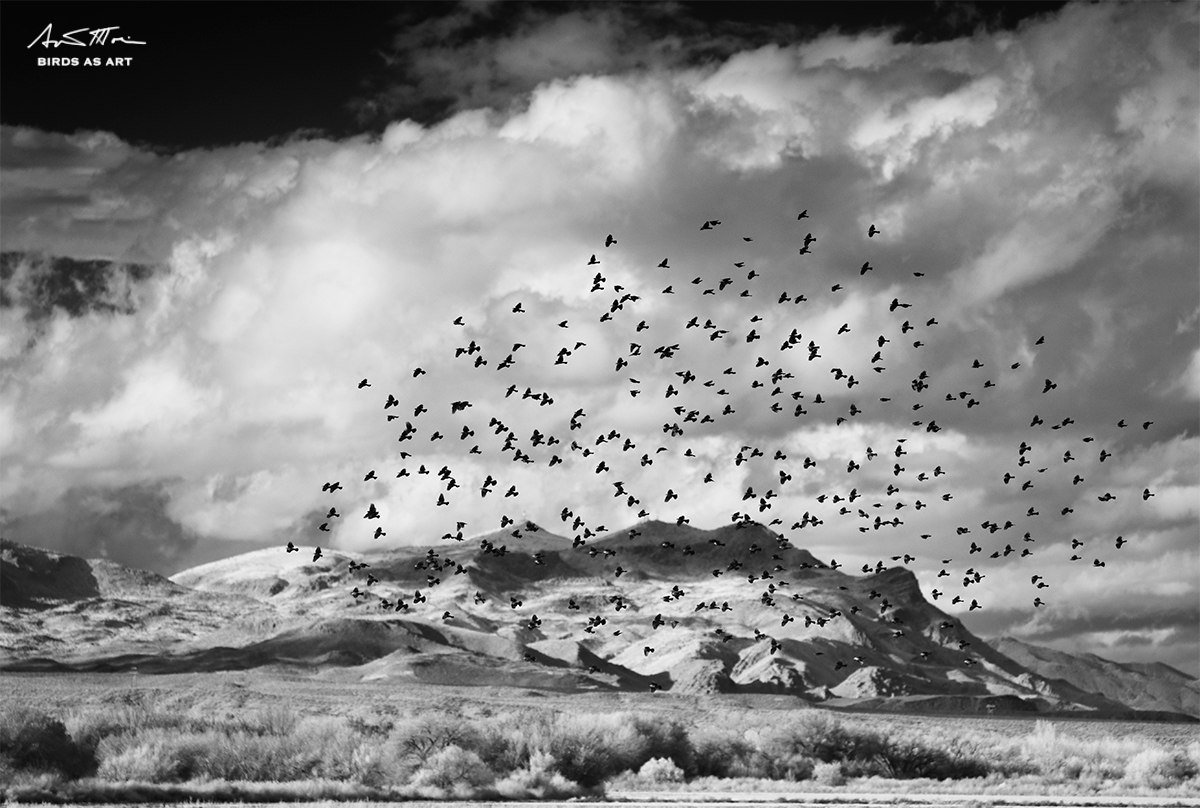
|
|
This image was on Thanksgiving Day at Bosque with the hand held Canon EF 100-400mm f/4.5-5.6L IS II USM lens (at 278mm) and my Kolari Vision-converted EOS-5D Mark II (now effectively replaced by the Canon EOS 5D Mark III.) ISO 800. Evaluative metering +2 stops: 1/800 sec. at f/5.6. Custom WB.
All 9 AF points/AI Servo/Shutter Button AF was active at the moment of exposure (as is always best when hand holding). Click on the image to see a larger version.
Red-winged Blackbird flock in front of mountains/IR > B&W
|
Why IR in this Situation?
Sun angle was down the road to the east. The wind was pretty good, from the southwest, and the cranes were coming in and landing nicely, but almost 90 degrees off sun angle. That all sounds pretty bad but the sky was filled with big, beautiful clouds. Bright sidelight and big clouds all scream IR. So IR it was. At first I tried for groups of cranes on the ground and in the clouds, but then a foraging flock of blackbirds–almost all young and female redwings, appeared so I concentrated on them.
The Image Processing
After converting the RAW file in DPP I brought it into Photoshop, made a new layer, and brought that layer into NIK Silver Efex Pro. I experimented with the various presets and wound up liking Grad ND (EV-1) best.
Kolari Vision BAA Discount
Get your camera converted to IR and enjoy a $10 discount by entering the code morris2015 in the Coupon code box at checkout. Then hit Apply Coupon and Update Cart. You will need to scroll down to see that your discount has been applied.
Note: denise and I share the small affiliate fee that we receive when you use our Kolari link.

Kolari Visions Infrared Camera Conversions
If you are ready to join the fun and have a camera converted to Infrared, use either the Kolari Vision logo-link above to order your conversion we will gladly send you our simple guide to properly setting a Custom White Balance for infrared photography at 720nm. Simply e-mail us your receipt and we will be glad to shoot you the PDF once your order appears in our affiliate account.
Kolari Visions prides themselves on their fast turnaround times and excellent customer service; they are getting better and faster as they employ several full time technicians to service everything as quickly as possible. The filters they use have been specifically designed for each camera and filter combination to be the optimal thickness for best autofocus performance between lenses, and the best corner sharpness. The filters also fit directly into the frame making the conversion non-damaging and reversible if needed. Others uses a few standard-sized thick filters that they calibrate the camera around. Doing this reaches accurate autofocus with their test lens. But when a filter is too thick for what the optics were designed for, the sharpness can suffer, particularly in the corners, and other lenses will not consistently focus accurately. Some other IR converters glue their filters directly to the sensor; that makes it almost impossible to revert back or to change the filter.
Kolari offers a comprehensive shop for infrared bodies; customers can order converted cameras directly from KV. Their focus on optical quality built from the ground up has allowed them to recently offer a service that improves the performance of Sony A7 series cameras to the level of the Leica M240 cameras. Content-wise, Kolari has a very comprehensive article list and an exhaustive lens performance database chock full of technical details. Soon, KV will feature an interactive gallery that will showcase different camera/filter picture combinations to get rid of some of the mystery of picking a camera to convert.
Choosing a Filter
Filter Choices
The text below is cut and pasted from an informative Kolari Visions’ article. You can access the complete photo illustrated tutorial by clicking here.
We currently have 6 filters to pick from. We offer the 720nm standard infrared, the 850nm deep infrared, the 665nm extra color infrared, the 590nm infrared, a full spectrum filter, and a two spectrum filter. All filters are the same price.
The Standard IR Filter (720nm) allows for good false color, and good contrast for black and white. This is equivalent to the Hoya R72 and the Wratten 89b.
The Ultra Color filter (590nm) lets more visible light in. It produces the most vibrant colors: leaves are golden yellow, skies are bright blue.
The Enhanced Color filter (665nm) has an effect between the 720nm and 590nm, producing more vibrant colors than the 720nm for pale yellow leaves and soft blue skies.
The Deep Black and White filter (850nm) is good for a dedicated black and white IR. The camera will produce images with bright whites and pronounced blacks. It is Equivalent to the Wratten 87c.
As above, after some serious thinking I converted my camera at 720nm. We did get a chance to experiment with Catherine Costolo’s super-color IR camera and had great fun. I will share an image or two made with her camera here with you at some point.
Costs
Kolari Vision offers economical IR conversions and did a great job with my camera.
Denise’s Infrared Gallery
If you are developing an interest in Infrared photography be sure to check out denise’s Infrared gallery here. See if you can figure out how she created the Milwaukee Road image. We would be glad to try to answer any basic IR questions that you have via e-mail as follows: artie or denise.
|

|
|
Subject and focal lengths from upper left to right and then around to center.
Palouse Falls: 11mm; homemade kiddie race car: 105mm; barn siding pan blur: 798mm; Rolling fields diorama: 110mm; Crayola drums: 343 mm; Hay barn interior: 19mm; vintage gas station: 40mm; Dilapidated farm building: 13mm; Denise’s tree Infrared: 20mm.
Images and card design by Arthur Morris/BIRDS AS ART.
|
The Palouse ~ A Creative Adventure/BIRDS AS ART Instructional Photo-Tour (IPT)/Eastern Washington State. June 3-7, 2016/5 Full Days: $1699/Limit 12
The Palouse ~ A Creative Adventure/BIRDS AS ART Instructional Photo-Tour (IPT)/Eastern Washington State. June 10-14, 2016/5 Full Days: $1699/Limit 12
Double Header!
Maximize both your travel dollars and your learning experience by signing up for both IPTs.
|

|
|
Images and card design by Denise Ippolito/A Creative Adventure.
|
The Palouse IPTs
Rolling farmlands provide a magical patchwork of textures and colors, especially when viewed from the top of Steptoe Butte where we will likely enjoy spectacular sunrises and possibly a nice sunset. We will photograph grand landscapes and mini-scenics of the rolling hills and farm fields. We will take you to some really neat old abandoned barns and farmhouses in idyllic settings. There is no better way to improve your compositional and image design skills and to develop your creativity than to join us for this trip. Two great leaders: Denise Ippolito and Arthur Morris. Photoshop and image sharing sessions when we have the time and energy…. We get up early and stay out late and the days are long.
After 6 days of back-breaking scouting work in early June 2014 we found all of the iconic locations and, in addition, lots of spectacular new old barns and breath-taking landforms and views. On three additional scouting days in 2015 we discovered several more truly amazing locations. We will teach you what makes one situation prime and another seemingly similar one a waste of your time.
What’s included: In-the-field instruction, guidance, lessons, and inspiration, our newfound but very extensive knowledge of the area, all lunches, motel lobby grab and go breakfasts, and Photoshop and image sharing sessions when possible. There will be a meet and greet at 7:30pm on the evening before each workshop begins.
You will learn and hone both basic and advanced compositional and image design skills. You will learn to get the right exposure every time. You will learn to develop your creative eye. You will learn the basics of HDR (high dynamic range) photography. You will learn a variety of in-camera creative techniques. Most importantly you will learn to see the situation and to create a variety of top-notch images. Do see both of our blogs for lots more on that in the coming weeks. You will learn how the quality and direction of light combine to determine the success of your images. And–please don’t gasp–we will be working quite a bit with sidelight when creating landscapes. Lastly, we will be doing some infrared photography.
To Sign Up
A non-refundable $699 deposit is due now. The balance will be due on February 15, 2016. If we do not receive your check for the balance on or before the due date we will try to fill your spot from the waiting list. Whether or not your spot is filled, you will lose your deposit. If not, you can secure your spot by paying your balance.
With the spectacular success that we enjoyed in 2015 it seems quite likely that this one will fill up very quickly. Please let me know via e-mail that you will be joining us. Then you can either call Jim or Jennifer at 863-692-0906 during business hours or send us a check to leave a deposit; the latter is preferred. If by check, please make out to “Arthur Morris” and mail it to: Arthur Morris/BIRDS AS ART, PO Box 7245, Indian Lake Estates, FL, 33855. If you have any questions, please feel free to contact us via e-mail: artie or denise.
Travel Insurance Services offers a variety of plans and options. Included with the Elite Option or available as an upgrade to the Basic & Plus Options. You can also purchase Cancel for Any Reason Coverage that expands the list of reasons for your canceling to include things such as sudden work or family obligation and even a simple change of mind. You can learn more here: Travel Insurance Services. Do note that many plans require that you purchase your travel insurance within 14 days of our cashing your deposit check. Whenever purchasing travel insurance be sure to read the fine print carefully even when dealing with reputable firms like TSI.
Facebook
Be sure to like and follow BAA on Facebook by clicking on the logo link upper right. Tanks a stack!
Support the BAA Blog. Support the BAA Bulletins: Shop B&H here!
We want and need to keep providing you with the latest free information, photography and Photoshop lessons, and all manner of related information. Show your appreciation by making your purchases immediately after clicking on any of our B&H or Amazon Affiliate links in this blog post. Remember, B&H ain’t just photography!
…..
Amazon.com
Those who prefer to support BAA by shopping with Amazon may use this link:
Amazon Canada
Many kind folks from north of the border, eh, have e-mailed stating that they would love to help us out by using one of our affiliate links but that living in Canada and doing so presents numerous problems. Now, they can help us out by using our Amazon Canada affiliate link by starting their searches by clicking here. Many thanks to those who have written.
Typos
In all blog posts and Bulletins, feel free to e-mail or to leave a comment regarding any typos or errors. Just be right :).
November 28th, 2015 What’s Up?
Other than a few minutes of bumps due to some rough air going in and out of Denver last week, my flights to ABQ on the 20th were long, exhausting, and thankfully un-eventful. I began working on this blog post during my layover in Denver and finished it in Socorro a week later, on the afternoon of the day after Thanksgiving.
Please Remember to shop the BAA Online Store, and to use our Affiliate Links 🙂
To show your appreciation for my continuing efforts here, we ask, as always, that you use our the B&H and Amazon affiliate links on the right side of the blog for all of your purchases. B&H is recommended for you major photography gear purchases, Amazon for your household, entertainment, and general purpose stuff. Please check the availability of all photographic accessories in the BIRDS AS ART Online Store, especially the Mongoose M3.6 tripod heads, Gitzo tripods, Wimberley heads and plates, LensCoats and accessories, and the like. We sell only what I have used, have tested, and can depend on. We will not sell you junk. We know what you need to make creating great images easy and fun. And we are always glad to answer your gear questions via e-mail. I just learned that my account was suspended during my absence; it should be up and running by Monday at the latest.
I would of course appreciate your using our B&H affiliate links for all of your major gear, video, and electronic purchases. For the photographic stuff mentioned in the paragraph above we, meaning BAA, would of course greatly appreciate your business. Here is a huge thank you to the many who have been using our links on a regular basis and visiting the BAA Online store as well.
|
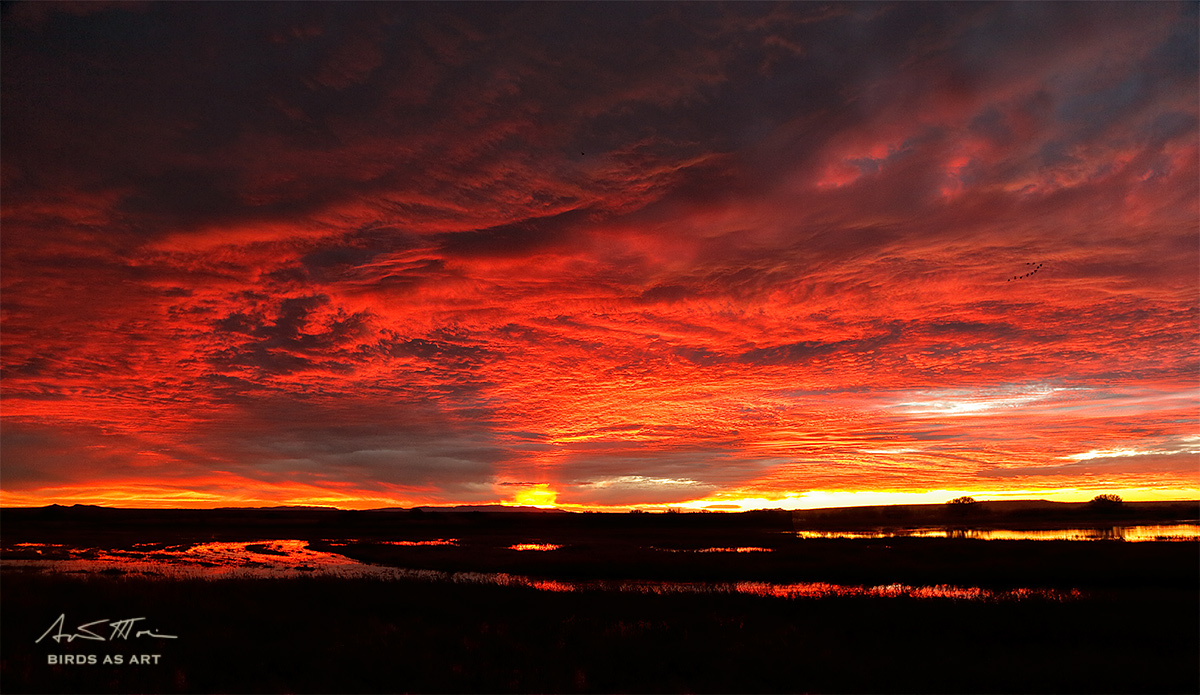
|
|
This image was created at Bosque del Apache NWR with the hand held Canon EF 24-105mm f/4L IS USM lens (at 24mm) and the rugged Canon EOS-1D X. ISO 800. Evaluative metering -1/3 stop: 1/60 sec. at f/4 in Tv Mode. Color temperature: 8100K.
Center AF point (Manual selection)AI Servo/Rear Focus AF on the distant horizon and re-compose. My left elbow was resting on the deck railing for support. Click here to see the latest version of the Rear Focus Tutorial. Click on the image to see a larger version.
Image #1: Spectacular sunrise without geese…
|
More than anyplace on the planet…
Bosque is like a good golf course. To do your best, you have to use all the clubs in your bag. I always bring a ton of gear to the refuge and I surely broke all records this year. More than anyplace on the planet you can make great images with lenses of any focal length. Today’s opening image is the wide version of yesterday’s “Mega-nuclear Sunrise.” If you missed that one, click here.
Exposure Question
Why did the image above need -1/3 stop EC while yesterday’s tighter shot was perfect at +1/3 stop?
Bosque Gear Bag
Once I decided to ship the 600 II and the 200-400 w/Internal 1.4X Extender to the IPT hotel via UPS Ground, the only choice I had to make was whether to bring the 100-400 II or the 70-200 f/2.8 L IS II that had served me well here for so many years…. Read on. I’d be glad to answer an Bosque gear questions that you have.
Canon EF 600mm f/4L IS II USM Lens The 600mm focal length lenses are perfect for photographing single cranes in flight in many situations and, with the addition of a 1.4X tele-converter, often perfect for photographing single geese in flight. I can increase versatility and focal length coverage by choosing either the 1D X or the 7D II according to the situation.
I learned recently that the latest version of the Nikon 600, the Nikon AF-S NIKKOR 600mm f/4E FL ED VR lens, (8.4 pounds) is actually (and finally) a bit lighter than the Canon 600 II (8.65 pounds). The last two versions of the Nikon 600s were absurdly heavy; in this age of “lighter and smaller” serious Nikon bird photographers should be thrilled.
Canon EF 200-400mm f/4L IS USM Lens with Internal 1.4x Extender. I have brought this great lens with me to Bosque ever since I got my hands on one several years ago. With its focal length range of from 200-560 (the latter available in an instant by engaging the internal TC), it is my absolute favorite for the pre-dawn geese fly-ins and fly outs.
Canon EF 100-400mm f/4.5-5.6L IS II USM lens. This versatile lens will be on my shoulder every time I get out of the car with either a full frame body or the 1.6 crop factor 7D II via a Black Rapid RS-7 strap. I finally remembered to bring a second RS-7 strap to Bosque so that I will have one less rig lying in the dirt at the farm fields and elsewhere. The 100-400 focal length fits nicely with the 600II and will be a perfect blast off lens.
Gear Question #1
What is the single huge advantage that the 200-400 f/4L IS lens w/internal extender (7.98 lbs) has over the 100-400II (3.5 lbs) for the pre-dawn fly-ins and blast offs?
Gear Question #2
For those who will be using the 100-400II as their daytime blast-off blur lens why is the smaller aperture (f/5.6 at 400mm) a non-factor as compared to the larger f/4 aperture of the the 200-400 f/4L IS lens w/internal extender?
Canon EF 70-200mm f/2.8L IS II USM lens I am sure that I might miss this intermediate telephoto zoom lens on occasion, especially when creating bird-scapes in low light on a tripod….But heck, there is just so much room in the trunk of our rental car.
Canon EF 24-105mm f/4L IS USM Lens. This all-purpose B-roll lens will be at hand for two weeks. It will spend a lot of time in my Vested Interest Xtrahand vest where it can be grabbed when needed.
I am bringing the Canon EF 16-35mm f/4L IS USM lens for south wind blast-offs and big sky images.
I am also bringing the old 15mm fish eye lens, now replaced by the “circle” lens, the Canon EF 8-15mm f/4L Fisheye.
Gear Question #3
Why would it be great to have either the 16-35 f/4 or the old 15mm fisheye lens on a 5D III for farmfield blastoffs at the cornfields on south winds?
Camera Bodies
EOS-1D X. I will use my rugged pro body both with the 600 II and with the 100-400 II, the latter in low light situations. The more powerful 1D X battery makes it better choice when I am working at 1200mm w/the 600II and the 2X III TC (with either a full frame body or the 7D II (rarely for the latter). As I needed to have the sensor professionally cleaned I have only a single 1DX on this trip.
5D Mark III. I will use the 5D III on the 100-400 II in low light blur and bird-scape situations to enjoy the larger file size.
EOS-7D Mark II. After the great success I enjoyed with the 7D II on the Falklands/South Georgia trips I am brought both of mine to Bosque this year.
The 5D II that was converted to IR by Kolari Vision was sent in advance by UPS Ground along with the two big lenses. Learn more about Kolari Vision and IR here or here.
|
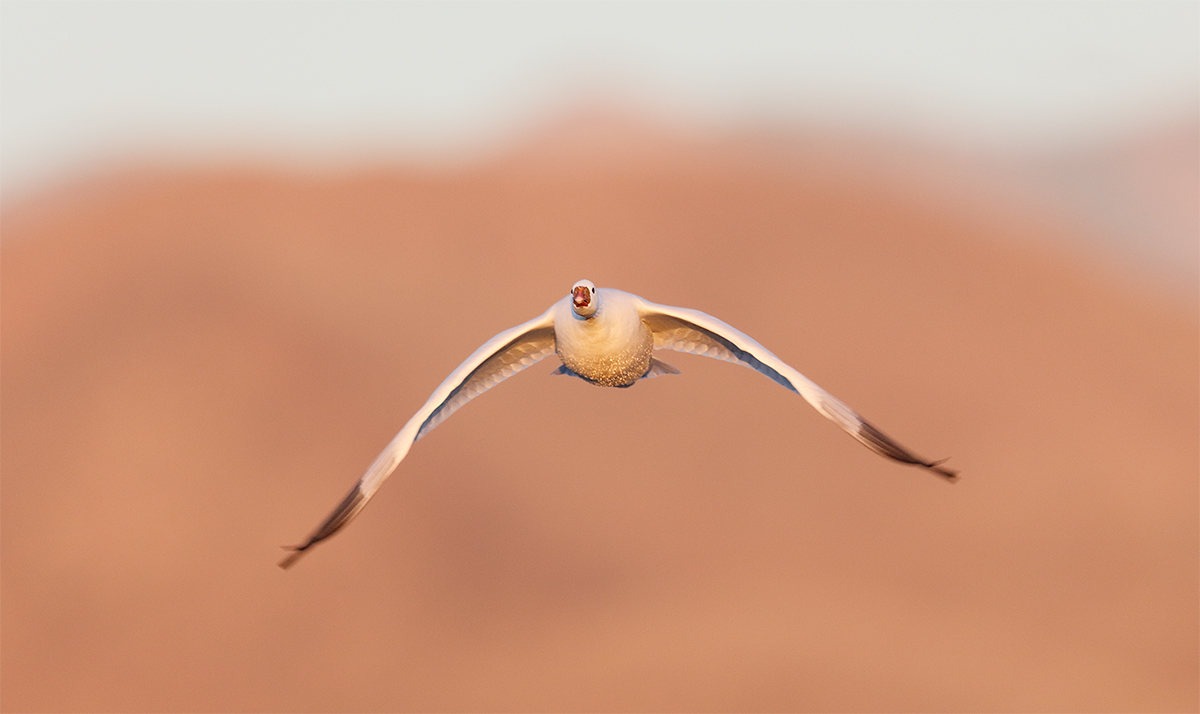
|
|
This image was created on the morning of Day 3 of the first 2015 Bosque IPT with the Induro tripod/Mongoose M3.6-mounted Canon EF 600mm f/4L IS II USM lens, the Canon Extender EF 1.4X III, and the Canon EOS 5DS R. ISO 800. Evaluative metering +2 1/3 stops off the light blue sky just above the mountains: 1/640 sec. at f/5.6 in Manual mode. Color temperature: AWB.
Center AF point (Manual selection)/AI Servo/Shutter Button AF was active at the moment of exposure. The selected AF point was on the left side of the bird’s breast just below the bird’s left eye (as originally framed). This image is a bit more than a 50% crop of the original image: 71.7mbs out of the original 144mb size of the TIFF file. Click on the image to see a larger version.
Image #2: Ross’s Goose in flight in early morning light
|
Yikes!
Talk about last but not least, I borrowed a Canon EOS 5DS R from B&H and after not trying it for a few days, have totally fallen in love with it. I am buying at least one as soon as I get home…. See here for my first impressions.
TCs
I will be making this trip with two Canon 1.4X III TCs and one 2X III TC. I lost one of my two 2X III TCs on Bleaker Island in the Falklands…. I need to replace it. Why so many TCs? With my style of bird photography–tight, clean, and graphic–I cannot afford to be without both TCs in the event of an accident or malfunction–or loss. 🙂 Most common in the malfunction category would be that the locking pin sticks occasionally. When that happens, there is a risk of having your camera body hit the ground….
Questions Welcome
If you have a question about any of my gear choices, or yours, please feel free to leave a comment. Do you disagree with any of my choices? What would you be brining to Bosque. And why?
Think Tank Rolling Bags
I will be using the larger of my two Think Tank rolling bags, the Airport Security™ V 2.0 Rolling Camera Bag. Except for the Singh-Ray polarizer and the two super-telephoto lenses that were shipped, everything above fits easily into my Airport Security™ V 2.0 Rolling Camera Bag. It tipped the scales at only 39 pounds; the legal limit for US flights is 40 pounds. Nearly all countries in the world give you slack as far as the 40 pounds goes on the way back to the US.
Think Tank Urban Disguise Laptop Shoulder Bag
Both denise and I use and love this amazing bag as it has tons of room and enables us to bring tons of extra stuff. It is like one of those circus Volkswagons….
Please click on my Think Tank affiliate link here to earn a free gift when you purchase a Think Tank Rolling Bag.
Delkin Flash Cards
As always, I will have a 64gb Delkin e-Film Pro Flash Card in each camera body so that I never have to change cards in the field thus reducing the risk of losing a card…. Please note the new lower prices here. I do have a few extra 32 and 64gb cards in a Delkin CF Memory Card Tote, mostly to protect against operator errors….
Facebook
Be sure to like and follow BAA on Facebook by clicking on the logo link upper right. Tanks a stack!
Support the BAA Blog. Support the BAA Bulletins: Shop B&H here!
We want and need to keep providing you with the latest free information, photography and Photoshop lessons, and all manner of related information. Show your appreciation by making your purchases immediately after clicking on any of our B&H or Amazon Affiliate links in this blog post. Remember, B&H ain’t just photography!
…..
Amazon.com
Those who prefer to support BAA by shopping with Amazon may use this link:
Amazon Canada
Many kind folks from north of the border, eh, have e-mailed stating that they would love to help us out by using one of our affiliate links but that living in Canada and doing so presents numerous problems. Now, they can help us out by using our Amazon Canada affiliate link by starting their searches by clicking here. Many thanks to those who have written.
Typos
In all blog posts and Bulletins, feel free to e-mail or to leave a comment regarding any typos or errors. Just be right :).
November 27th, 2015

 APPLE
15.4″ MacBook Pro Notebook Computer with Retina Display
Save $700 for a limited time only!
November 27th, 2015 What’s Up?
I wrote most of this blog post on Thanksgiving Day after a really short but really wonderful morning photo session. With the heavy cloud cover and the strong east wind, I knew that there was only one spot on the refuge that might offer some quality chances. I had been there the day before and it was dead. But on Thursday morning, it paid off in spades. As I said, it was the only game in town. (See Image #2.)
I felt much, much better on Thursday, the best I’ve felt in weeks. I had dinner with two friends at the El Camino Restaurant on the main drag in Socorro. My turkey special was quite good, so good that I ate much too much including a small piece of pumpkin pie for dessert.
How good did I feel? I went back to the refuge and photographed for four hours, almost all Infrared with my Kolari Vision converted 5D Mark II. With lots of dramatic clouds and a swirling flock of blackbirds I had a ton of fun in the sun. The sunset turned out to be a fizzle.
No dinner for me 🙂


|
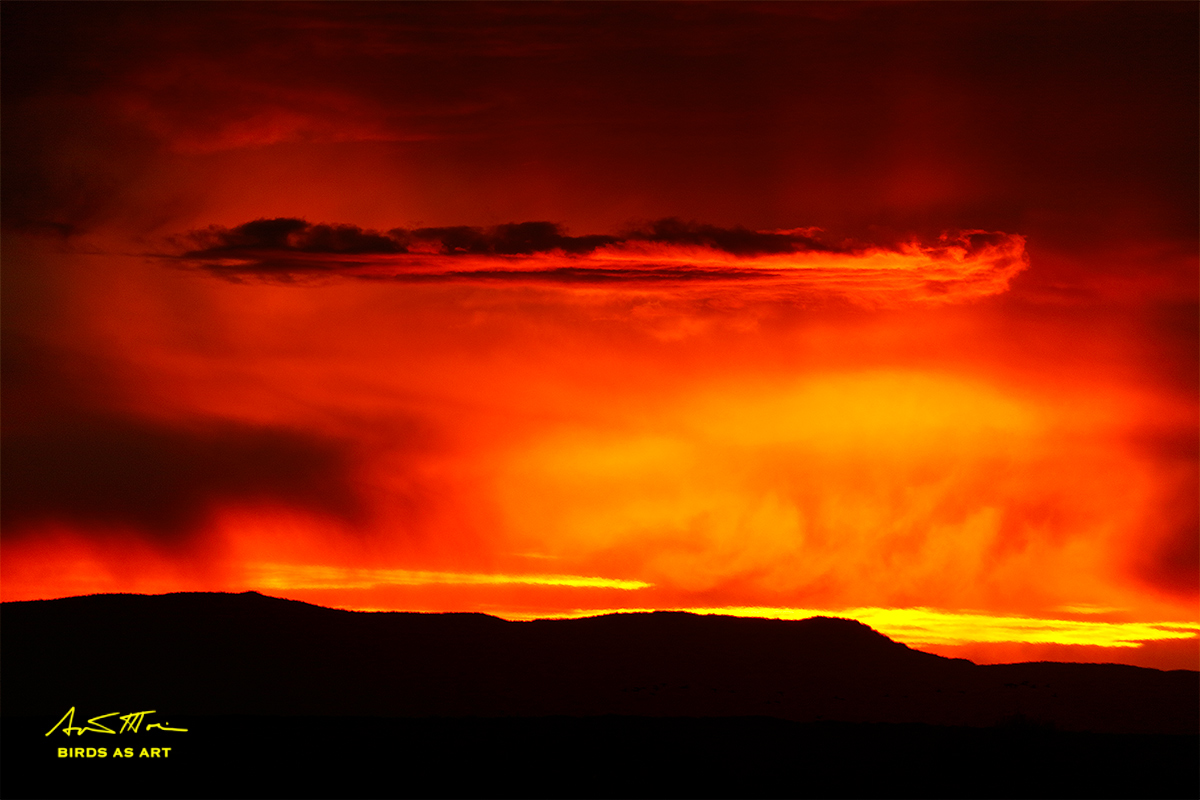
|
|
This image was created on the second morning of the first Bosque IPT with the Induro 304L Tripod/Mongoose M3.6-mounted Canon EF 200-400mm f/4L IS USM Lens with Internal 1.4x Extender (with the internal TC engaged at 420mm) and the Canon EOS 5DS R. ISO ?? Evaluative metering +1/3 stop: 1/125 sec. at f/5.6 in Tv mode. Color temperature: 8000K.
Center AF point/AI Servo Expand/Rear Focus AF as framed was active at the moment of exposure (as is always best when hand holding). Click here to see the latest version of the Rear Focus Tutorial. Click on the image to see a larger version.
Image #1: Mega-nuclear Sunrise
|
Bosque Being Bosque…
Bosque was really dead before we arrived. Then it was OK for a day or three. Then pretty lousy again. For the six days I have been here, I would rate it 3.5 out of ten as far as photographic opportunities. Now don’t get me wrong, everyone on the first IPT enjoyed lots of great chances and learned a ton, in part because of two great instructors and in part because after 21 years, I know where to be when with these sky conditions and that wind.
It is a very strange year for a variety of reasons. Aside for the first session, there has not been the traditional early morning fly-in. Numbers of geese are clearly down, possibly due to a lack of food on the refuge, and they are roosting in distant pools way north and east of the main impoundment. When they blast off, the head straight north. And disappear. There have been very few geese anywhere near the north tour loop road for the past few days. One afternoon we drove both the north and south loops and saw a grand total of one Snow Goose. But we wound up having a great afternoon anyway.
Bosque being Bosque; it can disappoint one day and leave you in tears the next….
|
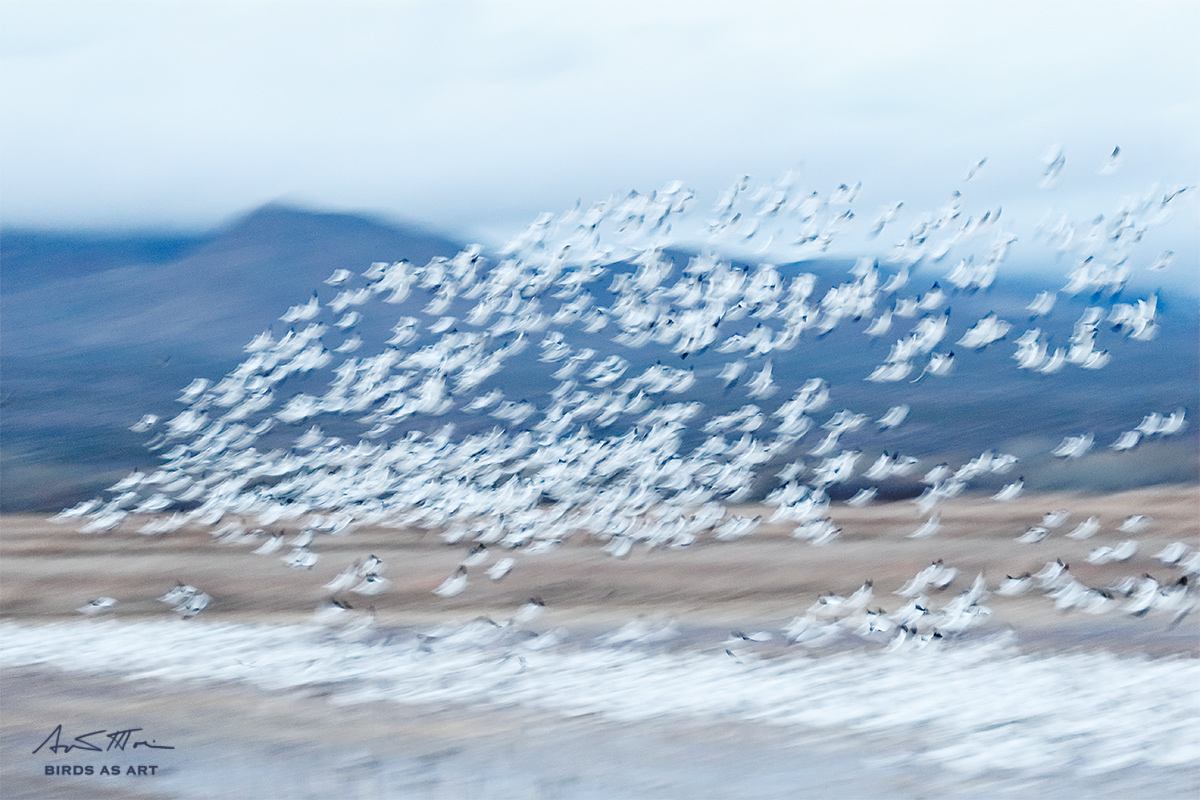
|
|
This image was created at Bosque del Apache on Thanksgiving morning with the hand held Canon EF 100-400mm f/4.5-5.6L IS II USM lens (at 170mm) and the rugged Canon EOS-1D X.. ISO: ?? Evaluative metering +1 stop: 1/15 sec. at f/5.6 in Tv mode. Color temperature: 8100K (a fortuitous error).
Center AF point (Manual selection/Rear Focus AF as framed was active at the moment of exposure (as is always best when hand holding). Click here to see the latest version of the Rear Focus Tutorial. Click on the image to see a larger version.
Image #2: Pre-dawn white geese blast off
|
ISO Challenge
What do you think the ISO was for image #1? What do you think it was for image #2?
Your Favorite?
Which image is your favorite? And why?
Facebook
Be sure to like and follow BAA on Facebook by clicking on the logo link upper right. Tanks a stack!
Support the BAA Blog. Support the BAA Bulletins: Shop B&H here!


We want and need to keep providing you with the latest free information, photography and Photoshop lessons, and all manner of related information. Show your appreciation by making your purchases immediately after clicking on any of our B&H or Amazon Affiliate links in this blog post. Remember, B&H ain’t just photography!
Amazon.com
Those who prefer to support BAA by shopping with Amazon may click on the logo-link immediately above.
Amazon Canada
Many kind folks from north of the border, eh, have e-mailed stating that they would love to help us out by using one of our affiliate links but that living in Canada and doing so presents numerous problems. Now, they can help us out by using our Amazon Canada affiliate link by starting their searches by clicking here. Many thanks to those who have written.
Typos
In all blog posts and Bulletins, feel free to e-mail or to leave a comment regarding any typos or errors. Just be right :).
November 26th, 2015
|
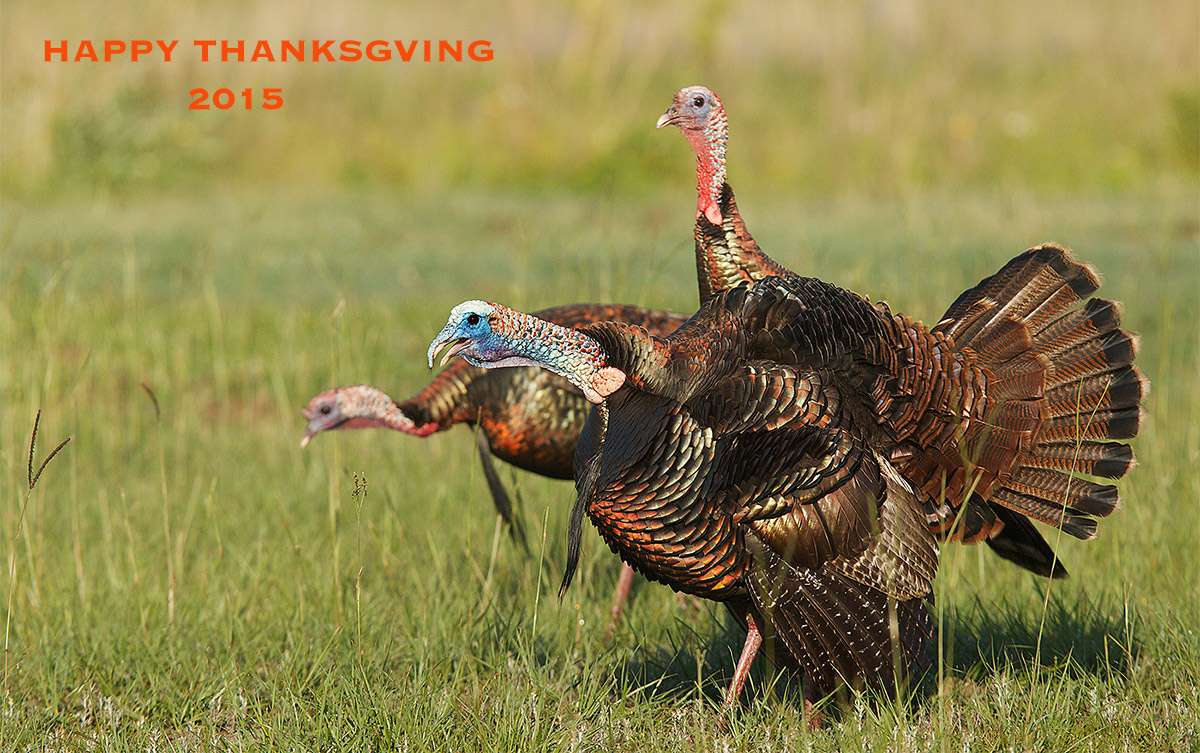
|
|
Enjoy the holiday and try not to eat too, too much.
|
Happy Bird-Day 2015
All here at BAA would like to wish you and yours a happy Thanksgiving. My older daughter Jennifer is on Long Island with her whole family visiting her sister–my younger daughter Alissa and her family–along with my Mom and my younger sister Arna. My right hand man Jim Litzenberg and his wife will be busy serving dinner to the less fortunate over on the east coast of Florida as they have done for the past 5 years.
With everyone away for the holiday BIRDS AS ART will be closed until Monday, November 30. We look forward to meeting your IPT and mail order needs when things get back to normal.


What’s Up?
I went to the refuge on Wednesday morning where I enjoyed yet another breathtaking but pretty much bird-less sunrise…. I felt a lot better than I had on Tuesday with the murderous coughing spells greatly reduced. I went to the ER in Socorro for a lung x-ray. Everyone there was very nice. I was in the examining room in minutes and checked in soon thereafter. After my history was taken I saw the doctor. She said that my lungs sounded clear and ordered the desired chest x-rays. They were done quickly but it took about two hours until the x-rays were read. But the news was great: my lungs were clear with no sign of pneumonia.
In he afternoon I noticed some pain in my right mid-back. It always takes me a few minutes to recognize the source. I am passing a small kidney stone. The way Dr. Oliver has taught me to read and understand my body I realized that there was very likely some connection between the cough/cold and the kidney stone. I gave him a buzz and asked him if I was right. “Absolutely–the Thera-Flu that you took has antihistamines in it. They dry you out internally. Bingo.
After my first very painful kidney stone episode at Point Pelee more than a few years ago, I almost always have some D-Mannose on hand. It is a sugar that coats the ureter making it easier to pass small stones. The funny thing is that I looked at the jar of D-Mannose on the counter and thought about bringing it to New Mexico. But did not. When it rains, it pours. And please do not try to get D-Mannose in Socorro, NM….
I will likely head down to the refuge for an hour or two on Thanksgiving morning and then rest up with a day of NFL games on the tube.
Selling Your Used Photo Gear Through BIRDS AS ART
Selling your used (or like-new) photo gear through the BAA Blog or via a BAA Online Bulletin is a great idea. We charge only a 5% commission. One of the more popular used gear for sale sites charges a minimum of 20% plus assorted fees! Yikes. The minimum item price here is $500. If you are interested please e-mail with the words Items for Sale Info Request cut and pasted into the Subject line :). Stuff that is priced fairly–I offer free pricing advise, usually sells in no time flat.
Canon EOS-1D Mark IV professional digital camera body
Friend and multiple IPT veteran Larry Master is offering a Canon EOS-1D Mark IV professional digital camera body in excellent condition for $1399. The sale includes the original box, the camera manual, the front cap, all cables and CDs, and insured shipping by UPS Ground to US addresses only. Personal checks only; your camera will be shipped only after your check clears.
Interested folks may contact Larry on his cell phone at 518-645-1545 or via e-mail.
Two rugged 1D Mark IVs served as my workhorse professional bodies for several years. artie
Facebook
Be sure to like and follow BAA on Facebook by clicking on the logo link upper right. Tanks a stack!
Support the BAA Blog. Support the BAA Bulletins: Shop B&H here!


We want and need to keep providing you with the latest free information, photography and Photoshop lessons, and all manner of related information. Show your appreciation by making your purchases immediately after clicking on any of our B&H or Amazon Affiliate links in this blog post. Remember, B&H ain’t just photography!
Amazon.com
Those who prefer to support BAA by shopping with Amazon may click on the logo-link immediately above.
Amazon Canada
Many kind folks from north of the border, eh, have e-mailed stating that they would love to help us out by using one of our affiliate links but that living in Canada and doing so presents numerous problems. Now, they can help us out by using our Amazon Canada affiliate link by starting their searches by clicking here. Many thanks to those who have written.
Typos
In all blog posts and Bulletins, feel free to e-mail or to leave a comment regarding any typos or errors. Just be right :).
November 25th, 2015 What’s Up?
I am feeling lot better as I type early on the morning of Wednesday November 25, 2015. I am much less congested but the dry hacking coughing spells that I had off and on yesterday were not fun. My plan is to get a chest X-ray done today.
I will be heading out for sunrise in a few and follow that up with a day of rest. The next IPT group begins on Saturday afternoon. The first group had a ball despite overall bad luck and relatively poor conditions so far. There were lots of goodbye hugs at the crane pool last night….
If…
If you are inspired to purchase a 5DS R by what you read or see here on the blog over the next few weeks please remember to use my B&H product specific links to purchase yours from B&H. Many thanks, and happy bird-day tomorrow.
Enjoy the Blog?
Do you enjoy reading the blog? Do you learn something on most visits? Are you all set as far as gear goes? If yes to all of those, please consider making a BAA Blog Thank You Donation by clicking here. And if you do need some new gear, please use my affiliate links, most especially, the B&H affiliate logo link just to the right of this text. Simply click and begin your search and shopping spree :). Note: web orders only. Also, there will be no indication that your purchases will be tracked to BAA. The tracking is invisible. That’s why we ask folks to send us their B&H receipts for major purchases via e-mail. Please remember: no phone orders…. Many thanks for considering these requests. a

Induro $50 Instant Rebate
The Induro $50 instant rebate will last only until the end of this year. Click on the logo-link above to save $50 on our favorite tripods. On our recent grueling trip to the Southern Ocean Denise loved her new GIT 304 and I love my new GIT 304L. Both performed flawlessly in the mud, snow and ice.
Induro GIT 404L Super Sale Correction!
For a limited time only the Induro GIT 404L is being offered for the ridiculously low price of $470 (including the $50 instant rebate). I apologize for the $370 typo that appeared in yesterday’s blog.) The best news is that the $470 price will be offered for at least a few days more.
The Induro GIT 404L is a 4-leg section Grand Series tripod. It is slightly bigger and one pound heavier than the GIT 304L; it is the perfect tripod for those using big glass who would like a bit more stability.
|
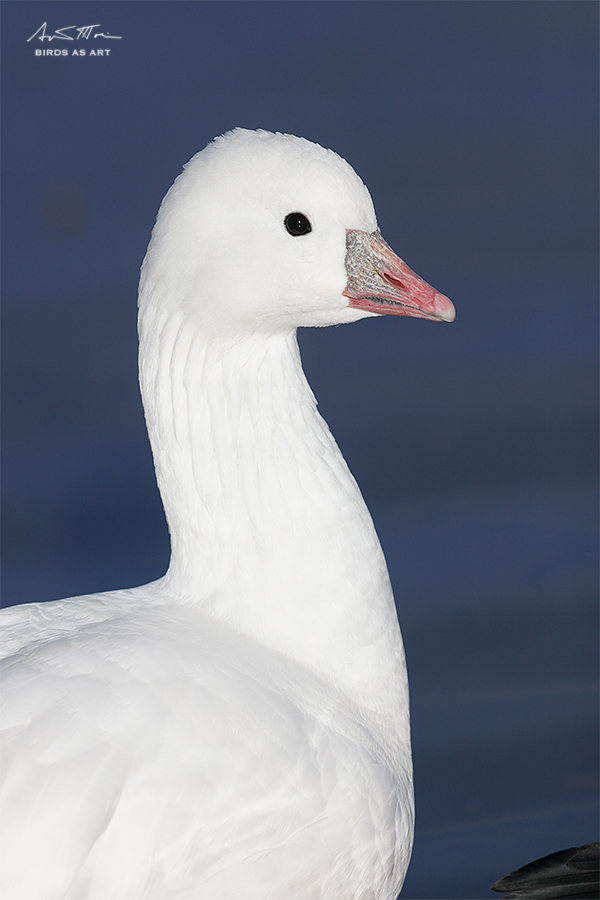
|
|
This image was created on Day 2 of the first 2015 Bosque IPT with the Induro tripod/Mongoose M3.6-mounted Canon EF 600mm f/4L IS II USM lens, the Canon Extender EF 1.4X III, and the Canon EOS 5DS R. ISO 400. Evaluative metering at zero: 1/2500 sec. at f/8 in Manual mode. AWB.
Center AF point (manual selection)/AI Servo/Rear Focus AF on the goose’s eye and re-compose. Click here to see the latest version of the Rear Focus Tutorial. Click on the image to see a larger version.
Image #1: Ross’s Goose vertical head and neck portrait
|
Canon EOS-5DS R for Birds: An Overview
I borrowed a full frame 50.6 megapixel EOS-5DS R from B&H for the Bosque trip and used it for the first time on Monday afternoon. To say that I was impressed is an understatement. For those coming from a 5D III or a 7D II there is virtually no learning curve (though there were a few quirky items). AF is surprisingly quick and sure and the AF system is pretty much the same as on the two previously mentioned cameras. Five frames/second seems a bit clunky as compared to the 1D X but for my style of bird photography where I rarely hold the hammer down the slower frame rate is not much of a hindrance. And having what amounts to a medium format DSLR for sports and nature photography is hard to comprehend.
I have been using the 5DS R with my 600 ever since I saw the first image files and right now I am planning on buying a 5DS R as soon as I get home…
|
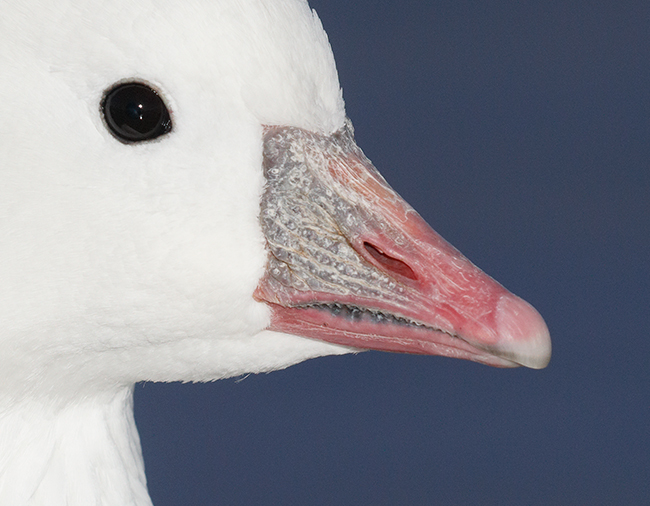
|
|
This is a 100% crop of the optimized TIFF for today’s featured image that was sized to 600 pixels wide and then displayed at 475 pixels wide. Image quality with the 5DS R is really hard to believe.
|
I’ve never seen image files like these…
At lunch on Tuesday I shared a head portrait of a young blue morph Snow Goose at 100% with the group; everyone gasped when they saw the fine feather detail and the incredible resolution. Some folks were breathless. I have never seen images files with detail like a sharply focused 5DS R image file. I will be sharing lots more 5DS R images with you here in the near future.
|
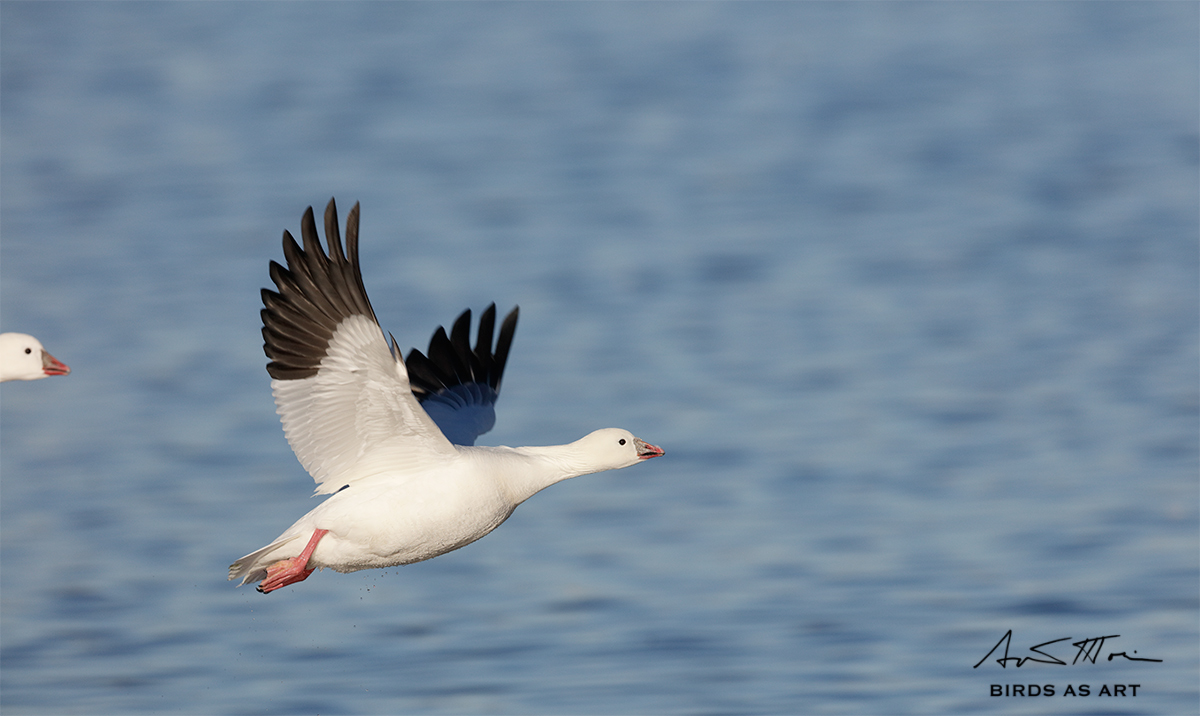
|
|
This image was also created on Day 2 of the first 2015 Bosque IPT with the Induro tripod/Mongoose M3.6-mounted Canon EF 600mm f/4L IS II USM lens, the Canon Extender EF 1.4X III, and the Canon EOS 5DS R. ISO 400. Evaluative metering -1/3 stop as framed: 1/2000 sec. at f/8 in Manual mode. AWB.
Center AF point/AI Servo Expand/Rear Focus AF was active at the moment of exposure. The selected AF point was just above the bird’s eye as originally framed. This image is a small crop from the original. Click here to see the latest version of the Rear Focus Tutorial. Click on the image to see a larger version.
Image #1: Ross’s Goose taking flight
|
5DS R AF
I was pleasantly surprised by the speed and accuracy of the AF system and AF tracking accuracy. Lots more to come on this topic.
|
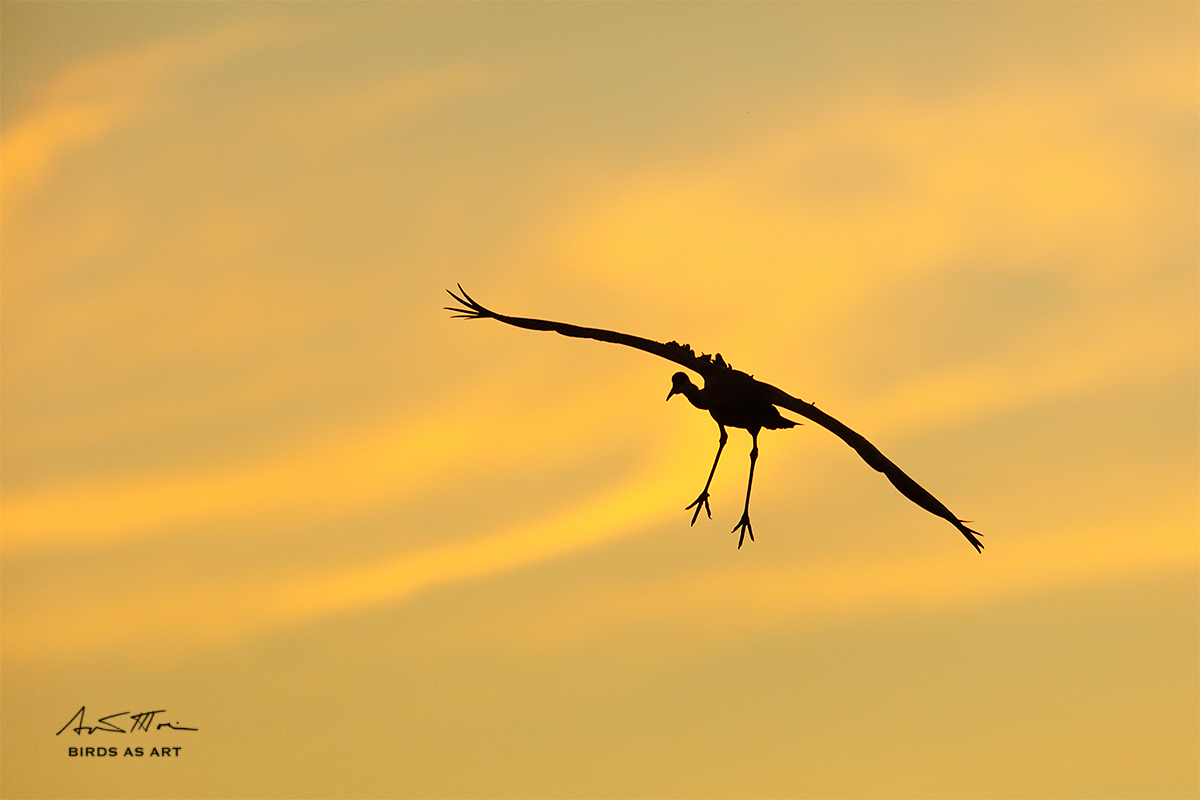
|
|
This image too was also created on Day 2 of the first 2015 Bosque IPT with the Induro tripod/Mongoose M3.6-mounted Canon EF 600mm f/4L IS II USM lens, the Canon Extender EF 1.4X III, and the Canon EOS 5DS R. ISO 1600. Evaluative metering +2/3 stop as framed: 1/1600 sec. at f/5.6 in Manual mode. Color temperature: K8000.
Center AF point/AI Servo Expand/Shutter Button AF was active at the moment of exposure. The selected AF point was just below the tip of the bird’s bill so the assist points were likely instrument in the accurate focus. This image is a small crop from the original from the right and below. Click on the image to see a larger version.
Image #3: Sandhill Crane sunset silhouette/landing gear down.
|
High ISO with the 5DS R
I have not done much with the higher 5DS R ISOs yet. The lack of background noise in this crane landing silhouette noise is impressive. After the trip I will get a bunch of 5DS R Raw files to Arash to see what he thinks about the noise. And about the fine feather detail.
What Do You Think?
What do you think of the 5DS R images? Which of the three is your favorite? Why?
Mid-Morning Update from the ER
Two things that I had wanted to mention:
1-Though I never filled the buffer–I rarely do–I did notice that when I took two or three images in a row that it took a few seconds to be able to view the histogram via image review.
2-Seeing the JPEGs here cannot give you any idea of the incredible detail that you see when viewing a sharp image at 100% on a Macbook Pro with retina display.
Facebook
Be sure to like and follow BAA on Facebook by clicking on the logo link upper right. Tanks a stack!
Support the BAA Blog. Support the BAA Bulletins: Shop B&H here!


We want and need to keep providing you with the latest free information, photography and Photoshop lessons, and all manner of related information. Show your appreciation by making your purchases immediately after clicking on any of our B&H or Amazon Affiliate links in this blog post. Remember, B&H ain’t just photography!
Amazon.com
Those who prefer to support BAA by shopping with Amazon may click on the logo-link immediately above.
Amazon Canada
Many kind folks from north of the border, eh, have e-mailed stating that they would love to help us out by using one of our affiliate links but that living in Canada and doing so presents numerous problems. Now, they can help us out by using our Amazon Canada affiliate link by starting their searches by clicking here. Many thanks to those who have written.
Typos
In all blog posts and Bulletins, feel free to e-mail or to leave a comment regarding any typos or errors. Just be right :).
November 24th, 2015 What’s Up?
Bosque was terrible before we arrived but things are looking much better right now. Again I enjoyed a horrific night’s sleep and can finally say that I feel pretty lousy with a stuffed nose, chest congestion, and a dry hacking cough, all of which kept me up most of the night. I gave up on sleep at 3am and went to work on the laptop. Still no sore throat. I am hoping not to wind up in the hospital but till then I will be out there teaching and photographing….
If however, I still feel this lousy by Wednesday, I may take a few days off to rest between IPTs….
Enjoy the Blog?
Do you enjoy reading the blog? Do you learn something on most visits? Are you all set as far as gear goes? If yes to all of those, please consider making a BAA Blog Thank You Donation by clicking here. And if you do need some new gear, please use my affiliate links, most especially, the B&H affiliate logo link just to the right of this text. Simply click and begin your search and shopping spree :). Note: web orders only. Also, there will be no indication that your purchases will be tracked to BAA. The tracking is invisible. That’s why we ask folks to send us their B&H receipts for major purchases via e-mail. Please remember: no phone orders…. Many thanks for considering these requests. a

Induro $50 Instant Rebate
The Induro $50 instant rebate will last only until the end of this year. Click on the logo-link above to save $50 on our favorite tripods. On our recent grueling trip to the Southern Ocean Denise loved her new GIT 304 and I love my new GIT 304L. Both performed flawlessly in the mud, snow and ice.
Induro GIT 404L Super Sale!
For a limited time only the Induro GIT 404L is being offered for the ridiculously low price of $370 (including the $50 instant rebate). The Induro GIT 404L is a 4-leg section Grand Series tripod. It is slightly bigger and one pound heavier than the GIT 304L; it is the perfect tripod for those using big glass who would like a bit more stability.

Gura Gear Backpack Blowout
I do not use a backpack. But many of my and denise’s clients who do have long raved about the Guru Gear backpacks. As have many professionals. These great photo backpacks are being phased out and will not be replaced in their present form. Take advantage of the huge price reductions on three popular models, the Bataflae 26L, the Bataflae 32L, and the Bataflae 18L, and enjoy a superbly high quality backpack that with its sturdy, high end zippers and durable fabric will serve you well for many years.
|

|
|
This image was created on the first afternoon of the first Bosque IPT on the morning of Sunday, November 22, 2015 with the hand held Canon EF 400mm f/4 DO IS II USM lens, the Canon Extender EF 1.4X III, and the amazing Canon EOS 7D Mark II. ISO 400. Evaluative metering +1 stop off the light blue sky: 1/3200 sec. at f/7.1.
Center AF point/AI Servo Expand/Shutter Button AF as framed was active at the moment of exposure (as is always best when hand holding). Click on the image to see a larger version.
Four White Geese…
|
The Intermediate View
99% of the avian images that I have created over the past 32 years fall into one of these categories: images of a single bird; images of a single bird in flight; images of two birds interacting; tight head portraits or body parts images; bird-scapes featuring a small-in-the-frame subject or a small flocks of birds set in beautiful habitat (many folks call these environmental or habitat images); or large frame-filling images of flocks of birds in flight, often intentionally blurred, and often referred to as pure pattern shots.
What’s missing? Images featuring 3-10 avian subjects in the same frame. These intermediate views are very difficult to pull off successfully for a variety of reasons:
1-The subject often overlap creating unpleasant merges.
2-coming up with a pleasing arrangement or grouping without clipping any wingtips or subjects on the edge of the frame is a big challenge. Zoom lenses help here of course.
3-getting 3 or 5 or 8 good head angles in a single frame is nearly impossible.
4-with images of groups of birds in flight, it is nearly impossible to come up with all good wing positions.
Lunch Time Comment Hits Paydirt…
During our first image review session I showed about 25 images of groups of geese with about 6-10 birds in each image. All of the images were deleted for a variety of reasons:
1-the image was poorly framed.
2-one or more (often many) of the birds showed less than ideal wing positions.
I said to the group, “Why take so many images like these when the chances of success are miniscule? ”
The answer: “Once in a while you hit bingo!” I advised them to frame the images as well as the could after acquiring focus and then hold the shutter button down for at least a few images. I said to them, “You have many thousands of dollars (if not tens of thousands) worth of gear and you spent a lot of money to get here. What does it cost you to push the shutter button when a situation offers a potential payoff in the form of a good image?”
Then I went out and hit bingo.
ID Challenge
Can you identify each of the four adult birds in today’s featured image to species starting with the leftmost bird and going clockwise?
Facebook
Be sure to like and follow BAA on Facebook by clicking on the logo link upper right. Tanks a stack!
Support the BAA Blog. Support the BAA Bulletins: Shop B&H here!


We want and need to keep providing you with the latest free information, photography and Photoshop lessons, and all manner of related information. Show your appreciation by making your purchases immediately after clicking on any of our B&H or Amazon Affiliate links in this blog post. Remember, B&H ain’t just photography!
Amazon.com
Those who prefer to support BAA by shopping with Amazon may click on the logo-link immediately above.
Amazon Canada
Many kind folks from north of the border, eh, have e-mailed stating that they would love to help us out by using one of our affiliate links but that living in Canada and doing so presents numerous problems. Now, they can help us out by using our Amazon Canada affiliate link by starting their searches by clicking here. Many thanks to those who have written.
Typos
In all blog posts and Bulletins, feel free to e-mail or to leave a comment regarding any typos or errors. Just be right :).
November 23rd, 2015 What’s Up?
I wrote most of this blog post on the ship and am finishing it up early on the morning of Sunday November 22, 2015. I have been working since 2:30am, after sleeping fitfully for five hours. It was a rough night as, with a mega-stuffed nose, I peeked at the clock every 20 minutes or so…. Happily, still no sore throat. But I have begun feeling pretty lousy 🙂
We have our first morning Bosque IPT session in exactly one hour. This blog post took several hours to assemble, that with lots of help from Pauline Carr. Many thanks Pauline.
|
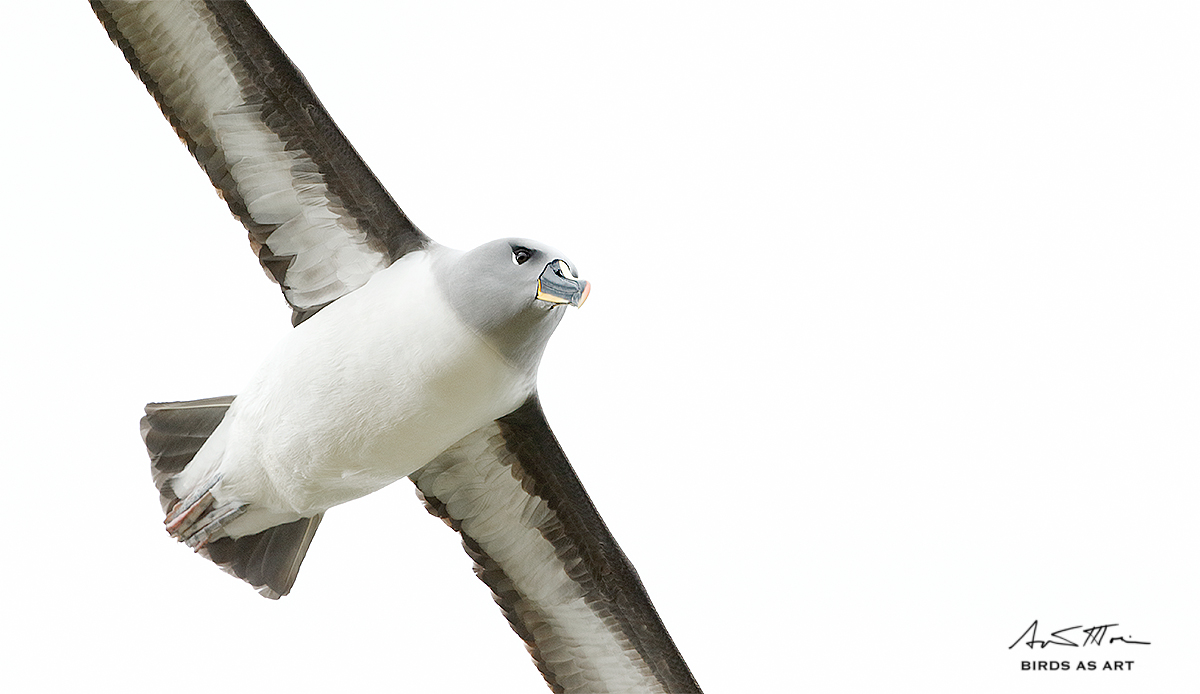
|
|
This image was created at Elsehul, South Georgia with the hand held Canon EF 400mm f/4 DO IS II USM lens and the rugged professional body, the Canon EOS-1D X. ISO 500. Evaluative metering +2/3 stop off the green water below: 1/2500 sec. at f/4 in Manual mode. AWB.
Center AF point (Manual selection)/AI Servo/Shutter Button Focus AF as originally framed was active at the moment of exposure. The selected AF point was on the tip of the bird’s bill; the previous frame was not focused accurately. Click on the image to see a larger version.
Grey-headed Albatross tight flight image
|
Getting Older and Seeing the Situation…
The expedition staff let us know that the hike to the grey-headed nest would be long and arduous. I knew right off the bat that the long, steep climb through tussock grass and mud was physically beyond me. And beyond several others in the BAA group. As we landed I saw lots of Grey-headed and Light Mantled Sooty Albatrosses flying over a bluff just above the beach. Expedition staff leader team Tim Carr had found a nest of the latter species just beyond the bluff. I asked for and received permission to make the moderate climb to the top of the bluff and hang out waiting for some albatrosses and giant petrels to fly by. The going was tough at first but those who joined me and persisted enjoyed some very good chances.
Tight Flight Miracle
When photographing birds in flight I encourage folks to try to keep shooting as the birds get closer. Maintaining accurate focus on the face as they approach point blank range is difficult. Properly framing the image so as to get the tail in the frame is a near-impossibility. If, however, you do not try, it is guaranteed that you will never succeed.
The story of a critically endangered albatross species…
Grey-headed Albatross is a critically endangered species; the epicenter of their population is centered around Elsehul and several other nearby islands in South Georgia. Most fatalities are the result of long line fishing for swordfish and tuna. Lines with tens of thousands of baited hooks, some as long as 40 nautical miles (and even triple that length!), are deployed. As the lines are tossed overboard many species of albatross grab the bait and those that are hooked succumb quickly.
To reduce mortality fishing within 200 miles of in South Georgia and a massive surrounding area, active fishing is permitted only at night, the long lines are weighted to sink the bait more quickly, distracting streamer lines are employed, the dumping of offal while the lines are being set is not permitted, and each ship has an observer aboard. Because boats that catch six birds of any species must stop fishing and leave the protected area the crews are very, very careful and bird deaths have been greatly reduced.
The stark numbers reveal that there are now about 16,000 pairs of Grey-headed Albatross down from 84,000 pairs in the early 1990s.
As noted previously, everything above in italics is courtesy of Pauline Carr via personal comment on the ship. (See more on Pauline and Tim Carr here.)
|
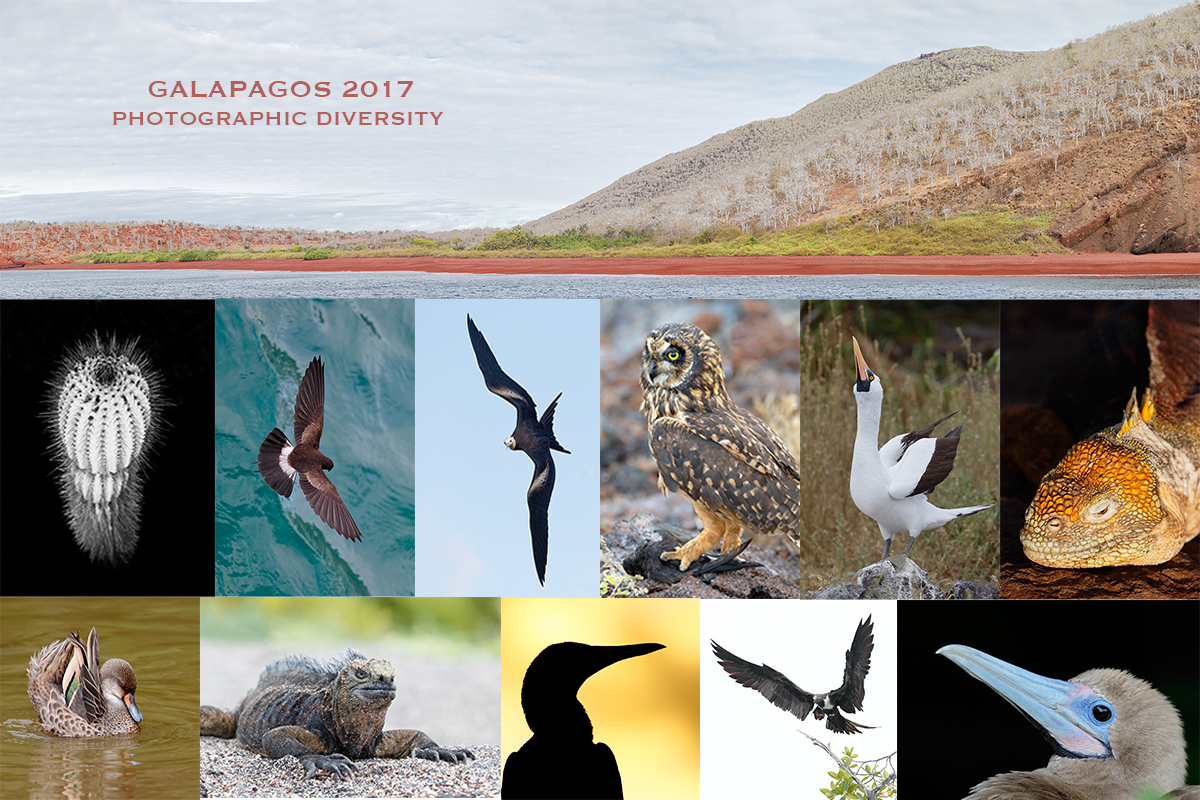
|
|
Tame birds and wildlife. Incredible diversity. You only live once….
|
GALAPAGOS Photo Cruise of a Lifetime IPT/The Complete Galapagos Photographic Experience. August 8-22, 2017 on the boat. 13 FULL and two half-days of photography: $12,499. Limit: 12 photographers plus the two leaders: Denise Ippolito and yours truly. Openings: 8.
Same great trip; no price increase!
Four slots filled already; this trip needs nine to run; in the unlikely event that it does not, all payments to BAA will be refunded in full.
My two-week Galapagos Photo-Cruises are without equal. The world’s best guide, a killer itinerary, a great boat (the Samba), and two great leaders with ten Galapagos cruises under their belts. Pre-trip and pre-landing location-specific gear advice. In-the-field photo instruction and guidance. Jeez, I almost forgot: fine dining at sea!
The great spots that we will visit include Tower Island (including Prince Phillips Steps and Darwin Bay), Hood Island (including Punta Suarez, the world’s only nesting site of Waved Albatross, and Gardner Bay)—each of the preceding are world class wildlife photography designations that rank right up there with Antarctica, Africa, and Midway. We will also visit Fernandina, Puerto Ayora for the tortoises, Puerto Egas—James Bay, and North Seymour for nesting Blue-footed Boobies in most years, South Plaza for Land Iguanas, Floreana for Greater Flamingoes, and Urbina Bay, all spectacular in their own right. We visit every great spot on a single trip. Plus tons more. And there will be lots of opportunities to snorkel on sunny mid-days for those like me who wish to partake.
It is extremely likely that we will visit the incredible Darwin Bay and the equally incredible Hood Island, world home of Waved Albatross twice on our voyage. The National Park Service takes its sweet time in approving such schedule changes.
We will be the first boat on each island in the morning and the last boat to leave each island every afternoon. If we are blessed with overcast skies, we will often spend 5-6 hours at the best sites. And as noted above, mid-day snorkeling is an option on most sunny days depending on location and conditions. On the 2015 trip most snorkeled with a mega-pod of dolphins. I eased off the zodiac to find hundreds of dolphins swimming just below me. Note: some of the walks are a bit difficult but can be made by anyone if half way decent shape. Great images are possible on all landings with either a hand held 70-200mm lens and a 1.4X teleconverter or an 80- or 100-400. I bring a longer lens ashore on most landings as they better fit my style. I generally bring only one of these as my big lens: the Canon 300mm f/2.8L IS, the new Canon 400mm DO lens, or the Canon 200-400mm f/4 L IS with Internal Extender.
|
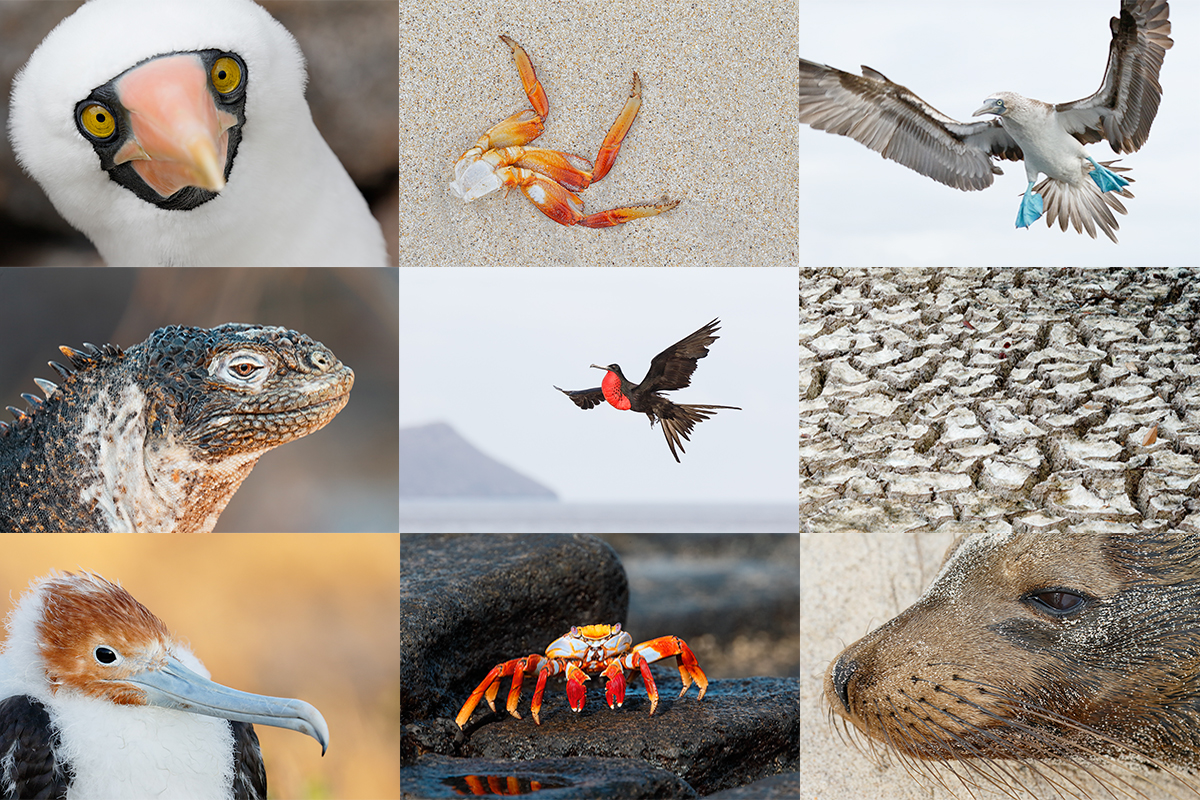
|
|
Do consider joining denise and me for this once in a lifetime trip to the Galapagos archipelago. There simply is no finer Galapagos photography trip. Learn why above.
|
An Amazing Value…
Do know that there are one week Galapagos trips for $8500! Thus, our trip represents a tremendous value; why go all that way and miss half of the great photographic locations?
The Logistics
August 6, 2017: We arrive a day early to ensure that we do not miss the boat.
August 7, 2017: There will be an introductory Galapagos Photography session and a hands on exposure session at our hotel.
August 8, 2017: We fly to the archipelago and board the Samba. Heck, on the 2015 trip some people made great images at the dock in Baltra while our luggage was being loaded!
August 22, 2017: We disembark late morning and fly back to Guayaquil midday; most will overnight there.
Most will fly home on the early morning of July 23 unless they are staying on or going elsewhere (or catching a red-eye flight on the evening of the 22nd).
$12,499 includes just about everything: all transfers, guide and park fees, all food on the boat, transfers and ground transportation, your flights to the archipelago, and three nights (double occupancy) in a top notch hotel in Guayaquil. If you are good to go, a non-refundable deposit of $5,000 per person is due immediately. The second payment of $4,000 is not due until 11/1/16. The final payment of $3449 per person will be due on 2/1/17. A $200 discount will be applied to each of the balances for couples or friends who register at the same time.
Purchasing travel insurance within 2 weeks of our cashing your deposit check is strongly recommended. On two fairly recent cruises a total of 5 folks were forced to cancel less than one week prior to the trip. My family and I use Travel Insurance Services and strongly recommend that you do the same.
Not included: your round trip airfare from your home to and from Guayaquil, beverages on the boat, phone calls, your meals in Guayaquil, personal items, and a $600/person cash tip for the crew and the guide—this works out to roughly $40/day to be shared by the 7 folks who will be waiting on us hand and foot every day for two weeks. The service is so wonderful that many folks choose to tip extra.
Please e-mail for the tentative itinerary or with questions. Please cut and paste “Galapagos 2017 Tentative Itinerary Please” into the Subject line.
Facebook
Be sure to like and follow BAA on Facebook by clicking on the logo link upper right. Tanks a stack!


Support the BAA Blog. Support the BAA Bulletins: Shop B&H here!
We want and need to keep providing you with the latest free information, photography and Photoshop lessons, and all manner of related information. Show your appreciation by making your purchases immediately after clicking on any of our B&H or Amazon Affiliate links in this blog post. Remember, B&H ain’t just photography!
Amazon.com
Those who prefer to support BAA by shopping with Amazon may click on the logo-link immediately above.
Amazon Canada
Many kind folks from north of the border, eh, have e-mailed stating that they would love to help us out by using one of our affiliate links but that living in Canada and doing so presents numerous problems. Now, they can help us out by using our Amazon Canada affiliate link by starting their searches by clicking here. Many thanks to those who have written.
Typos
In all blog posts and Bulletins, feel free to e-mail or to leave a comment regarding any typos or errors. Just be right :).
November 22nd, 2015 What’s Up?
The cold has gotten worse with a chafed runny nose, lots of loud sneezing, and some nasty congestion but I am still glad that I do not have a sore throat (knock on wood).
I prepared this blog post on the late afternoon of Saturday, NOV 21, 2015. We meet the first IPT group at 7pm tonight for an introductory program that includes a slide program. And then head out into the cold blackness early tomorrow morning.
Bosque IPT #2:Last Chance: $200 Late Registration Discount Offer!
Try Jim in the office on Monday to sign up for the last spot on the second Bosque IPT. We have room for either one photographer or for a couple. See the complete details here.
The BIRDS AS ART Blog and You
To show your appreciation for my efforts here, we do ask that you use our the B&H and Amazon affiliate links on the right side of the blog for all of your purchases. Doing so won’t cost you a penny and is the best way to thank me for the 15-20 hours I put in to bring you fresh and free educational material most every day. Please check the availability of all photographic accessories in the BIRDS AS ART Online Store. We sell only what I use and depend on. We will not sell you junk. We know what you need to make creating great images easy and fun. And we are always glad to answer your gear questions via e-mail (unless I am traveling without internet!)
You can find the following items in the store: Mongoose M3.6 and Wimberley heads, plates, low feet, and accessories, flash brackets, , Delkin e-film Pro Compact Flash Cards, LensCoat products, and our unique line-up of educational materials including ABP I & II, Digital Basics, Site and Set-up e-Guides, Canon and Nikon Camera Users and AF e-Guides, and MP-4 Photoshop video tutorials among others.
And we still have a few Gitzo tripods in stock. I imagine that we will be phasing those out soon….
I would of course appreciate your using our B&H affiliate links for all of your major gear, video, and electronic purchases. Please remember: web orders only! For the photographic stuff mentioned in the paragraph above we, meaning BAA, would of course greatly appreciate your business. Here is a huge thank you to the many who have been using our links on a regular basis and visiting the BAA Online store as well.
|
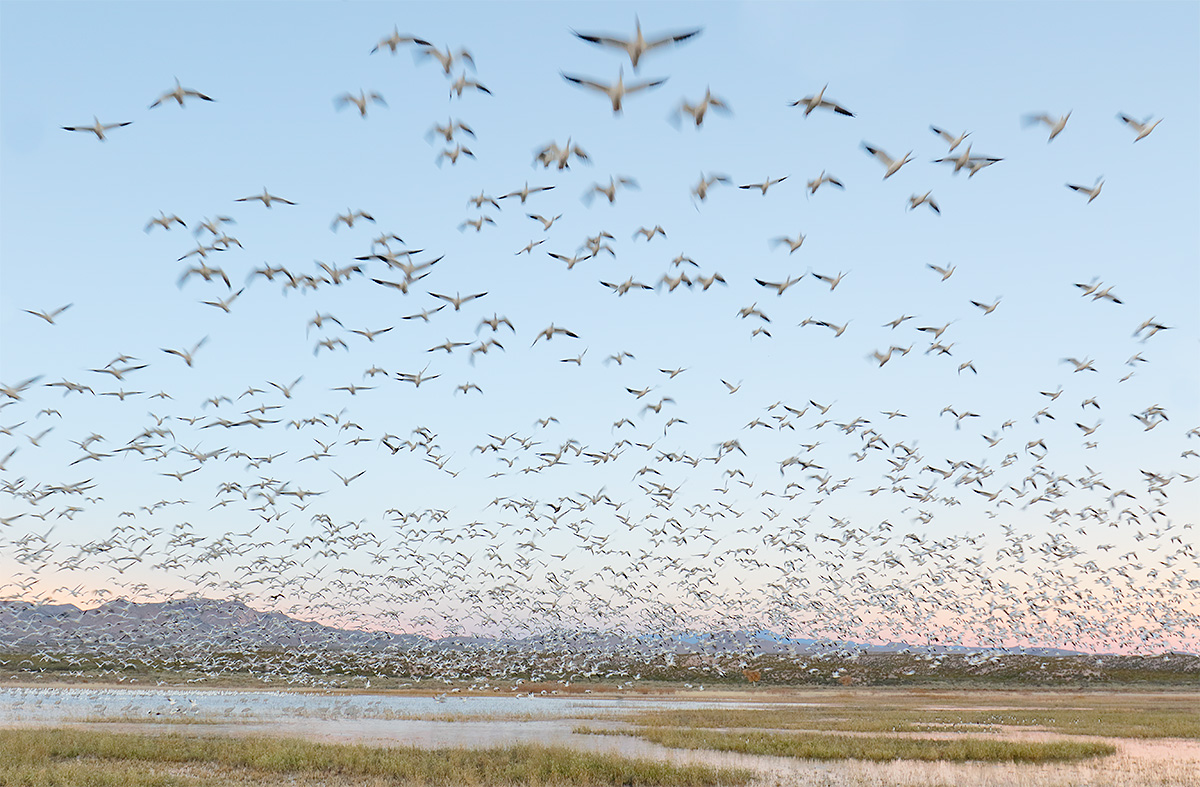
|
|
This image was created at at 6:44am on Saturday morning, November 21 at Bosque del Apache NWR with the hand held Canon EF 16-35mm f/4L IS USM lens (at 16mm) and the amazing Canon EOS 7D Mark II. ISO 400. Evaluative metering +1 1/3 stop: 1/60 sec. at f/5.6.
Center AF point/AI Servo Expand/Rear Focus AF as framed was active at the moment of exposure (as is always best when hand holding). Click here to see the latest version of the Rear Focus Tutorial. Click on the image to see a larger version.
Snow Goose Wide Angle Blast
|
Everyone Missed the Obvious Shot. But Me 🙂
We did quite well at the Main Impoundment with lots of birds and the first colorful sunrise of the season. Then we made the standard move. There were a thousand geese in the pond. As I faced north I felt a bit of a breeze on my right cheek. I knew what that meant. I had started the day with the 100-400 II/7D II combo on an RS-strap. When I saw the big gathering of geese and felt the wind slightly from the east I grabbed my second 7D II and mounted the 16-35 f/f4. That rig went on a second RS-7 strap. When I got to the pond I walked north to the front of the goose flock. I have already set both camera bodies to Tv mode at +1 1/3 stops. The geese had been taking off in groups of 3 or 4. I had barely gotten into position when the birds blasted off right at me.
There were probably more than 100 photographers all with super-telephoto lenses. There was not a single short lens in sight except for the one in my hands. The experience left me shaking my head as there were four or five supposedly top photographic leaders guiding groups for the Festival of the Cranes. I guess that they should have read the Bosque Site Guide.
The message here is the same as always: see the light and read the wind. Then get yourself in the right place and go to work.
|

|
|
Tame birds and wildlife. Incredible diversity. You only live once….
|
GALAPAGOS Photo Cruise of a Lifetime IPT/The Complete Galapagos Photographic Experience. August 8-22, 2017 on the boat. 13 FULL and two half-days of photography: $12,499. Limit: 12 photographers plus the two leaders: Denise Ippolito and yours truly. Openings: 8.
Same great trip; no price increase!
Four slots filled already; this trip needs nine to run; in the unlikely event that it does not, all payments to BAA will be refunded in full.
My two-week Galapagos Photo-Cruises are without equal. The world’s best guide, a killer itinerary, a great boat (the Samba), and two great leaders with ten Galapagos cruises under their belts. Pre-trip and pre-landing location-specific gear advice. In-the-field photo instruction and guidance. Jeez, I almost forgot: fine dining at sea!
The great spots that we will visit include Tower Island (including Prince Phillips Steps and Darwin Bay), Hood Island (including Punta Suarez, the world’s only nesting site of Waved Albatross, and Gardner Bay)—each of the preceding are world class wildlife photography designations that rank right up there with Antarctica, Africa, and Midway. We will also visit Fernandina, Puerto Ayora for the tortoises, Puerto Egas—James Bay, and North Seymour for nesting Blue-footed Boobies in most years, South Plaza for Land Iguanas, Floreana for Greater Flamingoes, and Urbina Bay, all spectacular in their own right. We visit every great spot on a single trip. Plus tons more. And there will be lots of opportunities to snorkel on sunny mid-days for those like me who wish to partake.
It is extremely likely that we will visit the incredible Darwin Bay and the equally incredible Hood Island, world home of Waved Albatross twice on our voyage. The National Park Service takes its sweet time in approving such schedule changes.
We will be the first boat on each island in the morning and the last boat to leave each island every afternoon. If we are blessed with overcast skies, we will often spend 5-6 hours at the best sites. And as noted above, mid-day snorkeling is an option on most sunny days depending on location and conditions. On the 2015 trip most snorkeled with a mega-pod of dolphins. I eased off the zodiac to find hundreds of dolphins swimming just below me. Note: some of the walks are a bit difficult but can be made by anyone if half way decent shape. Great images are possible on all landings with either a hand held 70-200mm lens and a 1.4X teleconverter or an 80- or 100-400. I bring a longer lens ashore on most landings as they better fit my style. I generally bring only one of these as my big lens: the Canon 300mm f/2.8L IS, the new Canon 400mm DO lens, or the Canon 200-400mm f/4 L IS with Internal Extender.
|

|
|
Do consider joining denise and me for this once in a lifetime trip to the Galapagos archipelago. There simply is no finer Galapagos photography trip. Learn why above.
|
An Amazing Value…
Do know that there are one week Galapagos trips for $8500! Thus, our trip represents a tremendous value; why go all that way and miss half of the great photographic locations?
The Logistics
August 6, 2017: We arrive a day early to ensure that we do not miss the boat.
August 7, 2017: There will be an introductory Galapagos Photography session and a hands on exposure session at our hotel.
August 8, 2017: We fly to the archipelago and board the Samba. Heck, on the 2015 trip some people made great images at the dock in Baltra while our luggage was being loaded!
August 22, 2017: We disembark late morning and fly back to Guayaquil midday; most will overnight there.
Most will fly home on the early morning of July 23 unless they are staying on or going elsewhere (or catching a red-eye flight on the evening of the 22nd).
$12,499 includes just about everything: all transfers, guide and park fees, all food on the boat, transfers and ground transportation, your flights to the archipelago, and three nights (double occupancy) in a top notch hotel in Guayaquil. If you are good to go, a non-refundable deposit of $5,000 per person is due immediately. The second payment of $4,000 is not due until 11/1/16. The final payment of $3449 per person will be due on 2/1/17. A $200 discount will be applied to each of the balances for couples or friends who register at the same time.
Purchasing travel insurance within 2 weeks of our cashing your deposit check is strongly recommended. On two fairly recent cruises a total of 5 folks were forced to cancel less than one week prior to the trip. My family and I use Travel Insurance Services and strongly recommend that you do the same.
Not included: your round trip airfare from your home to and from Guayaquil, beverages on the boat, phone calls, your meals in Guayaquil, personal items, and a $600/person cash tip for the crew and the guide—this works out to roughly $40/day to be shared by the 7 folks who will be waiting on us hand and foot every day for two weeks. The service is so wonderful that many folks choose to tip extra.
Please e-mail for the tentative itinerary or with questions. Please cut and paste “Galapagos 2017 Tentative Itinerary Please” into the Subject line.
Facebook
Be sure to like and follow BAA on Facebook by clicking on the logo link upper right. Tanks a stack!


Support the BAA Blog. Support the BAA Bulletins: Shop B&H here!
We want and need to keep providing you with the latest free information, photography and Photoshop lessons, and all manner of related information. Show your appreciation by making your purchases immediately after clicking on any of our B&H or Amazon Affiliate links in this blog post. Remember, B&H ain’t just photography!
Amazon.com
Those who prefer to support BAA by shopping with Amazon may click on the logo-link immediately above.
Amazon Canada
Many kind folks from north of the border, eh, have e-mailed stating that they would love to help us out by using one of our affiliate links but that living in Canada and doing so presents numerous problems. Now, they can help us out by using our Amazon Canada affiliate link by starting their searches by clicking here. Many thanks to those who have written.
Typos
In all blog posts and Bulletins, feel free to e-mail or to leave a comment regarding any typos or errors. Just be right :).
November 21st, 2015 Stuff
I was in bed by 8:30pm on Thursday night and not feeling too bad. I fell asleep in minutes as I usually do. I woke at 2:20am unable to breath through my nose at all; in just a few hours my congestion had become a full fledged head cold. I am grateful that I do not have a sore throat. In any case I tried unsuccessfully to get back sleep so I got up and went to work on the new Southern Ocean Photography Guide. I am, in fact, feeling pretty good despite my runny nose. It is 9:15am as I type in the car on the way to MCO flying from Orlando to Denver where I meet my friend and Bosque co-leader Denise Ippolito. From there we take the short flight to ABQ. Tomorrow morning we make an early morning scouting run to Bosque and then meet the first group after dinner. The first IPT is one-over-the-limit sold out.
I put the finishing touches on this blog post at the airport in Denver. I am not feeling too, too bad. 🙂
Bosque IPT #2: Next to Last Chance: $200 Late Registration Discount Offer!
Try Jim in the office on Monday to sign up for the last spot on the second Bosque IPT. We have room for either one photographer or for a couple. See the complete details here.
Selling Your Used Photo Gear Through BIRDS AS ART
Selling your used (or like-new) photo gear through the BAA Blog or via a BAA Online Bulletin is a great idea. We charge only a 5% commission. One of the more popular used gear for sale sites charges a minimum of 20%. Plus assorted fees! Yikes. The minimum item price here is $500 (or less for a $25 fee). If you are interested please e-mail with the words Items for Sale Info Request cut and pasted into the Subject line :). Stuff that is priced fairly–I offer free pricing advice, usually sells in no time flat. In the past few months, we have sold just about everything in sight. Do know that prices on some items like the EOS-1D Mark IV, the old Canon 500mm, the EOS-7D, and the original 400mm IS DO lens have been dropping steadily.
Used Gear Cautions
Though I am not in a position to post images of gear for sale here or elsewhere, prospective buyers are encouraged to request for photos of the gear that they are interested in purchasing via e-mail. Doing so will help to avoid any misunderstandings as to the condition of the gear. Sellers are advised to take care to photograph their used gear with care against clean backgrounds so that the stuff is represented accurately and in the best light; please pardon the pun :).
New Listings
Canon 500mm f/4L IS Lens (“the old five”)/Lowest-ever BAA Price for this item
Multiple IPT veteran Pat Fishburne is offering a used Canon 500mm f/4L IS Lens (“the old five”) in excellent condition for sale for only $3799, the lowest-ever BAA price for this item. The sale includes the lens trunk, a LensCoat, the ET-138 Hood, the big leather E-163 Lens Cover, the rear cap, a Wimberley P-40 lens plate, the lens manual, all originally included accessories, and insured shipping via FedEx Ground. Your item will not ship until your check clears unless other arrangements are made. Please contact Pat by e-mail or by phone at 919-593-0709 or 919-537-8006 (Eastern time zone). Photos available upon request.
As regular readers know the “old five” was the world’s most popular super telephoto lens for many years. I owned and used one for more than a decade. Pat’s lens is priced to sell immediately. artie
Canon 500mm f/4L IS Lens (“the old five”)/Lowest-ever BAA Price for this item
Multiple IPT veteran Stokes Fishburne is offering a used Canon 500mm f/4L IS Lens (“the old five”) in excellent condition for sale for only $3799, the lowest-ever BAA price for this item. The sale includes the lens trunk, a LensCoat, the ET-138 Hood, the big leather E-163 Lens Cover, the rear cap, a Wimberley P-40 lens plate, the lens manual, all originally included accessories, and insured shipping via FedEx Ground. Your item will not ship until your check clears unless other arrangements are made. Please contact Stokes by e-mail or by phone at 919-593-0709 or 919-537-8006 (Eastern time zone). Photos available upon request.
As regular readers know the “old five” was the world’s most popular super telephoto lens for many years. I owned and used one for more than a decade. Pat’s lens is priced to sell immediately. artie
Featured Item
Canon 200-400mm f/4L IS lens with Internal 1.4X Extender
Kenton Rowe is offering a used Canon 200-400mm with Internal 1.4X Extender in Very Good condition for $9,799. The sale includes the Canon PL-C 52mm drop-in Circular Polarizing filter (a $240 value), the Canon E-145C Lens Cap (actually a lens hood made of tough synthetic fabric, the rear lens cap, the ET-120 Lens Hood, the lens trunk, and insured shipping via UPS Ground. Your item will not ship until your check clears unless other arrangements are made.
Please contact Kenton via e-mail or by phone at 406.465.6707 (Mountain time).
The 200-400 is a killer lens when you are working with tame birds or large mammals; can you say the Galapagos and Africa, the Southern Ocean, or Florida? artie
|
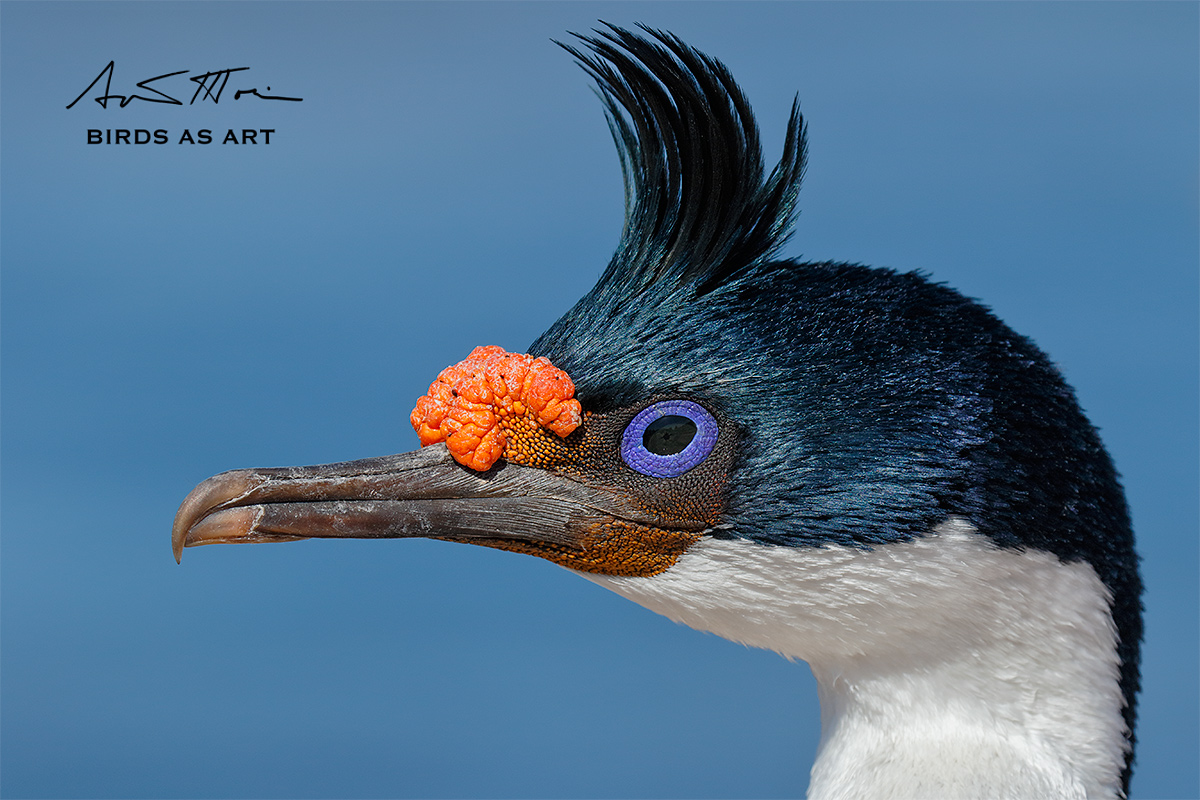
|
|
This image was created on Bleaker Island, the Falklands, with the hand held Canon EF 100-400mm f/4.5-5.6L IS II USM lens (at 401mm), the the Canon Extender EF 1.4X III, and the amazing Canon EOS 7D Mark II. ISO 400. Evaluative metering -1/3 stop: 1/1000 sec. at f/10.
Center AF point (by necessity at f/8)/AI Servo Expand/Rear Focus AF as framed was active at the moment of exposure (as is always best when hand holding). The center AF point was just forward of and above the bird’s eye. Click here to see the latest version of the Rear Focus Tutorial. Click on the image to see a larger version.
Image #1: King Cormorant in sun, head portrait
|
King Cormorant’s Many Aliases
The cormorants of the Southern Ocean can be a confusing group. In different locations the local names for what are actually different species are often the same. Many species have several or even many different common names. On top of all that you can throw in the fact that the scientists often re-classify the varies species sometimes lumping them into a large super-species comprised of various races and then a year or two later splitting them into distinct species each with a given set of characteristics that often include various DNA markers. Whatever the state of the scientific species mumbo jumbo, each then-agreed-upon species has it own distinct scientific (Latin) name that always includes both the genus name and the species name. Sometimes a subspecific Latin name is added to form a trinomial species name.
The bird in today’s featured image is most commonly called King Cormorant in the Falklands where both of today’s images were created. Others might know the bird as King Shag, Imperial Cormorant, Imperial Shag, Blue-eyed Cormorant or Blue-eyed Shag.
You get the picture 🙂 In any case, today’s bird is Phalacrocorax atriceps.
|
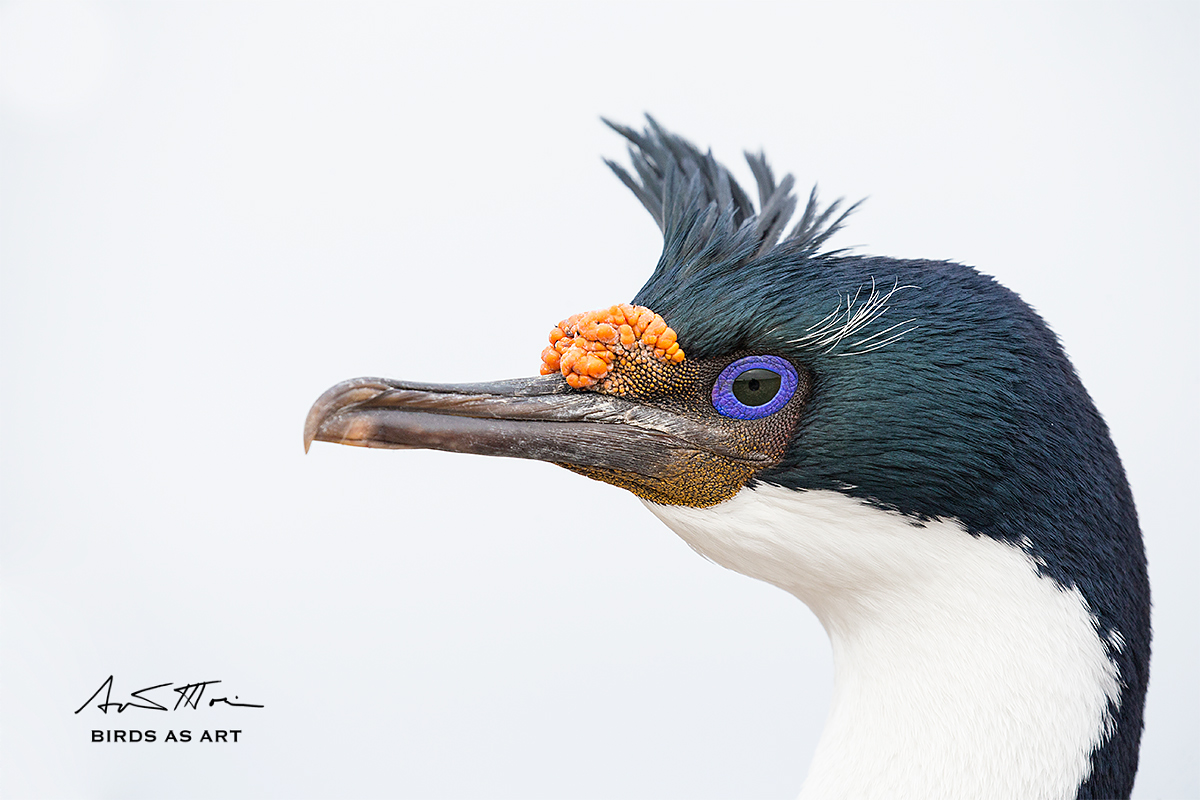
|
|
This image was created on Bleaker Island, the Falklands with the hand held Canon EF 100-400mm f/4.5-5.6L IS II USM lens (at 400mm) and the rugged professional body, the Canon EOS-1D X. ISO 800. Evaluative metering +2 stops as framed: 1/500 sec. at f/8 in Manual mode. Cloudy WB.
A single AF point (Manual selection) was two AF points to the right of the center AF point: AI Servo/Rear Focus AF as framed was active at the moment of exposure (as is always best when hand holding). The active AF point was right on the birds’s eye. Click here to see the latest version of the Rear Focus Tutorial. Click on the image to see a larger version.
Image #2: High key King Cormorant head portrait on white sky day.
|
King Cormorant: Sun versus White Sky
Please leave a comment and let us know if you like the bright sun version, Image #1, or the high key/white sky version, Image #2. And be sure to let us know why. Which image features the nicest light? Which image features the nicest pose?

Induro $50 Instant Rebate
The Induro $50 instant rebate will last only until the end of this year. Click on the logo-link above to save $50 on our favorite tripods. On our recent grueling trip to the Southern Ocean Denise loved her new GIT 304 and I love my new GIT 304L. Both performed flawlessly in the mud, snow and ice.
Induro GIT 404L Super Sale!
For a limited time only the Induro GIT 404L is being offered for the ridiculously low price of $470 (including the $50 instant rebate). The Induro GIT 404L is a 4-leg section Grand Series tripod. It is slightly bigger and one pound heavier than the GIT 304L; it is the perfect tripod for those using big glass who would like a bit more stability.

Gura Gear Backpack Blowout
I do not use a backpack. But many of my and denise’s clients who do have long raved about the Guru Gear backpacks. As have many professionals. These great photo backpacks are being phased out and will not be replaced in their present form. Take advantage of the huge price reductions on three popular models, the Bataflae 26L, the Bataflae 32L, and the Bataflae 18L, and enjoy a superbly high quality backpack that with its sturdy, high end zippers and durable fabric will serve you well for many years.
Facebook
Be sure to like and follow BAA on Facebook by clicking on the logo link upper right. Tanks a stack!


Support the BAA Blog. Support the BAA Bulletins: Shop B&H here!
We want and need to keep providing you with the latest free information, photography and Photoshop lessons, and all manner of related information. Show your appreciation by making your purchases immediately after clicking on any of our B&H or Amazon Affiliate links in this blog post. Remember, B&H ain’t just photography!
Amazon.com
Those who prefer to support BAA by shopping with Amazon may click on the logo-link immediately above.
Amazon Canada
Many kind folks from north of the border, eh, have e-mailed stating that they would love to help us out by using one of our affiliate links but that living in Canada and doing so presents numerous problems. Now, they can help us out by using our Amazon Canada affiliate link by starting their searches by clicking here. Many thanks to those who have written.
Typos
In all blog posts and Bulletins, feel free to e-mail or to leave a comment regarding any typos or errors. Just be right :).
November 20th, 2015 The Credit Line Signature…
Several folk have recently asked about my new signature. The short answer is that I have long been remiss about protecting my images. The rest is a long story that I will pass on for now. Thanks to denise ippolito for helping me create my signature brush. I am not sure but she may have a tutorial on how to do it somewhere on her blog here.
Enjoy the Blog?
Do you enjoy reading the blog? Do you learn something on most visits? Are you all set as far as gear goes? If yes to all of those, please consider making a BAA Blog Thank You Donation by clicking here. And if you do need some new gear, please use my affiliate links, most especially, the B&H affiliate logo link just to the right of this text. Simply click and begin your search and shopping spree :). Note: web orders only. Also, there will be no indication that your purchases will be tracked to BAA. The tracking is invisible. That’s why we ask folks to send us their B&H receipts for major purchases via e-mail. Please remember: no phone orders…. Many thanks for considering these requests. a
ps: think that I am being too cheeky? I put in about 15 to 30 hours per week on the blog; it is my part time job 🙂
What’s Up?
I began work on this blog post somewhere in the Southern Ocean. As I finished it up on Thursday morning, my relapse-cold has gotten a bit worse with the addition of some nasal congestion 🙂 Once this is finished I will start packing. Tomorrow I fly to Bosque.
Bosque #2
With just two openings left, we are raising the later registration discount to $200. See yesterday’s blog post for details. Then call Jim or Jen in the office at 863-692-0906 tomorrow to register. Time is short. And so is life 🙂

Induro $50 Instant Rebate
The Induro $50 instant rebate will last only until the end of this year. Click on the logo-link above to save $50 on our favorite tripods. On our recent grueling trip to the Southern Ocean Denise loved her new GIT 304 and I love my new GIT 304L. Both performed flawlessly in the mud, snow and ice.
Induro GIT 404L Super Sale!
For a limited time only the Induro GIT 404L is being offered for the ridiculously low price of $370 (including the $50 instant rebate). The Induro GIT 404L is a 4-leg section Grand Series tripod. It is slightly bigger and one pound heavier than the GIT 304L; it is the perfect tripod for those using big glass who would like a bit more stability.

Gura Gear Backpack Blowout
I do not use a backpack. But many of my and denise’s clients who do have long raved about the Guru Gear backpacks. As have many professionals. These great photo backpacks are being phased out and will not be replaced in their present form. Take advantage of the huge price reductions on three popular models, the Bataflae 26L, the Bataflae 32L, and the Bataflae 18L, and enjoy a superbly high quality backpack that with its sturdy, high end zippers and durable fabric will serve you well for many years.
|
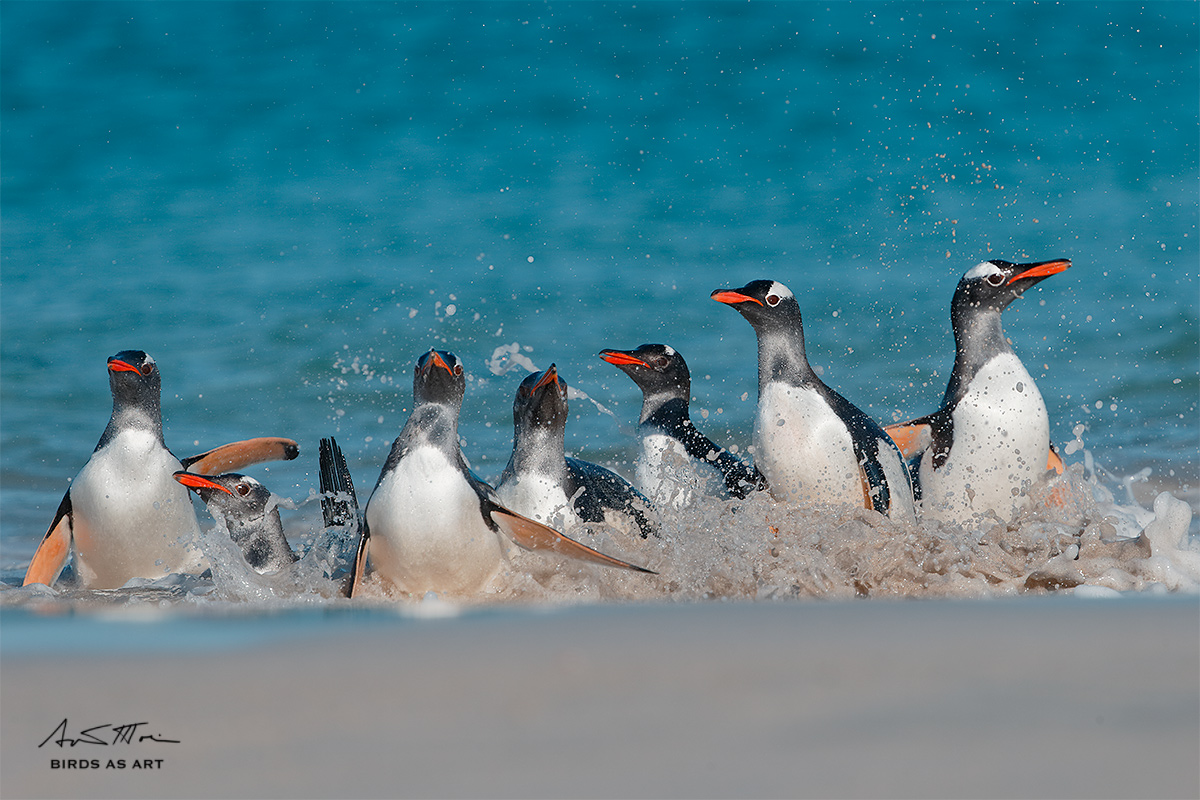
|
|
This image was created on Bleaker Island, on our first-ever land-based Falklands tour, with the Induro tripod/Mongoose M3.6 -mounted Canon EF 400mm f/4 DO IS II USM lens, the Canon Extender EF 1.4X III, and the rugged professional body, the Canon EOS-1D X. ISO 640. Evaluative metering at zero: 1/2500 sec. at f/7.1 in Manual mode. AWB WB.
Center AF point/AI Servo Expand/Rear Focus AF as originally framed was active at the moment of exposure. Click here to see the latest version of the Rear Focus Tutorial. Click on the image to see a larger version.
Image #1: Group of Gentoo Penguins emerging from surf
|
Emerging Gentoo Penguins
Though it was the afternoon of our first full day both denise and I knew exactly where we needed to be. We sat in the soft sand and watched as hundreds of gentoos emerged from the surf after a few hours of foraging for krill (if foraging is the correct word….) We carefully went over the details of exposure and AF point selection with Billie and Brian Snell.
Depth-of-Field
As originally framed, the active AF point fell on the neck band of the third penguin from your right. This bird was back a bit from the others in the group. Why were all the bird’s rendered sharp at the relatively wide aperture of f/7.1?
|
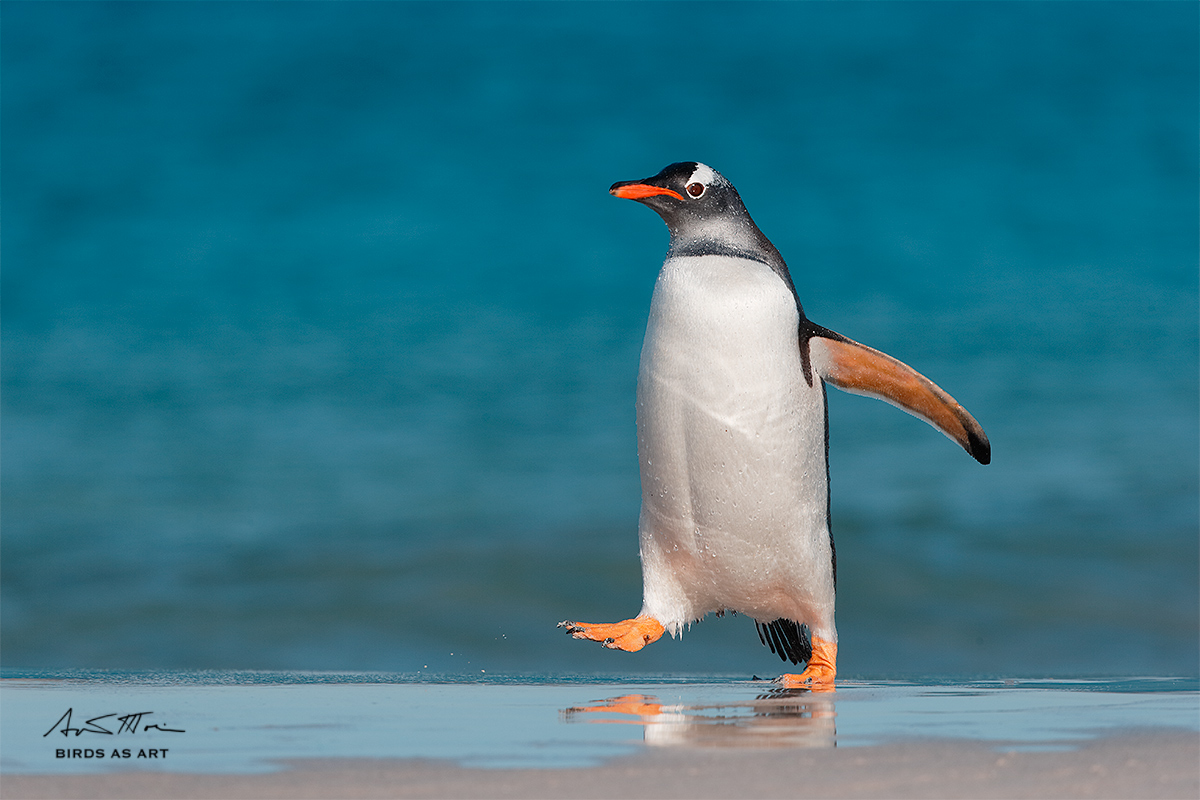
|
|
This image was also created on Bleaker Island, on our first-ever land-based Falklands tour, with the Induro tripod/Mongoose M3.6 -mounted Canon EF 400mm f/4 DO IS II USM lens, the Canon Extender EF 1.4X III, and the rugged professional body, the Canon EOS-1D X. ISO 640. Evaluative metering at zero: 1/2500 sec. at f/7.1 in Manual mode. AWB WB.
Center AF point/AI Servo Expand/Rear Focus AF as originally framed was active at the moment of exposure. Click here to see the latest version of the Rear Focus Tutorial. Click on the image to see a larger version.
Image #2: Striding Gentoo Penguin emerging from surf
|
AI Servo Compositional Tip: Leading the subject…
When you are using center AF point Expand or Surround AI Servo AF to track a subject and the bird is moving from one side of the frame to the other, you can often effectively move the bird back in the frame without having to manually move the active AF point by trying the following: acquire AF with the active AF point squarely on the subject (and preferably on a spot with sufficient contrast to allow AF to function efficiently); pan with the moving subject doing your best to match your panning rate with the speed of the subject; and finally, just as you anticipate the perfect image speed up your pan just a bit so that you are panning a bit faster than the subject is moving and release the shutter button just before the AF system begins to search for the background. At times one of the assist points may grab the edge of the subject while at other times no active AF point is on the subject at the moment of exposure.
The idea, as seen in the image immediately above, is to move the bird back just a bit in the frame so that you wind up with a more pleasing composition. As always, practice improves results.
|
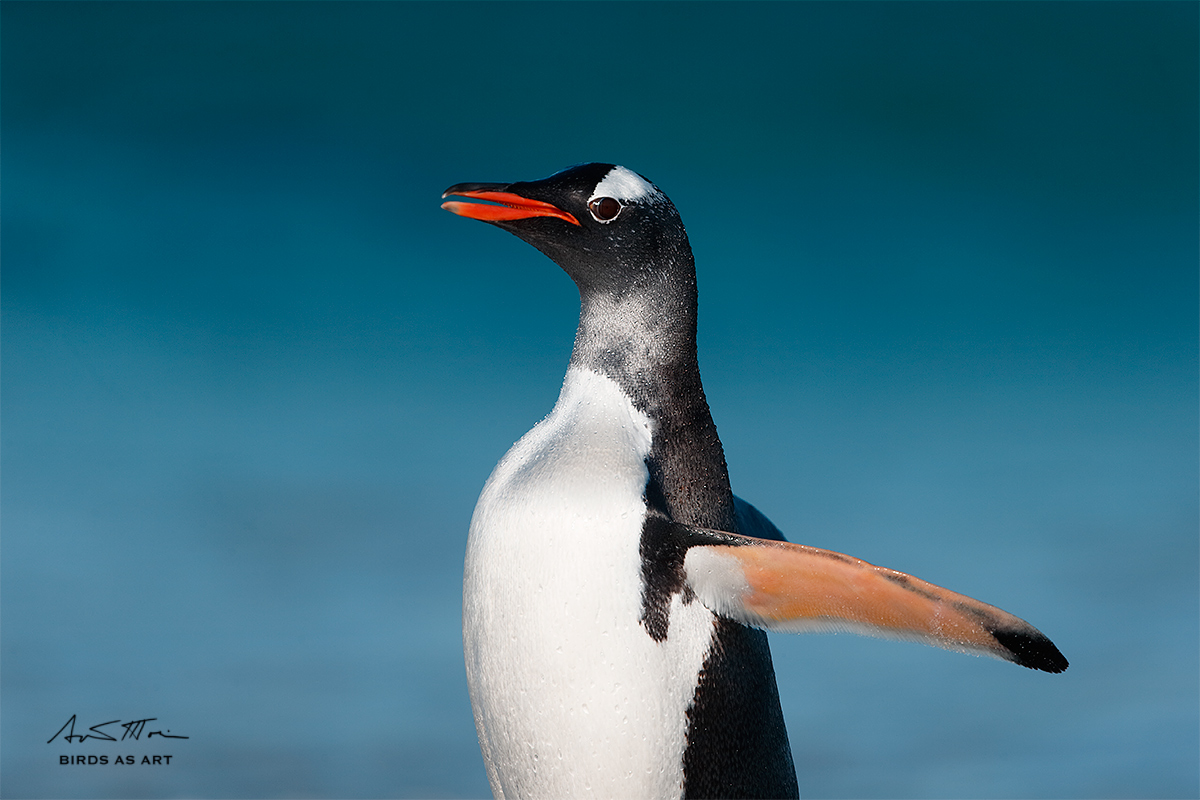
|
|
This image too was created on Bleaker Island, on our first-ever land-based Falklands tour, with the Induro tripod/Mongoose M3.6 -mounted Canon EF 400mm f/4 DO IS II USM lens, the Canon Extender EF 1.4X III, and the rugged professional body, the Canon EOS-1D X. ISO 640. Evaluative metering at zero: 1/2500 sec. at f/6.3 in Manual mode. AWB WB.
Center AF point/AI Servo Expand/Rear Focus AF as originally framed was active at the moment of exposure. Click here to see the latest version of the Rear Focus Tutorial. Click on the image to see a larger version.
Image #3: Tight image of flapping Gentoo Penguin emerging from surf
|
Worth a Try…
At times, the gentoos would walk by right in front of us on their way bak to the colony–right down sun angle–with a nice blue ocean background. In this situation, I tried getting some images of the upper half of their body with the wings raised. In this image, I succeeded to some degree.
Could have been better…
What was the only thing about Image #3 that disappointed me?
Why Not?
Why would Image #3 not have worked as a vertical?
Working a Situation
Note that all three of today’s featured images were of Gentoo Penguins, were made in similar lighting conditions, and were made with the same focal length: 560mm. Yet each image is distinctly different. In fact, one might say that the only thing similar about the three is the subject.
Zoom lenses are often a great help when it comes to working a subject or a situation, but the same can me done with a fixed focal length by working birds at different distances or by changing your position–the latter know as human zoomin’. Many times when we are teaching we will ask to see a student’s images on their rear LCD. We are always amazed when folks show us a single image of this flower or a single image or that bird… When you are in a great place (or in your backyard as well) resist the urge to take one image of a given subject and think, “I got it.” Learn to work a situation, to work the subject. Explore different distances and different perspectives. And be sure to make lots of images.
Facebook
Be sure to like and follow BAA on Facebook by clicking on the logo link upper right. Tanks a stack!


Support the BAA Blog. Support the BAA Bulletins: Shop B&H here!
We want and need to keep providing you with the latest free information, photography and Photoshop lessons, and all manner of related information. Show your appreciation by making your purchases immediately after clicking on any of our B&H or Amazon Affiliate links in this blog post. Remember, B&H ain’t just photography!
Amazon.com
Those who prefer to support BAA by shopping with Amazon may click on the logo-link immediately above.
Amazon Canada
Many kind folks from north of the border, eh, have e-mailed stating that they would love to help us out by using one of our affiliate links but that living in Canada and doing so presents numerous problems. Now, they can help us out by using our Amazon Canada affiliate link by starting their searches by clicking here. Many thanks to those who have written.
Typos
In all blog posts and Bulletins, feel free to e-mail or to leave a comment regarding any typos or errors. Just be right :).
|
|







































































